1.Euclid's division lemma
Chapter 1: Real Numbers
Euclids Division Lemma
What is a dividend? Let us understand it with the help of a simple example. Can you divide 14 by 6?
![]()
After division, we get 2 as the quotient and 2 as the remainder.
Thus, we can also write 14 as 6 × 2 + 2.
A dividend can thus be written as:
Dividend = Divisor × Quotient + Remainder
Can you think of any other number which, when multiplied with 6, gives 14 as the dividend and 2 as the remainder?
Let us try it out with some other sets of dividends and divisors.
(1) Divide 100 by 20: 100 = 20 × 5 + 0
(2) Divide 117 by 15: 117 = 15 × 7 + 12
(3) Divide 67 by 17: 67 = 17 × 3 + 16
Thus, if we have a dividend and a divisor, then there will be a unique pair of a quotient and a remainder that will fit into the above equation.
This brings us to Euclid’s division lemma.
If a and b are positive integers, then there exist two unique integers, q and r,
such that a = bq + r
This lemma is very useful for finding the H.C.F. of large numbers where breaking them into factors is difficult. This method is known as Euclid’s Division Algorithm.
Let us look at some more examples.
Example 1: Find the H.C.F. of 4032 and 262 using Euclid’s division algorithm.
Solution:
Step 1:
First, apply Euclid’s division lemma on 4032 and 262.
4032 = 262 × 15 + 102
Step 2:
As the remainder is non-zero, we apply Euclid’s division lemma on 262 and 102.
262 = 102 × 2 + 58
Step 3:
Apply Euclid’s division lemma on 102 and 58.
102 = 58 × 1 + 44
Step 4:
Apply Euclid’s division lemma on 58 and 44.
58 = 44 × 1 + 14
Step 5:
Apply Euclid’s division lemma on 44 and 14.
44 = 14 × 3 + 2
Step 6:
Apply Euclid’s division lemma on 14 and 2.
14 = 2 × 7 + 0
In the problem given above, to obtain 0 as the remainder, the divisor has to be taken as 2. Hence, 2 is the H.C.F. of 4032 and 262.
Note that Euclid’s division algorithm can be applied to polynomials also.
Example 2: A rectangular garden of dimensions 190 m × 60 m is to be divided in square blocks to plant different flowers in each block. Into how many blocks can this garden be divided so that no land is wasted?
Solution:
If we do not want to waste any land, we need to find the largest number that completely divides both 190 and 60 and gives the remainder 0, i.e., the H.C.F. of (190, 60).
To find the H.C.F., let us apply Euclid’s algorithm.
190 = 60 × 3 + 10
60 = 10 × 6 + 0
Therefore, the H.C.F. of 190 and 60 is 10.
Therefore, there will be![]()

Hence, the total number of blocks in the garden will be 19 × 6 = 114.
Example 3: Find the H.C.F. of 336 and 90 using Euclid’s division algorithm.
Solution:
As 336 > 90, we apply the division lemma to 336 and 90.
336 = 90 × 3 + 66
Applying Euclid’s division lemma to 90 and 66: 90 = 66 × 1 + 24
Applying Euclid’s division lemma to 66 and 24:
66 = 24 × 2 + 18
Applying Euclid’s division lemma to 24 and 18:
24 = 18 × 1 + 6
Applying Euclid’s division lemma to 18 and 6:
18 = 6 × 3 + 0
As the remainder is zero, we need not apply Euclid’s division lemma anymore. The divisor (6) is the required H.C.F.
Example 4: Find the H.C.F. of 45, 81, and 117 using Euclid’s division algorithm.
Solution:
Let us begin by choosing any two out of the three given numbers, say 45 and 81. As 81 > 45, we apply Euclid’s division lemma to 81 and 45.
81 = 45 × 1 + 36
Applying Euclid’s division lemma to 45 and 36:
45 = 36 × 1 + 9
Applying Euclid’s division lemma to 36 and 9:
36 = 9 × 4 + 0
As the remainder is zero, the H.C.F. of 45 and 81 is 9.
Now, we again need to apply Euclid’s division algorithm on the H.C.F. of the two numbers and the remaining number.
Since the H.C.F. of 45 and 81 is 9 and the third number is 117, we apply Euclid’s division lemma to 117 and 9.
117 = 9 × 13 + 0
As the remainder is zero, the H.C.F. of 9 and 117 is 9.
Here, the second H.C.F. (the H.C.F. of the H.C.F. of the first two numbers and the third number) is the H.C.F. of the three numbers.
Thus, we can say that the H.C.F. of the three numbers is 9.
Example 5: In an inter-school essay writing competition, the numbers of participants from schools A, B, and C are 20, 16, and 28 respectively. If the participants in each room are from the same school, then find the minimum number of rooms required such that each room has the same number of participants.
Solution:
If we need to find the minimum number of rooms, then we need to keep the maximum number of participants in each room i.e., we need to find the largest number that completely divides 20, 16, and 28.
Thus, we start by choosing any two out of the given three numbers, say 20 and 16. Applying Euclid’s division lemma to 20 and 16:
20 = 16 × 1 + 4
Applying Euclid’s division lemma to 16 and 4:
16 = 4 × 4 + 0
Hence, 4 is the H.C.F. of 20 and 16.
Applying Euclid’s division algorithm to 28 and 4:
28 = 4 × 7 + 0
Hence, 4 is the H.C.F. of 28 and 4.
∴H.C.F. of 20, 16, 28 = 4
Therefore, each room would have 4 participants.
The number of rooms in which the participants from schools A, B, and C can be
accommodated is 


Therefore, a total of 5 + 4 + 7 =16 rooms are required.
The Use Of Euclids Division Lemma To Prove Mathematical Relationships
We can thus write this rule about the dividend as
This expression is unique, i.e., whenever we divide an integer (dividend) by another integer (divisor), we always get a fixed quotient and a fixed remainder.
The above statement can be proven by taking an example.
Whenever we divide 54 by 11, we will get 4 as the quotient and 10 as the remainder. We will never get a quotient other than 4 and a remainder other than 10 when we divide 54 by 11.
This brings us to Euclid’s division lemma.

This lemma has several applications, one of which is to prove mathematical relationships among numbers.
Let us discuss this concept with the help of a few examples.
Example 1: Prove that every positive integer is of the form 3p, 3p + 1, or 3p + 2, where p is any integer.
Solution:
Let a be any positive integer and let b = 3.
Applying Euclid’s algorithm to a and 3:
a = 3p + r; for some integer p and 0 ≤ r < 3
Therefore, a can be 3p, 3p + 1, or 3p + 2.
As a is a positive integer, we can say that any positive integer is of the form 3p, 3p + 1, or 3p + 2.
Example 2: Prove that every positive even integer is of the form 2m and every positive odd integer is of the form 2m + 1, where m is any integer.
Solution:
Let a be any positive integer and let b = 2.
According to Euclid’s division lemma, there exist two unique integers m and r such that
a = bm + r = 2m + r, where 0 ≤ r < 2. Thus, r = 0 or 1
If r = 0, i.e., if a = 2m, then the expression is divisible by 2. Thus, it is an even number.
If r = 1, i.e., if a = 2m + 1, then the expression is not divisible by 2. Thus, it is an odd number.
Thus, every positive even integer is of the form 2m and every positive odd integer is of the form 2m + 1.
Example 3: Prove that the expression y(y + 1) always represents an even number, where y is any positive integer.
Solution:
Let y be an integer. Thus, it may be either odd or even.
When y is an odd number, i.e., when y is of the form 2p + 1, where p is an integer:
y(y + 1) = (2p + 1)(2p + 1 + 1) = (2p + 1)(2p + 2) = 2(2p + 1)(p + 1)
The above expression is a multiple of 2. Thus, the expression y(y + 1) represents an even number.
When y is an even number, i.e., when y is of the form 2q, where q is an integer:
y(y + 1) = (2q)(2q + 1) = 2q(2q + 1)
The above expression is a multiple of 2. Thus, the expression y(y + 1) represents an even number.
Thus, for a positive integer y, the expression y(y + 1) always represents an even number.
Example 4:
Show that
(a) The sum, the difference, and the product of two even numbers is always even.
(b) The sum and the difference of two odd numbers is always even, whereas their product is always odd.
Solution:
(a) Let there be two even numbers, x and y, such that x = 2m and y = 2n, where m and n are two positive integers.
Now, x + y = 2m + 2n = 2(m + n) = 2p, where p = m + n is an integer. Thus, x + y is always even.
Similarly, x − y = 2m − 2n = 2(m − n) = 2q, where q = m − n is an integer. Thus, x − y is always even.
Likewise, xy = 2m × 2n = 4mn = 2(2mn) = 2t, where t = 2mn is an integer. Thus, xy is always even.
Hence, the sum, the difference, and the product of two even numbers is always even.
(b) Let there be two odd numbers x and y such that x = 2m + 1 and y = 2n + 1, where m and n are two positive integers.
Now, x + y = (2m + 1) + (2n + 1) = 2(m + n + 1) = 2p, where p = m + n + 1 is an integer. Thus, x + y is even.
Similarly, x − y = (2m + 1) − (2n + 1) = 2(m − n) = 2q, where q = m − n is an integer.
Thus, x − y is even.
Likewise, xy = (2m + 1)(2n + 1) = 2(2mn + m + n) + 1 = 2t + 1, where t = 2mn + m + n is an integer.
Thus, xy is always odd.
Hence, the sum and the difference of two odd numbers is always even, whereas their product is always odd.
2.Arithmetic Fundamental Theorem
Prime Factorisation of Numbers Using Fundamental Theorem of Arithmetic
We know that all composite numbers can be represented as the product of two or more prime numbers. Let us understand this concept by taking the example of 36 and factorising it in different ways.
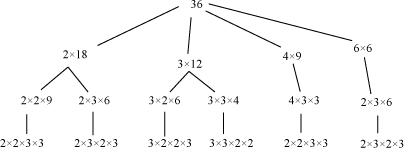
We can see that whichever way we factorise the number 36, it will be broken down as the product of the same prime numbers, which is unique. The only difference is that the ordering of the prime numbers will be different for different ways of factorising the number. In fact, this is true for all numbers. We can check this by taking the example of a larger number, say 21560, which can be uniquely broken down into its prime factors as
23 × 5 × 72 × 11
Hence, we can say that any composite number can be written in the form of the product of prime numbers, which is unique, except the order in which they occur. By this, we mean that 2 × 3 × 7 × 11 is the same as 7 × 11 × 2 × 3.
This is the fundamental theorem of arithmetic. It can be formally stated as:

Thus, this theorem can be used to write the prime factorisation of any number. Let us try to build on this concept with the help of some examples.
Example 1:
Write the prime factorization of 31250. What are its prime factors? Solution:
31250 = 2 × 15625
= 2 × 5 × 3125
= 2 × 5 × 5 × 625
= 2 × 5 × 5 × 5 × 125
= 2 × 5 × 5 × 5 × 5 × 25
= 2 × 5 × 5 × 5 × 5 × 5 × 5
= 2 × 56
Hence, 2 × 56 is the prime factorisation of 31250. Its prime factors are 2 and 5.
Example 2: If it is given that 13125 = 2a ×3b× 5c× 7d, then find the value of a +2b +7c + 11d.
Solution:
2a × 3b × 5c × 7d = 13125
= 3 × 4375
= 3 × 5 × 875
= 3 × 5 × 5 ×175
= 3 × 5 × 5 × 5 × 35
= 3 × 5 × 5 × 5 × 5 × 7
= 31 × 54 × 71
∴ 2a × 3b × 5c × 7d = 20 × 31 × 54 × 71
Comparing exponents of the bases (integers): a = 0, b = 1, c = 4, and d =1
Hence, a +2b +7c +11d = 0 + 2 ×1 + 7 × 4 + 11 × 1
= 0 + 2 + 28 + 11
= 41
Example 3: Show that the expressions given below are composite numbers.
(a) 3 × 5 × 7 × 23 + 2 × 7 × 11 × 13
(b) 29 × 35 + 14
(c) 34 + 63
Solution:
(a) 3 × 5 × 7 × 23 + 2 × 7 × 11 × 13 = 7( 3 × 5 × 23 + 2 × 11 × 13)
= 7(345 + 286)
= 7 × 631
Since both 7 and 631 are prime numbers, we have expressed the given expression as the product of two prime numbers. We know that according to the fundamental theorem of arithmetic, every composite number can be uniquely written as the product of its prime factors. Thus, the given expression represents a composite number.
(b) 29 × 35 + 14 = 29 × 5 × 7 + 2 × 7
= 7(29 × 5 + 2)
= 7 × 147
= 7 × 3 × 7 × 7
= 3 × 73
Since both 3 and 7 are prime numbers, we have expressed the given expression as the product of its prime factors. We know that according to the fundamental theorem of arithmetic, every composite number can be uniquely written as the product of its prime factors. Thus, the given expression represents a composite number.
(c) 34 + 63 = 34 + (2 × 3) 3
= 34 + 23 × 33
= 33(3 + 23)
= 33 × 11
Since both 3 and 11 are prime numbers, we have expressed the given expression as the product of its prime factors. It is known that according to the fundamental theorem of arithmetic, every composite number can be uniquely written as the product of its prime factors. Thus, the given expression represents a composite number.
Application Of The Fundamental Theorem Of Arithmetic To Find The HCF And LCM Of Numbers
All composite numbers can be written as the product of two or more prime numbers. For example, 20 can be written as 22 × 5; 54 can be written as 2 × 33, and so on.
Note that if we do not consider the way in which the prime factors are written, then we can prime factorise every number in only one way. This applies to other numbers as well.
This leads to the fundamental theorem of arithmetic, which states that:

Even though we did not notice it before, whenever we prime factorise a number, we use the fundamental theorem of arithmetic to do so.
For example, the prime factorisation of 980 is represented as
980 = 2 × 490
= 2 × 2 × 245
= 2 × 2 × 5 × 49
= 2 × 2 × 5 × 7 × 7
= 22 × 51 × 72
Hence, 22 × 51 × 72 is the prime factorisation of 980; and 2, 5, and 7 are its prime factors.
By applying the fundamental theorem of arithmetic to the prime factorized numbers, we can also find their HCF and LCM.
This is known as the prime factorisation method, which states that:

Let us understand this method with the help of some examples.
Example 1: Find the LCM and the HCF of 432 and 676 using the prime factorization method.
Solution:
We can write these numbers as
432 = 24 × 33
676 = 22 × 132
To calculate the HCF
We observe that the only common prime factor is 2 and the smallest power of this prime factor is also 2.
Thus, HCF (432, 676) = 22 = 4
To calculate the LCM
We observe that the prime factors of 432 and 676 are 2, 3, and 13. The greatest powers of these factors are 4, 3, and 2 respectively.
LCM is the product of the greatest power of each prime factor.
Thus, LCM (432, 676) = 24 × 33 × 132 = 73008
Example 2: Find the HCF and the LCM of 28, 42, and 64 using the prime factorization method.
Solution:
We can write these numbers as
28 = 22 × 71
42 = 2 × 31 × 71
64 = 26
HCF is the product of the smallest power of each common prime factor. Here, the only common prime factor is 2 and its power is 1.
Thus, HCF (28, 42, 64) = 21 = 2
LCM is the product of the greatest power of each prime factor. Thus, LCM (28, 42, 64) = 26 × 31 × 71 = 1344
Example 3: Find the HCF and the LCM of 1080 and 900 using the prime factorization and show that HCF × LCM = Product of two numbers.
Solution:
1080 = 23 × 33 × 5
900 = 22 × 32 × 52
Hence, HCF (1080, 900) = 22 × 32 × 5 = 180
LCM (1080, 900) = 23 × 33 × 52 = 5400
HCF × LCM = 180 × 5400 = 972000
Product of numbers = 1080 × 900 = 972000
Hence, HCF × LCM = Product of two numbers
Example 4: The HCF of 273 and another number is 7, while their LCM is 3003. Find the other number.
Solution:
Let the first number (a) be 273 and the second number be b.
It is given that HCF (a, b) = 7 and LCM (a, b) = 3003.
We know that HCF  LCM = Product of two numbers.
LCM = Product of two numbers.
⇒ HCF (a, b) × LCM (a, b) = a × b
⇒ 7 × 3003 = 273 × b

⇒ b = 77
Hence, the other number is 77.
Example 5: Anurag takes 6 minutes to complete one round of jogging around the circular track of a park, while Twinkle takes 8 minutes to do the same. If both of them start jogging at the same time from the same point, then how much time will they take before they meet at the point from which they started?
Solution:
Since Anurag and Twinkle take 6 minutes and 8 minutes respectively to complete one round of the circular track, the time after which they will meet at the starting point will be the lowest multiple of 6 and 8, i.e., their LCM.
6 = 2 × 3
8 = 23
∴ LCM (6, 8) = 23 × 3 = 24
Thus, they will meet at the starting point after 24 minutes.
Example 6: There are 120 students in a class. When the students were arranged according to their roll numbers, it was observed that every second student got distinction in Mathematics, every third student got distinction in Science, and every fifth student got distinction in English. How many students got distinction in all three subjects?
Solution:
As every second, third, and fifth student got distinction in Math, Science, and English respectively, the roll numbers of the students who got distinction in all three subjects will be equal to the multiples of the LCM of 2, 3, and 5.
LCM (2, 3, 5) = 2 × 3 × 5 = 30
Thus, every 30th student got distinction in all three subjects.
Thus, a total of  students got distinction in all three subjects.
students got distinction in all three subjects.
Properties Of Prime Numbers
Consider the number 8n, where n is a natural number.
Is there any value of n for which 8n ends with zero?
It is difficult to answer this question directly. However, we can answer this question by making use of the fundamental theorem of arithmetic. It states that

This means that if we are given a composite number, then that number can be written as a product of prime numbers in only one way (except for the order of prime numbers).
For example: the composite number 255 can be written as the product of primes as follows. 255 = 3 × 5 × 17
Also, 255 can be written as 3 × 17 × 5 or 5 × 3 × 17 or 5 × 17 × 3 or 17 × 3 × 5 or 17 × 5 × 3.
Thus, we can see that 255 can be expressed as a product of unique prime numbers 3, 5, and 17 but the order of representation may differ.
Now, by making use of the above theorem, we can answer the question which we were discussing in the beginning. Let us see how.
Suppose the number 8n ends with zero for some value of n. Since the number ends with zero, it should be divisible by 10. Now, 10 = 2 × 5
Thus, this number should be divisible by 2 and 5 also.
Therefore, the prime factorization of 8n should contain both the prime numbers 2 and 5. We have, 8n = (23)n = 23n
⇒ The only prime in the factorization of 8n is 2.
Thus, by fundamental theorem of arithmetic, there is no other prime in the factorization of 8n.
Hence, there is no natural number n for which 8n ends with the digit zero. In this way, we can make use of the above theorem.
Let us now look at some more examples to understand this concept better.
Example 1: Prove that the number 9n, where n is a natural number, cannot end with a zero.
Solution:
Suppose the number 9n ends with a zero for some value of n.
Since the number ends with zero, it should be divisible by 10.
Now, 10 = 2 × 5
Thus, this number should be divisible by 2 and 5 also.
Therefore, the prime factorization of 9n should contain both the prime numbers 2 and 5.
We have, 9n = (32)n = 32n
⇒ The only prime in the factorization of 9n is 3.
Thus, by fundamental theorem of arithmetic, there is no other prime in the factorization of 9n.
Hence, there is no natural number n for which 9n ends with the digit zero.
Example 2: Check whether the numbers 49n, where n is a natural number, can end with a zero.
Solution:
Suppose the number 49n ends with a zero for some value of n.
Since the number ends with zero, it should be divisible by 10.
Now, 10 = 2 × 5
Thus, this number should be divisible by 2 and 5 also.
Therefore, the prime factorization of 49n should contain both the prime numbers 2 and 5. We have, 49n = (72)n = 72n
⇒ The only prime in the factorization of 49n is 7.
Thus, by fundamental theorem of arithmetic, there is no other prime in the factorization of 49n.
Thus, there is no natural number n for which 49n ends with the digit zero.
3.Irrational and Rational Numbers
Irrational Numbers
We know that a number which cannot be written in the form of , where p and q are integers and q ≠ 0, is known as an irrational number.
where p and q are integers and q ≠ 0, is known as an irrational number.
For example: all numbers of the form , where p is a prime number such as etc.,
where p is a prime number such as etc.,  are irrational numbers.
are irrational numbers.
How can we prove that these are irrational numbers?
We can prove this by making use of a theorem which can be stated as follows.
“If p divides a2, then p divides a (where p is a prime number and a is a positive integer)”.
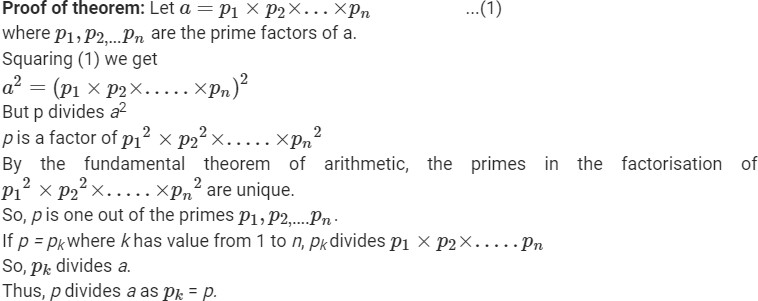
So go through the given video to understand the application of the above stated property.
Similarly, we can prove that square roots of other prime numbers like , etc. are irrational numbers.
etc. are irrational numbers.
Besides these irrational numbers, there are some other irrational numbers like etc.
We can also prove why these numbers are irrational. Before this, let us first see what happens to irrational numbers, when we apply certain mathematical operations on them.
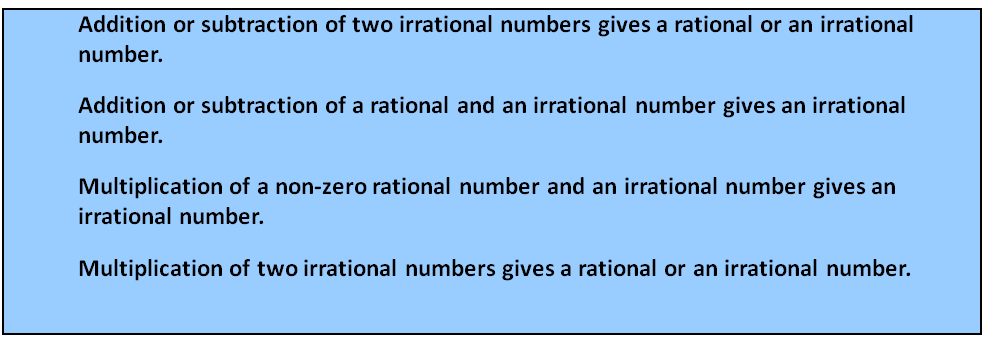
We will now prove that  is irrational.
is irrational.
We know that  is irrational (as proved before).
is irrational (as proved before).
Now, the multiplication of a rational and an irrational number gives an irrational number. Therefore,  is an irrational number.
is an irrational number.
Let us now try to understand the concept further through some more examples.
Example 1: Prove that  is irrational. Solution:
is irrational. Solution:
Let us assume that is not irrational, i.e.
is not irrational, i.e. is a rational number.
is a rational number.
Then we can write , where a and b are integers andb ≠ 0.
where a and b are integers andb ≠ 0.
Let a and b have a common factor other than 1.
After dividing by the common factor, we obtain
 , where c and d are co-prime numbers.
, where c and d are co-prime numbers.



As c, d and 2 are integers,  and
and  are rational numbers.
are rational numbers.
Thus, is rational.
is rational.
![]() is rational as the difference of two rational numbers is again a rational number.
is rational as the difference of two rational numbers is again a rational number.
This is a contradiction as is irrational.
is irrational.
Therefore, our assumption that  is rational is wrong.
is rational is wrong.
Hence,  is irrational.
is irrational.
Example 2: Prove that  is irrational.
is irrational.
Solution:
Let us assume  is rational. Then, we can write
is rational. Then, we can write
 ,
,
where a and b are co-prime and b ≠ 0.
⇒![]()
Now, as a and b are integers, is rational or
is rational or  is a rational number.
is a rational number.
This means that is rational.
is rational.
This is a contradiction as is irrational.
is irrational.
Therefore, our assumption that  is rational is wrong.
is rational is wrong.
Hence,  is an irrational number.
is an irrational number.
Decimal Expansions of Rational Numbers
The Need for Converting Rational Numbers into Decimals
A carpenter wishes to make a point on the edge of a wooden plank at 95 mm from any end. He has a centimeter tape, but how can he use that to mark the required point?
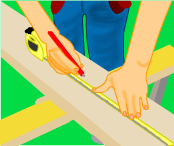
Simple! He should convert 95 mm into its corresponding centimeter value, i.e., 9.5 cm and then measure and mark the required length on the wooden plank.
This is just one of the many situations in life when we face the need to convert numbers into decimals. In this lesson, we will learn to convert rational numbers into decimals, observe the types of decimal numbers, and solve a few examples based on this concept.
Know More
Two rational numbers  and
and are equal if and only if ad = bc.
are equal if and only if ad = bc.
Take, for example, the rational numbers  and
and  . Let us see if they are equal or not. Here, a = 2, b = 4, c = 3 and d = 6
. Let us see if they are equal or not. Here, a = 2, b = 4, c = 3 and d = 6
Now, we have:
ad = 2 × 6 = 12
bc = 4 × 3 = 12
Since ad = bc, we obtain = .
= .
We know that the form represents the division of integer p by the integer q. By solving
represents the division of integer p by the integer q. By solving
this division, we can find the decimal equivalent of the rational number  . Now, let us convert the numbers
. Now, let us convert the numbers ,
,  and
and into decimals using the long division method.
into decimals using the long division method.
![]()
![]()

While the remainder is zero in the division of 5 by 8, it is not so in case of the other two divisions. Thus, we can get two different cases in the decimal expansions of rational numbers.
Observing the Decimal Expansions of Rational Numbers
We can get the following two cases in the decimal expansions of rational numbers.
Case I: When the remainder is zero
In this case, the remainder becomes zero and the quotient or decimal expansion terminates after a finite number of digits after the decimal point. For example, in the decimal
expansion of ,  we get the remainder as zero and the quotient as 0.625.
we get the remainder as zero and the quotient as 0.625.
Case II: When the remainder is never zero
In this case, the remainder never becomes zero and the corresponding decimal expansion
is non-terminating. For example, in the decimal expansions of and
and , we see that the remainder never becomes zero and their corresponding quotients are non-terminating decimals.
, we see that the remainder never becomes zero and their corresponding quotients are non-terminating decimals.
When we divide 4 by 3 and 2 by 7, we get 1.3333… and 0.285714285714… as the respective quotients. In these decimal numbers, the digit ‘3’ and the group of digits
‘285714’ get repeated. Therefore, we can write and
and
Here, the symbol  indicates the digit or group of digits
indicates the digit or group of digits
that gets repeated.
Solved Examples
Example 1: Write the decimal expansion of  and find if it is terminating or non- terminating and repeating.
and find if it is terminating or non- terminating and repeating.
Solution:
Here is the long division method to find the decimal expansion of .

Hence, the decimal expansion of is 49.48. Since the remainder is obtained as zero, the decimal numberis terminating.
is 49.48. Since the remainder is obtained as zero, the decimal numberis terminating.
Example 2: Write the decimal expansion of  and find if it is terminating or non- terminating and repeating.
and find if it is terminating or non- terminating and repeating.
Solution:
Here is the long division method to find the decimal expansion of .

Hence, the decimal expansion of is 87.33 Since the remainder 9 is obtained again
is 87.33 Since the remainder 9 is obtained again
and again, the decimal numberis non-terminating and repeating. The decimal number can also be written as .![]()
Medium
Example 1: Find the decimal expansion of each of the following rational numbers and write the nature of the same.
1.
2.
3.
4.
Solution:
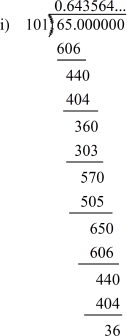
We have  = 0.64356435... =
= 0.64356435... =
The group of digits ‘6435’ repeats after the decimal point. Hence, the decimal expansion of the given rational number is non-terminating and repeating.
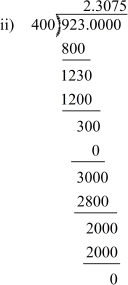
We have = 2.3075
= 2.3075
Hence, the given rational number has a terminating decimal expansion.
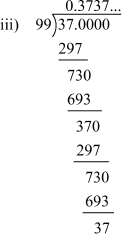
We have = 0.3737... =
= 0.3737... =
The pair of digits ‘37’ repeats after the decimal point. Hence, the decimal expansion of the given rational number is non-terminating and repeating.
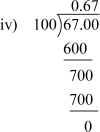
We have![]() = 0.67
= 0.67
Hence, the given rational number has a terminating decimal expansion.
Terminating and Non-terminating Repeating Decimal Expansions of Rational Numbers
We can find the decimal expansion of rational numbers using long division method.
However, it is possible to check whether the decimal expansion is terminating or non- terminating without actually carrying out long division also.
Let us start by taking a few rational numbers in the decimal form.
(a)

(b)
0.275
On prime factorizing the numerator and the denominator, we obtain

Can you see a pattern in the two examples?
We notice that the given examples are rational numbers with terminating decimal expansions. When they are written in the  form, where p and q are co-prime
form, where p and q are co-prime
(the HCF of p and q is 1), the denominator, when written in the form of prime factors, has 2 or 5 or both.
The above observation brings us to the given theorem.
If x is a rational number with terminating decimal expansion, then it can be expressedin the  form, where p and q are co-prime (the HCF of p and q is 1) and the prime factorisation of q is of the form 2n5m, where n and m are non-negative integers.
form, where p and q are co-prime (the HCF of p and q is 1) and the prime factorisation of q is of the form 2n5m, where n and m are non-negative integers.
Contrary to this, if the prime factorisation of q is not of the form 2n5m, where n and m are non-negative integers, then the decimal expansion is a
non-terminating one.
Let us see a few examples that will help verify this theorem.
(a)
(b)
(c) 
(d) 
Note that in examples (b) and (d), each of the denominators is composed only of the prime factors 2 and 5, because of which, the decimal expansion is terminating. However, in examples (a) and (c), each of the denominators has at least one prime factor other than 2 and 5 in their prime factorisation, because of which, the decimal expansion is non- terminating and repetitive.
To summarize the above results, we can say that:

Let us solve a few examples to understand this concept better.
Example 1: Without carrying out the actual division, find if the following rational numbers have a terminating or a non-terminating decimal expansion.
(a)
(b) 
Solution:
(a)
As the denominator can be written in the form 2n5m, where n = 6 and m = 2 are non-negative integers, the given rational number has a terminating decimal expansion.
(b)
As denominator cannot be written in the form 2n5m, where n and m are non-negative integers, the given rational number has a non-terminating decimal expansion.
Example 2: Without carrying out the actual division, find if the expression  has a terminating or a non-terminating decimal expansion.
has a terminating or a non-terminating decimal expansion.
Solution: =
=
As the denominator can be written in the form 2n5m, where n = 7and m = 0 are non-negative integers, the given rational number has a terminating decimal expansion.


Hence, 5.5859375 is the decimal expansion of the given rational number.
1.Zeros of Polynomial
Graphic Interpretation Of The Number Of Zeros Of A Polynomial
A polynomial in variable x is denoted by p(x).
The highest power of the variable in the polynomial is known as its degree. For example, the highest power of variable x in the polynomial x2 − 3x + 2 is 2. Hence, it’s degree is 2.
Let us better understand this concept with a few more examples.
Example1: Find the number of zeroes of the polynomial whose graph is given below.
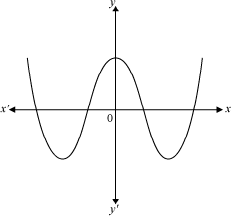
Solution:
The given graph intersects the x- axis at 4 distinct points. Hence, the number of zeroes of the given polynomial is 4.
Example 2: Find the number of zeroes of the polynomial whose graph is given below.
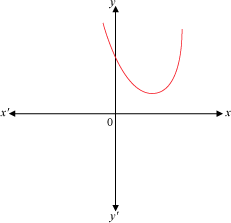
Solution:
The given graph does not intersect the x-axis.
Hence, the given polynomial has no zeroes or in other words, the number of zeroes of the given polynomial is zero.
Example 3: Find the number of zeroes of the polynomials whose graphs are given below.
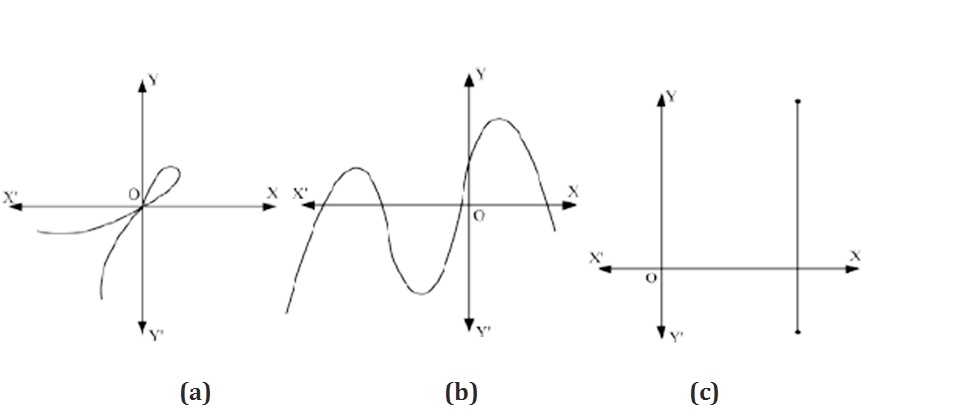
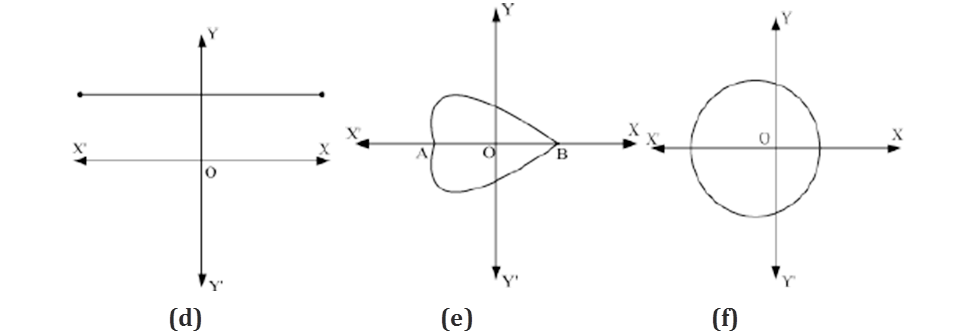
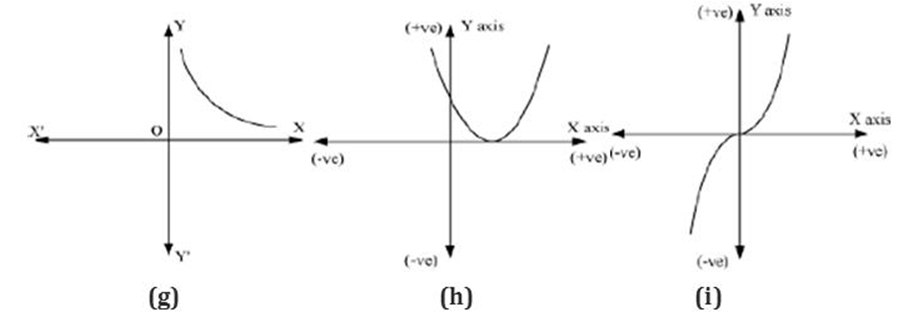

Solution:
(a) The graph intersects the x-axis at only 1 point.
Hence, the number of zeroes of this polynomial is 1.
(b) The graph intersects the x-axis at 4 distinct points.
Hence, the number of zeroes of this polynomial is 4.
(c) The graph intersects the x-axis at only 1 point.
Hence, the number of zeroes of this polynomial is 1.
(d) The graph of the polynomial does not intersect the x-axis.
Hence, this polynomial has no zeroes.
(e) The graph intersects the x-axis at 2 distinct points.
Hence, the number of zeroes of this polynomial is 2.
(f) The graph intersects the x-axis at 2 distinct points.
Hence, the number of zeroes of this polynomial is 2.
(g) The graph of the polynomial does not intersect the x-axis.
Hence, this polynomial has no zeroes.
(h) The graph intersects the x-axis at only 1 point.
Hence, the number of zeroes of this polynomial is 1.
(i) The graph intersects the x-axis at only 1 point.
Hence, the number of zeroes of this polynomial is 1.
(j) The graph intersects the x-axis at 4 distinct points.
Hence, the number of zeroes of this polynomial is 4.
(k) The graph intersects the x-axis at 5 distinct points.
Hence, the number of zeroes of this polynomial is 5.
(l) The graph intersects the x-axis at 3 distinct points.
Hence, the number of zeroes of this polynomial is 3.
Geometrical Interpretation Of Zeros Of Polynomials
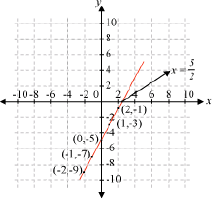
Let us consider a polynomial p(x) = 2x – 5. Its graph can be drawn as follows:
If we notice the above graph carefully, then we can see that the graph of the polynomial p(x) = 2x – 5 passes through the x-axis at a point .
Do you know what is the value of the polynomial p(x) at the x-coordinate of this point? Let us find out how.

Thus, is a zero of the polynomial.
is a zero of the polynomial.
Thus, we can say that

Using the above statement, we can find out the zeroes of the polynomials. The method of finding zeroes can be easily understood with the help of the following example.
Let us find the zeroes of the polynomial p(x) = x2 – 4x + 3. The graph of this polynomial can be drawn as follows:
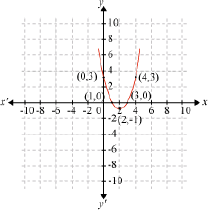
From the graph, we can see that the graph of the polynomial p(x) = x2 – 4x + 3 cuts the x- axis at two points respectively (1, 0) and (3, 0). Now, the x-coordinates of these points are 1 and 3 respectively. Thus, 1 and 3 are the zeroes of the given polynomial p(x) = x2 – 4x + 3.
In this way we can interpret the zeroes of the polynomial geometrically.
Let us discuss one more example based on geometrical interpretation of zeroes of a polynomial.
Example1: Find the zeroes of the polynomials whose graphs are shown below.
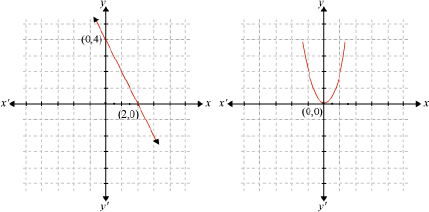
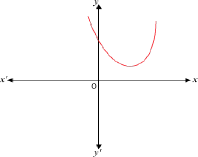
Solution:
(i) The graph of the polynomial intersects the x-axis at the point (2, 0).
The x coordinate of the point (2, 0) is 2.
Thus, 2 is a zero of the polynomial whose graph has been shown.
(ii) The graph of the polynomial intersects the x-axis at the point (0, 0).
The x co-ordinate of the point (0, 0) is 0. Thus, 0 is a zero of the polynomial.
(iii) The graph does not intersect the x-axis, so there is no zero of the polynomial whose graph has been shown.
1. Solution of Two Linear Equations in Two Variables in Different Methods
Pair of Linear Equations in Two Variables
Inconsistent, Consistent, And Dependent Pairs Of Linear Equations
Linear equations in two variables are equations where we have two variables. We require two equations to find the solution of linear equations in two variables. Go through the following video to understand the basic concept of linear equations in two variables.
Remember: To solve a linear equation in one variable, only one equation is required. To solve linear equations in two variables, two linear equations in the same two variables are required. Likewise, we can say that to solve linear equations with n number of
variables, n numbers of linear equations in the same n number of variables are required. The general form of a pair of linear equations in two variables is written as
 , where a1, b1 are real numbers and
, where a1, b1 are real numbers and (i.e., a1, b1 ≠ 0)
(i.e., a1, b1 ≠ 0)
 , where a2, b2 are real numbers and
, where a2, b2 are real numbers and (i.e., a2, b2 ≠ 0)
(i.e., a2, b2 ≠ 0)
We know that the solution of a linear equation must satisfy the equation. Conversely, we can say that the value of the variable in the equation, which satisfies the equation, is the solution of the equation.
In case of a pair of linear equations, the values of x and y, which satisfy both the equations, are the solutions of the equation.
Geometrically, a linear equation represents a straight line. Every solution of an equation is a point on the line represented by the equation.
Likewise, a pair of linear equations represents two straight lines. When their graphs are drawn, there are three possibilities. Let us go through the video to understand the various possibilities.
Example 1: Find whether the given pairs of linear equations are consistent or inconsistent?
(a) 5x + 2y = 2 20x + 8y = 1
(b) 4x + y = 8
7x – 2y = 1
(c) 5x + 6y = 9
10x + 12y = 18
Solution:
(b) 4 x + y = 8
7x – 2y = 1
Here, a1 = 4 b1 = 1 c1 = –8
a2 = 7 b2 = –2 c2 = –1


Therefore, according to the above rule, this system of equations has a unique solution. It is represented by intersecting lines.
(c) 5x + 6y = 9
10x + 12y = 18
Here, a1 = 5 b1 = 6 c1 = –9
a2 = 10 b2 = 12 c2 = –18


Therefore, according to the above rule, this system of equations has infinite solutions. It is represented by coincident lines.
Example 2: There are two lines drawn in each of the following graphs. Each line represents a linear equation in two variables. State whether the pair of linear equations represented in each graph is consistent, inconsistent, or dependent.
(a)
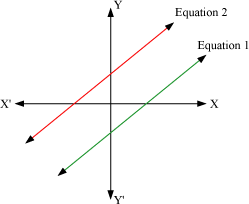
(b)
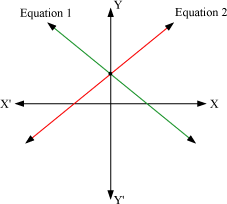
(c)
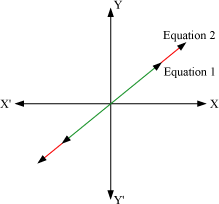
Solution:
(a) In the given graph, the lines representing the two equations are parallel to each other and never intersect. Thus, the lines in this graph represent an inconsistent pair of linear equations in two variables as they do not have any solution.
(b) In the given graph, the lines representing the two equations intersect at a point. Thus, the lines in this graph represent a consistent pair of linear equations in two variables as they have a unique solution.
(c) In the given graph, the lines are coincident i.e., the same line represents the two equations. Thus, the lines in this graph represent a dependent pair of linear equations in two variables as they have infinite number of solutions.
Expressing Given Situations Mathematically
We come across many situations in real life when it is easy to find the solution, if we express them mathematically.
Let us see such a situation.
The coach of the school cricket team buys 5 bats and 20 leather balls for Rs 3500. After some time, some more boys joined the team for practice, so he buys another 4 bats and 15 balls for Rs 2750. Suppose that the price of bat and ball does not change in the time period.
Can we express this situation mathematically to find out the individual prices of a ball and a bat?
Let the price of a bat be Rs x and that of a ball be Rs y.
It is given that 5 bats and 20 balls cost Rs 3500.
∴ Cost of 5 bats = 5x
And cost of 20 balls = 20y
⇒ Cost of 5 bats and 20 balls = 5x + 20y
⇒ 5x + 20y = 3500
Similarly, it is also given that 4 bats and 15 balls cost Rs 2750.
⇒ 4x + 15y = 2750
Therefore, the algebraic representation of the given situation is
5x + 20y = 3500 … (1)
4x + 15y = 2750 … (2)
After solving these equations, we can find out the individual prices of the ball and the bat. Let us see some more examples.
Example 1: Aman and Yash each have certain number of chocolates. Aman says to Yash, if you give me 10 of your chocolates, I will have twice the number of chocolates left with you. Yash replies, if you give me 10 of your chocolates, I will have the same number of chocolates as left with you. Write this situation mathematically?
Solution:
Suppose Aman has x number of chocolates and Yash has y number of chocolates.
According to the first condition, Yash gives 10 chocolates to Aman so that Aman has twice the number of chocolates than what Yash has.
⇒ x + 10 = 2(y – 10)
According to the second condition, Aman gives 10 chocolates to Yash such that both have equal number of chocolates.
⇒ y +10 = x – 10
Thus, the algebraic representation of the given situation is
x + 10 = 2(y – 10) … (1)
y +10 = x – 10 … (2)
Example 2: Cadets in the military academy are made to stand in rows. If one cadet is extra in each row, then there would be 2 rows less. If one cadet is less in each row, then there would be 3 more rows. Express the given situation mathematically?
Solution:
Let the number of cadets in each row be x and the number of rows be y.
Total number of cadets = number of rows  number of cadets in each row
number of cadets in each row
It is given to us that when one cadet is extra in each row, there are 2 rows less.
∴ xy = (y – 2) (x + 1)
xy = xy – 2x + y – 2
2x – y = – 2 … (1)
It is also given to us that if one cadet is less in each row, then there are 3 more rows.
∴ xy = (y + 3) (x – 1)
xy = xy + 3x – y – 3
3x – y = 3 … (2)
Thus, the algebraic representation of the given situation is
2x – y = – 2 … (1)
3x – y = 3 … (2)
Graphical Solution of a Pair of Linear Equations In Two Variables
Suppose you go to a stationary shop to buy some registers and pens. If you buy two registers and two pens, then you have to pay Rs 30. However, if you buy two registers and four pens, then you have to pay Rs 40.
Now, how can we represent this information algebraically, i.e., in the form of equations? Let us denote the cost of each register by Rs x and that of each pen by Rs y.
Now, it is given to us that two registers and two pens cost Rs 30.
∴ 2x + 2y = 30
⇒ x + y − 15 = 0 … (1)
We also know that two registers and four pens cost Rs 40.
∴ 2x + 4y = 40
⇒ x + 2y − 20 = 0 … (2)
Thus, we now have two linear equations in two variables from the given situation.
x + y − 15 = 0 … (1)
x + 2y − 20 = 0 … (2)
These two equations are known as a pair of linear equations in two variables. If we try to individually solve each equation, we will be unable to do so. We can arrive at an answer only if we try and solve both these equations together.
The general form of a pair of linear equations in two variables is written as
 , where a1, b1, c1 are real numbers, and
, where a1, b1, c1 are real numbers, and (i.e., a1, b1 ≠ 0)
(i.e., a1, b1 ≠ 0)
 , where a2, b2, c2 are real numbers, and
, where a2, b2, c2 are real numbers, and  (i.e., a2, b2 ≠ 0)
(i.e., a2, b2 ≠ 0)
A pair of linear equations represents two straight lines. When their graphs are drawn, there are three possibilities.
(i) The two lines may intersect at one point.
(ii) The two lines may be parallel.
(iii) They may represent the same line, i.e. they may be coincident.
The solution of a pair of linear equations is the point of intersection of their graphs.
Similarly, you can also graphically prove two lines to be inconsistent. Try it out yourself.
Limitations of graphical method:
- If the large values of variables are involved in the solution of system of linear equations then it is not convenient to use graphical method.
- If the fractional values of variables are involved in the solution of system of linear equations then it is not possible to obtain accuracy through graphical method.
- If the angle between two lines is small then the exact point of intersection cannot be obtained through graphical method.
Now, let us solve some examples to understand this concept better.
Example 1: Anshuman and Vikram have 10 marbles with them. Twice the number of marbles with Anshuman is equal to three times the number of marbles with Vikram. Solve this question graphically.
Solution:
Let us suppose that Anshuman has x marbles and Vikram has y marbles.
From the given information, we can form two equations as
x + y = 10
⇒ x + y − 10 = 0 … (i)
2x = 3y
⇒ 2x − 3y = 0 … (ii)
A table can be drawn for the corresponding values of x and y for equation (i) as
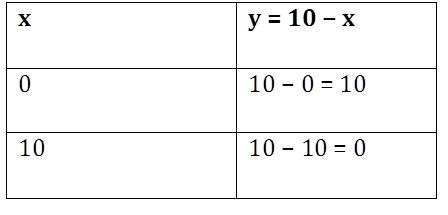
Similarly, a table can be drawn for the corresponding values of x and y for equation (ii) as
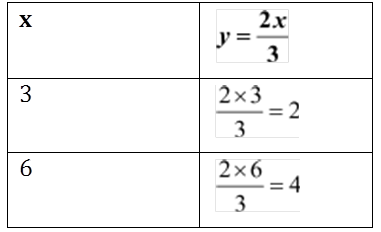
The two equations can be plotted on a graph as
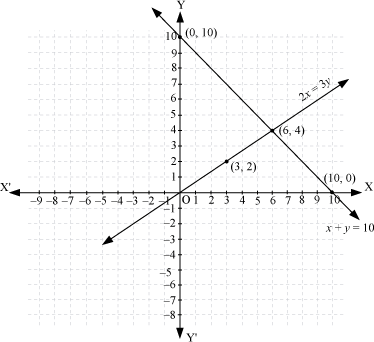
As seen in the graph, the two lines intersect at the point (6, 4).
This implies that the solution for the pair of linear equations is x = 6 and y = 4. Thus, Anshuman has 6 marbles while Vikram has 4 marbles.
Example 2: Find graphically whether the following pairs of linear equations are consistent or inconsistent? If the equations are consistent, then find their solutions as well.
(a) 2x + 3y = 2
4x + 3y = 4
(b) x + y = 5
2x + 2y = 10
Solution:
(a) 2x + 3y = 2
4x + 3y = 4
A table can be drawn for the corresponding values of x and y for the equation 2x + 3y = 2 as
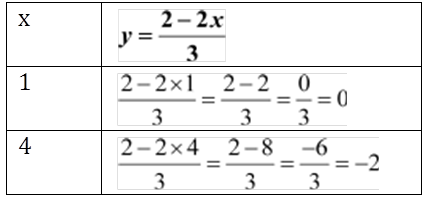
Similarly, a table can be drawn for the corresponding values of x and y for the equation 4x + 3y = 4 as
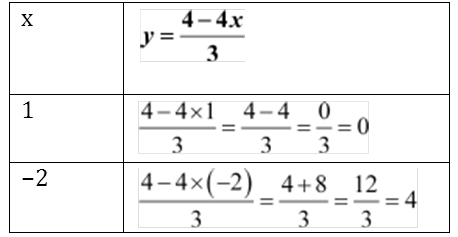
These points can now be plotted and joined to obtain the graphs of the equations as
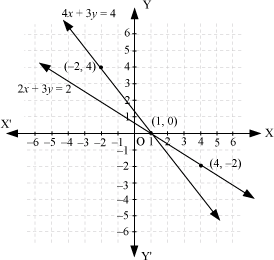
As seen in the graph, the two lines intersect at the point (1, 0). Thus, the given pair of linear equations is consistent with its solution as x = 1 and y = 0.
(b)x + y = 5
2x + 2y = 10
A table can be drawn for the corresponding values of x and y for the equation x + y = 5 as
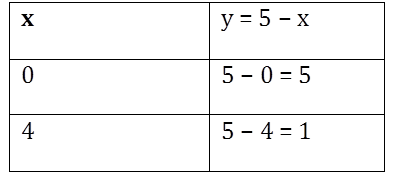
Similarly, a table can be drawn for the corresponding values of x and y for the equation 2x + 2y = 10 as
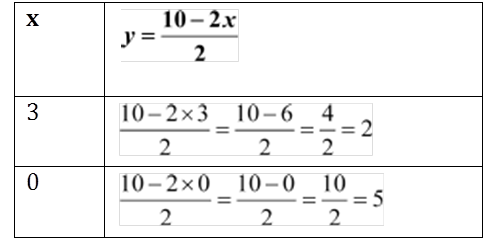
These points can now be plotted and joined to obtain the graphs of the lines as
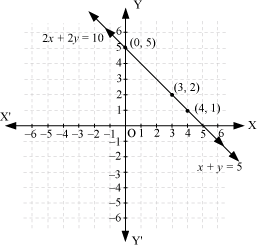
As seen in the graph, the two equations are represented by the same line. This means that the given pair of linear equations is dependent. Any point lying on this line is a solution to the pair of equations.
Substitution Method Of Solving Pairs Of Linear Equations
In a class, the number of boys is 7 more than twice the number of girls.
Can you find the number of boys and girls in the class? Let the number of boys be x and the number of girls be y. Now, according to the given condition,
x – 2y = 7
We cannot find the unique values of x and y by solving this equation because there are multiple values of x and y for which this equation holds true.
We can write the above equation as x = 2y + 7. Thus, by taking different values of y, we will obtain different values of x.
However, if we are given one more condition, then the values of x and y can be evaluated.
To solve a linear equation in two variables, two linear equations in the same two variables are required.
Let us consider one more condition. Suppose the total number of students in the class is 52.
Now, can you find the number of boys and girls in the class?
According to this condition, we can write x + y = 52
Therefore, we obtain a pair of linear equations in two variables.
x – 2y = 7
x + y = 52
Therefore, number of boys = 37 and number of girls = 15
In this method, we have substituted the value of one variable by expressing it in terms of the other variable to solve the pair of linear equations. That is why this method is known as the substitution method.
Now, let us solve some examples to understand this concept better.
Example 1: The sum of the digits of a two-digit number is 8. If 18 is added to the number, then the digits interchange their places. Find the number.
Example 2: Solve the following pair of linear equations.
7x – 5y + 12 = 0
3x + 8y – 5 = 0
Solution:
Given, 7x – 5y + 12 = 0 … (i)
3x + 8y – 5 = 0 … (ii)
From equation (i), we obtain
7x – 5y + 12 = 0

On substituting the value of y in equation (ii), we obtain
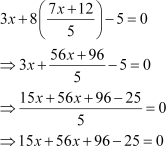
⇒ 71x + 71 = 0
⇒ 71x = – 71
⇒ x = – 1
Putting the value of x in equation (iii), we obtain
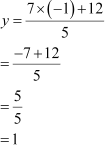
Therefore, x = – 1 and y = 1
Example 3: Arnab has few coins of Rs 5 and Rs 2 which together amount to Rs 167. If he has a total of 46 coins then find the number of both types of coins with him.
Solution:
Let the number of coins of Rs 2 be x and that of Rs 5 be y.
According to the question, we have
2x + 5y = 167 ...(i)
x + y = 46 ...(ii)
From equation (ii), we obtain
x = 46 – y ...(iii)
On substituting the value of x from equation (iii) in equation (i), we obtain
2(46 – y) + 5y = 167
⇒ 92 – 2y + 5y = 167
⇒ 92 + 3y = 167
⇒ 3y = 75
⇒ y = 25
On substituting the value of y in equation (ii), we obtain
x + 25 = 46
⇒ x = 21
Hence, Arnab has 21 coins of Rs 2 and 25 coins of Rs 5.
Example 4: A boat can travel 28 km downstream and 20 km upstream in 7 hours. Also, this boat can travel 21 km downstream and 18 km upstream in 6 hours. What is the speed of the boat in still water and the speed of the stream?
Solution:
Let x km/hr and y km/hr be the speed of the boat in still water and speed of the stream respectively.
Therefore,
Speed of the boat downstream = (x + y) km/hr
Speed of the boat upstream = (x – y) km/hr
∴ Time taken by the boat to travel 28 km downstream =  And, time taken by the boat to travel 20 km upstream =
And, time taken by the boat to travel 20 km upstream =  According to the question, we have
According to the question, we have

Now,
Time taken by the boat to travel 21 km downstream =  And, time taken by the boat to travel 18 km upstream =
And, time taken by the boat to travel 18 km upstream =  According to the question, we have
According to the question, we have

On substituting  in equation (i) and (ii), we obtain
in equation (i) and (ii), we obtain
28a + 20b = 7 ...(iii)
21a + 18b = 6 ...(iv)
From equation (iv), we obtain
7a + 6b = 2
⇒ 7a = 2 – 6b

On substituting the value of a from (v) in (iii), we obtain
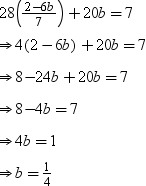
On putting this value of b in equation (v), we obtain

On resubstituting the values of a and b, we obtain

From (vii), we obtain x = y + 4. On substituting this value of x in (vi), we obtain
y + 4 + y = 14
⇒ 2y = 10
⇒ y = 5
On substituting y = 5 in (vii), we get
x – 5 = 4
⇒ x = 9
Thus, the speed of the boat in still water is 9 km/hr and the speed of stream is 5 km/hr.
Elimination Method To Solve A Pair Of Linear Equations
There are many real life situations which can be represented in the form of linear equations. Let us begin with such a situation.
Suppose you go to the market with your friend to buy clothes. You buy 3 shirts and 6 pairs of jeans from a shop and the total cost of your purchase comes out to be Rs 7000. Your friend, on the other hand buys 2 shirts and 3 pairs of jeans and the total cost of his purchase comes out to be Rs 3855. Now, we can represent this information mathematically as pair of linear equations in two variables. We can then solve the equations and get the
cost of each shirt and each pair of jeans. Let’s look at the following video to learn how to mathematically represent the information and then solve them using the elimination method.
Example 2: Solve the following equations using elimination method.
3x + 4y = 0
4x – 3y = 50
Solution:
Given,
3x + 4y = 0 … (i)
4x – 3y = 50 … (ii)
On multiplying equation (i) by 3 and equation (ii) by 4, we obtain
9x + 12y = 0 … (iii)
16x – 12y = 200 … (iv)
On adding equation (iii) and (iv), we obtain
25x = 200

Putting the value of x in equation (i), we obtain
3 × 8 + 4y = 0
⇒ 4y = − 24

Thus, x = 8 and y = − 6.
Example 3: Solve the following equations using elimination method.
7x + 5y = 43
5x + 7y = 41
Solution:
Given,
7x + 5y = 43 … (i)
5x + 7y = 41 … (ii)
It can be observed that coefficients of x and y in equation (i) are interchanged in equation (ii).
Let us add both the equations as follows:

⇒ 12(x + y) = 84
⇒ x + y = 7 ...(iii)
Now, let us subtract equation (ii) from equation (i) as follows:

⇒ 2(x – y) = 2
⇒ x – y = 1 ...(iv)
On adding equations (iii) and (iv), we obtain

⇒ x = 4
On putting the value of x in equation (i), we obtain
7 × 4 + 5y = 43
⇒ 28 + 5y = 43
⇒ 5y = 15
⇒ y = 3
Thus, x = 4 and y = 3.
Example 5: Five units of a solution are obtained by mixing two liquids A and B. If the liquids A and B are used in the ratio as 2 : 3 then the total cost comes out to be Rs 50.
Also, if the liquids A and B are used in the ratio as 3 : 2 then the total cost increases by 10%. Find the cost of per unit of each of the liquids A and B.
Solution:
Let x and y be costs of per unit of liquids A and B respectively. According to the question, we have
2x + 3y = 50 ...(i)
And
3x + 2y = 50 + 10% of 50
3x + 2y = 50 + 5
3x + 2y = 55 ...(ii)
On multiplying equation (i) by 3 and equation (ii) by 2, we obtain
6x + 9y = 150 ...(iii)
6x + 4y = 110 ...(iv)
On subtracting equation (iv) from equation (iii), we obtain
5y = 40
⇒ y = 8
On substituting y = 8 in equation (ii), we obtain
3x + 2(8) = 55
⇒ 3x + 16 = 55
⇒ 3x = 39
⇒ x = 13
Hence, the cost of per unit of liquid A is Rs 13 an that of liquid B is Rs 8.
Example 6: Some friends ate 5 pizzas and 3 burgers for which they paid Rs 445. One of them said "If the numbers of pizzas and burgers would have been exchanged, we would pay Rs 50 less." What is the cost of a pizza and that of a burger?
Solution:
Let the cost of a pizza be Rs x and that of a burger be Rs y.
∴ Cost of 5 pizzas = Rs 5x And, cost of 3 burgers = Rs 3y
According to the first condition, we have
5x + 3y = 445 ...(i)
Similarly, for the second condition, we have
3x + 5y = 445 – 50
⇒ 3x + 5y = 395 ...(ii)
On multiplying equation (i) by 3 and equation (ii) by 5, we obtain
15x + 9y = 1335 ...(iii)
15x + 25y = 1975 ...(iv)
On subtracting equation (iii) from equation (iv), we obtain
16y = 640
⇒ y = 40
On substituting y = 40 in equation (ii), we obtain
3x + 5(40) = 395
⇒ 3x + 200 = 395
⇒ 3x = 195
⇒ x = 65
Thus, cost of a pizza is Rs 65 and that of a burger is Rs 40.
Cross-Multiplication Method Of Solving Pairs Of Linear Equations
We can represent many situations in real life as linear equation in two variables. Let us consider such a situation.
Suppose Samay is older than Sumit by 30 years. After 5 years, Samay will be thrice as old as Sumit.
Can we find the present ages of Samay and Sumit?
Yes, we can find the present ages. However, before that, we have to represent this situation in the form of linear equations in two variables. Let us see how we can represent the above given situations as linear equations.
Let the present age of Samay be x years and the present age of Sumit be y years.
It is given that Samay is older than Sumit by 30 years. Thus, according to this condition, we have
x – y = 30
After 5 years, the age of Samay will be(x + 5) years and the age of Sumit will be (y + 5) years. However, it is given that after 5 years, Samay will be thrice as old as Sumit. Thus, we have
x + 5 = 3 (y + 5)
⇒ x + 5 = 3y + 15
⇒ x – 3y = 10
Now, we obtain the pair of linear equations as follows:
x – y = 30 … (1)
x – 3y = 10 … (2)
We can find the present ages of Samay and Sumit by solving the above equations for variables x and y.
We know three methods to solve a pair of linear equations.
(i) Substitution method
(ii) Elimination method
(iii) Graphical method
Now, we will follow another method to solve linear equations in two variables. This method is known as Cross-multiplication method. Firstly, let us discuss this method and after that we will solve the above equations for x and y. So, go through the following video to understand the cross-multiplication method and how it is applied to solve the above given equations.
Therefore, the present ages of Samay and Sumit are 40 years and 10 years respectively.
In this way, we can solve a pair of linear equations in two variables by cross-multiplication method.
We could solve these linear equations in two variables by other methods also. But why should we use cross-multiplication method to solve linear equations?
The cross-multiplication method is easier as compared to the other methods if the coefficients of variables in the equations are large numbers or numbers that look complex. To understand this concept better, let us see the following examples.
Example 2: Solve the following pair of linear equations in two variables by cross- multiplication method.
ax + by = a2 + b2 and
x + y = 2a Solution:
The above two equations can be written as
ax + by – (a2 + b2) = 0 … (1)
x + y – 2a = 0 … (2)
From the above two equations, we obtain
a1 = a, b1 = b, c1 = – (a2 + b2) and
a2 = 1, b2 = 1, c2 = – 2a
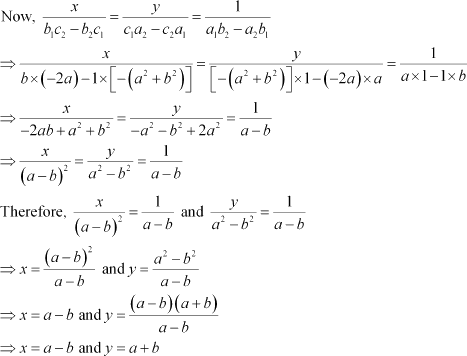
Equations Reducible To A Pair Of Linear Equations In Two Variables
Consider the following equations.
x = y; x = 21y + 15; m + 20n = –13; etc.
x = 21y + 15; m + 20n = –13; etc.
We can see that the above equations are linear equations in two variables. However, there are many equations, which do not appear to be linear equations at first glance such as

Now, can we solve these equations?
Example1: Solve the following pair of linear equations.

Solution:

From equation (1), we can write,

From equation (2), we can write,

Now, equation (3) becomes 5a + b = 7 … (5)
and equation (4) becomes 2a – 3b = – 4 … (6)
On multiplying (5) by 3, we obtain
15a + 3b = 21 … (7)
On adding equations (6) and (7), we obtain
17a = 17
⇒ a = 1
On putting the value of a in equation (5), we obtain
5 × 1 + b = 7
⇒ 5 + b = 7
⇒ b = 7 – 5 = 2
Since  = a = 1
= a = 1
⇒ x = 1
and  = b = 2
= b = 2
⇒ y =
Thus, x = 1 and y =
Example2: Solve the following pair of linear equations.

Solution:
The given equations can be written as
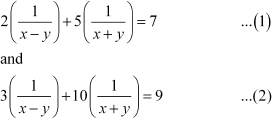

Thus, the equations become
2a + 5b = 7 … (3)
And, 3a + 10b = 9 … (4)
Now, on multiplying equation (3) by 2, we obtain
4a + 10b = 14 … (5)
On subtracting equation (4) from equation (5), we obtain
a = 14 – 9
 a = 5
a = 5
Putting the value of a in equation (3), we obtain
10 + 5b = 7
 5b = 7 – 10
5b = 7 – 10
 b =
b =

On adding these two equations, we obtain
2x =


Thus,
1.Solution of Quadratic Equation by Factorisation
Introduction to Quadratic Equations
Consider the equations

In equation (1), variable occurs only in second degree. The quadratic equations involving a variable only in second degree is a Pure quadratic equation.
Thus, an equation that can be expressed in the form  , where a and c are real numbers and a ≠ 0 is a pure quadratic equation.
, where a and c are real numbers and a ≠ 0 is a pure quadratic equation.
In equation (2) , variable occurs both in second and first degree. The quadratic equation involving a variable in both second and first degree is an Adfected quadratic equation.
Thus, an equation that can be expressed in the form  , where a, b and c are real numbers and a ≠ 0 is an Adfected quadratic equation.
, where a, b and c are real numbers and a ≠ 0 is an Adfected quadratic equation.
Now, let us learn about the roots of a quadratic equation.
Roots of a given quadratic equation are the values of the variables which satisfy that quadratic equation.
For example, consider the quadratic equation x2 – 8x + 15 = 0. Here, L.H.S. = x2 – 8x + 15 and R.H.S. = 0
Let us substitute the different values of variable x in this equation and observe the results. When x = 1 then x2 – 8x + 15 = 12 – 8(1) + 15 = 1 – 8 + 15 = 8 ∴ L.H.S. ≠ R.H.S.
When x = –1 then x2 – 8x + 15 = (–1)2 – 8(–1) + 15 = 1 + 8 + 15 = 24 ∴ L.H.S. ≠ R.H.S.
When x = 3 then x2 – 8x + 15 = 32 – 8(3) + 15 = 9 – 24 + 15 = 0 ∴ L.H.S. = R.H.S.
When x = 4 then x2 – 8x + 15 = 42 – 8(4) + 15 = 16 – 32 + 15 = –1 ∴ L.H.S. ≠ R.H.S.
When x = 5 then x2 – 8x + 15 = 52 – 8(5) + 15 = 25 – 40 + 15 = 0 ∴ L.H.S. = R.H.S.
When x = –5 then x2 – 8x + 15 = (–5)2 – 8(–5) + 15 = 25 + 40 + 15 = 80 ∴ L.H.S. ≠ R.H.S.
It can be observed that for x = 3 and x = 5, we have L.H.S. = R.H.S. which means that the equation x2 – 8x + 15 = 0 is satisfied. Thus, 3 and 5 are roots of this quadratic equation.
In other words, we can say that x = 3 and x = 5 are the solutions of quadratic equation x2 – 8x + 15 = 0.
Also, for x = 1, x = –1, x = 4 and x = –5, we have L.H.S. ≠ R.H.S. which means that the equation x2 – 8x + 15 = 0 is not satisfied. Thus, 1, –1, 4 and –5 are not the roots or solution of this quadratic equation.
Let us go through few examples to understand the concept better.
Example 1: Is the equation a quadratic equation?
a quadratic equation?
Solution:
The given equation is
We can also write it as

Hence, we can say that the given equation is a quadratic equation.
Example 2: Among the values given below find the roots of the quadratic equation 2x2 + 5x – 3 = 0.
x = 1,  , x = 2, x = –3,
, x = 2, x = –3, 
Solution:
We have,
Equation: 2x2 + 5x – 3 = 0
Values: x = 1,  , x = 2, x = –3,
, x = 2, x = –3, 
Let us substitute the given values of x in the equation and observe the results. When x = 1 then 2x2 + 5x – 3 = 2(1)2 + 5(1) – 3 = 2 + 5 – 3 = 4 ∴ L.H.S. ≠ R.H.S.
When  then
then
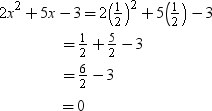
∴ L.H.S. = R.H.S.
When x = 2 then 2x2 + 5x – 3 = 2(2)2 + 5(2) – 3 = 8 + 10 – 3 = 15 ∴ L.H.S. ≠ R.H.S.
When x = –3 then 2x2 + 5x – 3 = 2(–3)2 + 5(–3) – 3 = 18 – 15 – 3 = 0 ∴ L.H.S. = R.H.S.
When  then
then
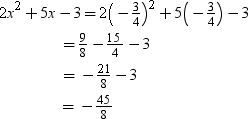
∴ L.H.S. ≠ R.H.S.
Only,  and x = –3 satisfy the given quadratic equation.
and x = –3 satisfy the given quadratic equation.
Thus,  and –3 are the roots of the given quadratic equation.
and –3 are the roots of the given quadratic equation.
Example 3: If one root of the quadratic equation 3x2 + 4x – p = 0 is 2323 then find the value of p.
Solution:
Since 2323 is a root of the equation 3x2 + 4x – p = 0, it must satisfy the equation.
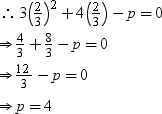
Example 4: State whether m is a root of the equation 2x2 – (2m + 3)x + 3m = 0 or not.
Solution:
If m is a root of the equation 2x2 – (2m + 3)x + 3m = 0 then it would satisfy the equation. Let us check it by substituting x = m in the given equation
2m2 – (2m + 3)m + 3m
= 2m2 – 2m2 – 3m + 3m
= 0
∴ L.H.S. = R.H.S.
Hence, m is a root of the equation 2x2 – (2m + 3)x + 3m = 0.
Expressing Given Situations as Quadratic Equations in One Variable
Quadratic equations arise in several situations around us and in different fields of mathematics. But how is a quadratic equation formulated?
Let us learn to express a situation mathematically.
Suppose there are two squares as shown in the following figure.
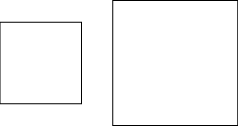
The sum of the areas of these two squares is 482 m2 and the difference of their perimeters is 32 m. Can we form a quadratic equation for the given mathematical situation?
Example1: An express train takes 1 hour less than a passenger train to travel a distance of 132 km. If the average speed of the express train is 11 km/h more than that of a passenger train, then form a quadratic equation to find the average speed of the express train?
Solution:
Let the average speed of the express train be x km/h.
Since it is given that the speed of the express train is 11 km/h more than that of a passenger train,
Therefore, the speed of the passenger train will be x −11 km/h. Also we know that 
Time taken by the express train to cover 132 km =
Time taken by the passenger train to cover 132 km =
And the express train takes 1 hour less than the passenger train. Therefore,
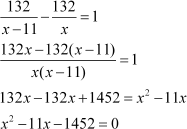
This is the required quadratic equation.
Example 2: A chess board contains 64 equal squares and the area of each square is 6.25 cm2. A border 2 cm wide is made around the board. Formulate a quadratic equation to find the length of each side of the board?
Solution:
Let the length of each side of the chess board be x cm.
Therefore, the length of the chess board without border will be x − 4 cm as shown in the following figure.
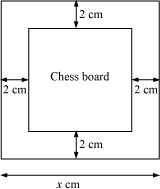
Area of the chess board without border = (x − 4)2
It is given that the area of each square is 6.25 cm2.
Area of 64 squares on the chess board = 6.25 × 64
Therefore,
 (x − 4)2 = 64 6.25
(x − 4)2 = 64 6.25

This is the required quadratic equation.
Solution of Quadratic Equations by the Method of Factorization
Quadratic equations come from many real life situations. Let us consider one such situation.
The area of a rectangular garden is 500 m2 and its length is 5 m more than its breadth. Can we find the length and breadth of the garden?
The garden can be drawn as
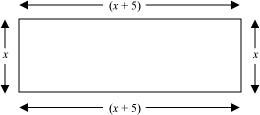
Let the breadth of the garden be x m.
Then, according to the given information, its length must be (x + 5) m.
Now, area of the garden = length × breadth = (x + 5) × x
The area of the garden is given as 500 m2.
∴ (x + 5) × x = 500
We can rewrite this equation as
x2 + 5x = 500
⇒ x2 + 5x – 500 = 0
This is a quadratic equation in variable x.
The length and the breadth of the garden can be calculated by solving the given quadratic equation.
How do we solve a quadratic equation? There are three methods of solving a quadratic equation, one of which is the method of factorization.
We have now expressed the equation x2 + 5x – 500 = 0 as the product of two factors, (x + 25) and (x – 20). We can find the solutions of this equation by equating each factor to 0.
∴ x + 25 = 0 and x – 20 = 0
⇒ x = –25 and x = 20
However, the breadth of a park cannot be negative.
∴ x = 20
Thus, breadth of the park = 20 m and length of the park = (20 + 5) m = 25 m.
Let us now look at some more examples to get a grasp on this concept.
Example 1: Find the roots of the equation .
Solution:
First, we rearrange the given equation according to the standard format.
x2 – x = 12
⇒ x2 – x – 12 = 0
We need a pair of numbers whose product is –12 and whose sum is –1.
These numbers are 3 and –4.
We can now rewrite the equation as
x2 – x – 12 = 0
⇒ x2 + 3x – 4x – 12 = 0
⇒ x(x + 3) – 4(x + 3) = 0
⇒ (x – 4)(x + 3) = 0
The solutions of the given equation can now be determined by equating the two factors to 0.
∴ (x – 4) = 0 and (x + 3) = 0
⇒ x = 4 and x = –3
Thus, the two roots of the quadratic equation are 4 and –3.
Example 2: Find the roots of the equation .
Solution:
First, we rearrange the given equation according to the standard format.
6x2 + 5x – 4 = 0
Here, we need to find two such numbers whose product is 6 × (–4) = –24 and whose sum is 5.
The required numbers are 8 and –3.
Now, [8 × (–3) = –24 and 8 + (–3) = 5]
6x2 + 5x – 4 = 0
⇒ 6x2 + 8x –3x – 4 = 0
⇒ 2x(3x + 4) – 1(3x + 4) = 0
⇒ (2x – 1)(3x + 4) = 0
⇒ 2x – 1 = 0 and 3x + 4 = 0

Thus, the roots of the given equation are  .
.
Example 3: Find two positive consecutive odd integers whose product is 99.
Solution:
Let the first integer be x.
The next odd integer will thus be x + 2.
∴ x(x + 2) = 99
 x2 + 2x – 99 = 0
x2 + 2x – 99 = 0
 x2 + 11x – 9x – 99 = 0
x2 + 11x – 9x – 99 = 0
 x(x + 11) – 9(x + 11) = 0
x(x + 11) – 9(x + 11) = 0
 (x – 9)(x + 11) = 0
(x – 9)(x + 11) = 0
 x – 9 = 0 and x + 11 = 0
x – 9 = 0 and x + 11 = 0
 x = 9 and x = –11
x = 9 and x = –11
However, we know that the two integers are positive.
∴ x = 9
Thus, the two integers are 9 and (9 + 2) = 11.
Example 4: The width of a rectangle is 16 feet less than 3 times its length. If the area of the rectangle is 35 ft2, then what are the dimensions of the rectangle?
Solution:
Here, the width of the rectangle has been expressed in terms of its length.
Hence, let us take the length of the rectangle to be x.
Thus, width of the rectangle = 3x – 16
The area of the rectangle is 35 ft2.
∴ 35 = x(3x –16)
 35 = 3x2 – 16x
35 = 3x2 – 16x
 3x2 – 16x – 35 = 0
3x2 – 16x – 35 = 0
 3x2 – 21x + 5x – 35 = 0
3x2 – 21x + 5x – 35 = 0
 3x(x – 7) + 5(x – 7) = 0
3x(x – 7) + 5(x – 7) = 0
 (3x + 5)(x – 7) = 0
(3x + 5)(x – 7) = 0
 3x + 5 = 0 and x – 7 = 0
3x + 5 = 0 and x – 7 = 0

However, the length of a rectangle cannot be negative.
∴ x = 7
Thus, length of the rectangle is x = 7 ft and the width of the rectangle is 3x – 16 = (3 × 7 – 16) ft = 5 ft
Example 5: Difference between the ages of a father and his son is 22 years. If the product of their ages is 555 then what are their ages?
Solution:
Let the age of the son be x years.
Then age of the father will be 22 + x years.
Since the product of their ages is 555, we have
x(22 + x) = 555
⇒22x + x2 = 555
⇒x2 + 22x – 555 = 0
⇒x2 + 37x – 15x – 555 = 0
⇒x(x + 37) – 15(x + 37) = 0
⇒(x + 37) (x – 15) = 0
⇒(x + 37) = 0 or (x – 15) = 0
⇒x = –37 or x = 15
Age cannot be negative, so we consider x = 15.
∴ Age of son = 15 years
∴ Age of father = (22 + 15) years = 37 years
Example 6: A bus takes 3 hours more than a train to travel a distance of 770 km. The speed of the train is more than that of bus by 15 km/hr. What are the average speeds of the bus and train?
Solution:
Let the average speed of the bus be x km/hr.
Then the average speed of the train will be (x + 15) km/hr.
Time taken by bus to cover 770 km = 
Time taken by train to cover 770 km =
According to the question, we have
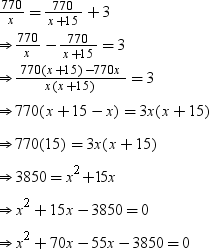
⇒ x(x + 70) – 55(x + 70) = 0
⇒ (x + 70) (x – 55) = 0
⇒ (x + 70) = 0 or (x – 55) = 0
⇒ x = –70 or x = 55
Speed cannot be negative, so we will consider x = 55.
∴ Average speed of bus = 55 km/hr
∴ Average speed of train = (55 + 15) km/hr = 70 km/hr
1.Arithmetic Progression Basics
The Concept Of Arithmetic Progression
Any given series of numbers may exhibit some special properties. A sequence of numbers in arithmetic progression is one of these special series.
Let us look at the following example.
Example 1: Check whether the following sequences form an A.P. or not.
(i)
(ii)
(iii)
(iv) A list of prime numbers greater than 2
(v) A list of the squares of natural numbers

(i) The given sequence is
Difference between the second and the first term


Difference between the third and the second term


Difference between the fourth and the third term


Since the difference between any two consecutive terms is a constant, the sequence is an arithmetic progression.
(ii) The given sequence is 
Difference between the second and the first term
Difference between the third and the second term
Difference between the fourth and the third term
Since the difference between any two consecutive terms is a constant, the sequence is an arithmetic progression.
(iii) The given sequence is 
This sequence can be rewritten as
Difference between the second and the first term
Difference between the third and the second term
Difference between the fourth and the third term
Since the difference between the consecutive terms is not a constant, the sequence is not an arithmetic progression.
(iv) The list of the prime numbers greater than 2 is: 3, 5, 7, 11 …
Difference between the second and the first term = 5 – 3 = 2
Difference between the third and the second term = 7 – 5 = 2
Difference between the fourth and the third term = 11 – 7 = 4
Since the difference between the consecutive terms is not a constant, the sequence is not an arithmetic progression.
(v) The list of the squares of natural numbers is: 12, 22, 32, 42 …
= 1, 4, 9, 16 …
Difference between the second and the first term = 4 – 1 = 3
Difference between the third and the second term = 9 – 4 = 5
Difference between the fourth and the third term = 16 – 9 = 7
Since the difference between the consecutive terms is not a constant, the sequence is not an arithmetic progression.
The Terminologies Related To Arithmetic Progressions
An arithmetic progression (A.P.) is a sequence in which the difference between any two consecutive terms is constant.
Now there are many common terms associated with an arithmetic progression, which one has to understand to solve any A.P. related problem.
Let us solve some more examples to understand this concept better.
Example 1: Find the common difference of the A.P.
Also, state whether it is finite or infinite and write down its first term.
Solution:
The given A.P. is
a1 = 
a2 = 
a3 = 
a4 =![]()

∴Common difference of the A.P. = 
First term of the A.P. =
The given A.P. is infinite because its last term cannot be calculated.
Example 2: State whether the following statements are true or false.
(i) The sequence  forms an A.P. with the first term as
forms an A.P. with the first term as and the common difference as
and the common difference as  .
.
(ii) The common difference of the A.P.  is .
is .
(iii) The nth term of an A.P. is given by 3n – 4. Its common difference is 4.
Solution:
(i) The given sequence is
Difference between the first and the second term
Difference between the second and the third term
Difference between the third and the fourth term
Since the difference between the consecutive terms of the sequence is constant, the given sequence is an A.P. with the first term as and the common difference as
and the common difference as  .
.
Thus, the statement is false.
(ii) The given A.P. is
Common difference of the A.P. =
Thus, the statement is true.
(iii) It is given that the nth term of the A.P. is given by 3n – 4.
Thus, first term of the A.P. = a = 3 × 1 – 4 = 3 – 4 = –1
Second term of the A.P. = a2 = 3 × 2 – 4 = 6 – 4 = 2
Third term of the A.P. = a3 = 3 × 3 – 4 = 9 – 4 = 5
Fourth term of the A.P. = a4 = 3 × 4 – 4 = 12 – 4 = 8
Thus, common difference of the A.P. = 8 – 5 = 5 – 2 = 2 – (–1) = 3
Thus, the statement is false.
Missing Terms In Arithmetic Progressions
An arithmetic progression (A.P.) is a sequence in which the difference between any two consecutive terms is constant.
Now if we are given an A.P. 3, 6, 9, ?, 15 and asked to find the missing term, then how will we go about it?
Let us now solve some problems based on this concept.
Example 1: Find the missing terms in the following arithmetic progressions.
(i) 
(ii) 
Solution:
(i) In the given A.P.,
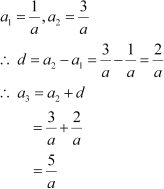
Thus, missing term, a3
(ii) In the given A.P.,
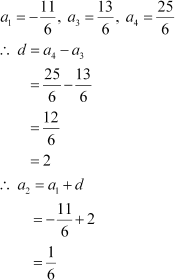
Thus, missing term, a2 =
Example 2: Find the first two terms of an A.P. in which the third term is 10 and the common difference is 7.
Solution:
Here, d = 7 and a3 = 10
Hence, the value of a2 can be found by subtracting 7 from a3.
∴ a2 = 10 − 7 = 3
Similarly, the value of a1 can be found by subtracting 7 from a2.
∴ a1 = 3 − 7 = −4
Thus, the first two terms of the A.P. are –4 and 3.
1.Similar Figures
Difference Between Similarity and Congruence
Similar figures and congruent figures may appear to be closely related concepts, but there is an important difference between them.
Congruency of line segments:
“Two line segments are congruent to each other if their lengths are equal”.
Consider the following line segments.

Here, the line segments AB and PQ will be congruent to each other, if they are of equal length.
Conversely, we can say that, “Two line segments are of equal length if they are congruent to each other”.
i.e. if  , then AB = PQ.
, then AB = PQ.
Congruency of angles:
“Two angles are said to be congruent to each other if they have the same measure”.
The angles shown in the following figures are congruent to each other as both the angles are of the same measure 45°.
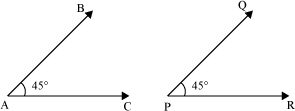
Thus, we can write ∠BAC ≅ ∠QPR.
Its converse is also true.
“If two angles are congruent to each other, then their measures are also equal”.
There is one special thing about congruent figures that their corresponding parts are always equal.
For example, if two triangles are congruent then their corresponding sides will be equal. Also, their corresponding angles will be equal.
Look at the following triangles.
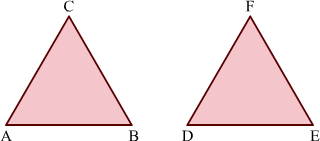
Here, ∆ABC  ∆DEF under the correspondence ∆ABC ↔ ∆DEF. This correspondence rule represents that in given triangles, AB ↔ DE (AB corresponds to DE), BC ↔ EF, CA ↔ FD, ∠A
∆DEF under the correspondence ∆ABC ↔ ∆DEF. This correspondence rule represents that in given triangles, AB ↔ DE (AB corresponds to DE), BC ↔ EF, CA ↔ FD, ∠A
— ∠D, ∠B ↔ ∠E, ∠C ↔ ∠F. These are corresponding parts of congruent triangles (CPCT), ∆ABC and∆DEF.
Since ∆ABC and ∆DEF are congruent, their corresponding parts are equal. Therefore, AB = DE, BC = EF, CA = FD
And, ∠A = ∠D, ∠B = ∠E, ∠C = ∠F
Similarly, we can apply the method of CPCT on other congruent triangles also. Let us now try and apply what we have just learnt in some examples.
Example 1: Find which of the pairs of line segments are congruent.
(i)

(ii)

Solution:
(i) Lengths of the two line segments are not same. Therefore, they are not congruent.
(ii) Each of the line segments is of length 3.1 cm, i.e. they are equal. Therefore, they are congruent.
Example 2: If  and
and  = 9 cm, then find the length of
= 9 cm, then find the length of  . Solution:
. Solution:
 Since
Since , i.e. line segment AB is congruent to line segment PQ,
, i.e. line segment AB is congruent to line segment PQ,
therefore,  and are of equal length.
and are of equal length.
∴  = 9 cm
= 9 cm
Example 3: If ∠ABC ∠PQR and ∠PQR = 75o, then find the measure of ∠ABC. Solution:
If two angles are congruent, then their measures are equal.
Since ∠ABC ≅ ∠PQR,
∴ ∠ABC = ∠PQR T
herefore, ∠ABC = 75o
Example 4: Which of the following pairs of angles are congruent?
(i)
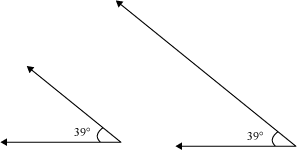
(ii)
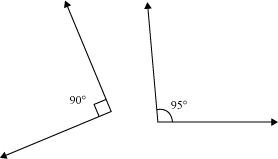
Solution:
(i) The measure of both the angles is the same. Therefore, they are congruent.
(ii) The measures of the two angles are different. Therefore, they are not congruent.
Example 5: Identify the pairs of similar and congruent figures from the following.
(i)

(ii)

(iii)

(iv)

(v)

(vi)

(vii)

(viii)

Solution:
Figures (i) and (iii) are similar because their corresponding angles are equal and their corresponding sides are in the same ratio. However, these figures are not congruent as they are of different sizes.
Figures (ii) and (viii) are congruent as they are of the same shape and size (circles with radius 1 cm each).
Example 6:
Are the following figures similar or congruent?

Solution:
The two given figures show two one-rupee coins. As both the figures represent the same coin in two different sizes, they are similar to each other. However, the pictures are not congruent because of their different sizes.
Example 7: In the following figure, ΔPQR and ΔSTU are congruent.
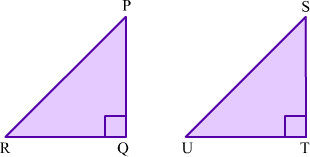
If PQ = 8 cm, QR = 6 cm then find the perimeter of ΔSTU.
Solution:
In ΔPQR, we have
PQ = 8 cm, QR = 6 cm and ∠Q = 90°
Applying Pythagoras theorem in ΔPQR, we obtain
RP2 = PQ2 + QR2
⇒ RP2 = 82 + 62
⇒ RP2 = 64 + 36
⇒ RP2 = 100
⇒ RP = 10 cm
Since ΔPQR and ΔSTU are congruent, their corresponding parts will be equal. Therefore,
PQ = 8 cm = ST (CPCT)
QR = 6 cm = TU and (CPCT) RP = 10 cm = US (CPCT)
∴ Perimeter of ΔSTU = ST + TU + US = 8 cm + 6 cm + 10 cm = 24 cm
Basic Proportionality Theorem and Its Converse
Consider the following figure.
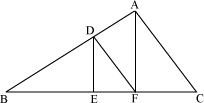
In the above figure, DE is parallel to AF and DF is parallel to AC. Can we say that point E divides BF in the same ratio in which point F divides BC?
For this, we have to prove that  .
.
To prove it, we should have the knowledge of basic proportionality theorem (Thales theorem).
 Now, let us solve the problem discussed in the beginning with the help of BPT. In ABF, we know that AF is parallel to DE.
Now, let us solve the problem discussed in the beginning with the help of BPT. In ABF, we know that AF is parallel to DE.
Thus, using BPT,
 … (1)
… (1)
Similarly in ABC, DF is parallel to AC. Thus, using BPT,
ABC, DF is parallel to AC. Thus, using BPT,
 … (2)
… (2)
From equations (1) and (2), we obtain

Thus, we can say that point E divides BF in the same ratio in which point F divides BC. The converse of BPT is also true, which can be stated as follows.
“If a line divides any two sides of a triangle in the same ratio, then the line is parallel to the third side”.
Corollary of BPT:
If a line is drawn parallel to a side of a triangle, then the sides of the new triangle formed are proportional to the sides of the given triangle.
I.e, In the given figure, if DE || AB, then 
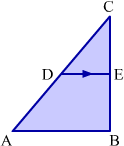
Applications of Basic Proportionality Theorem:
There are two very important properties based on BPT which are as follows:
- Property of intercepts made by three parallel lines on a transversal.
- Property of angle bisector of a triangle.
Let us discuss these properties in detail along with their proofs.
Property 1: Intercept Theorem
The lengths of the intercepts made by three parallel lines on one transversal are in the same ratio as the lengths of the corresponding intercepts made by the same lines on any other transversal.
Let us prove this property.
Given: line l || line m || line n
Transversal x intersects these lines at points P, Q and R while transversal y intersects these lines at points S, T and U.
To prove: 
Construction: Draw a line segment PU intersecting line m at point M.
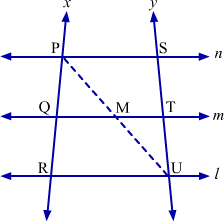
Proof:
In ΔPRU, we have QM || RU

Similarly, in ΔUSP, we have TM || SP

Hence proved.
Property 2: Angle Bisector Theorem
In a triangle, the angle bisector divides the side opposite to the angle in the ratio same as the ratio of remaining sides.
Let us prove this property.
Given: In ΔPQR, ray RT bisects ∠PRQ.
To prove: 
Construction: Draw a ray from Q parallel to ray RT such that it intersects extended PR at S.
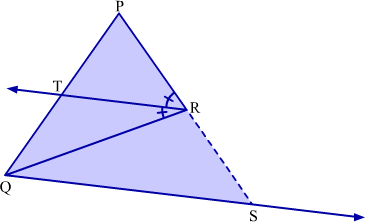
Proof:
We have,
RT || QS and PS is transversal
∴ ∠PRT = ∠RSQ ...(1) (Corresponding angles)
Considering other transversal RQ, we obtain
∠TRQ = ∠RQS ...(2) (Alternate angles) But ∠PRT = ∠TRQ (RT bisects ∠PRQ)
∴ ∠RSQ = ∠RQS [Using (1) and (2)]
Thus, in ΔRQS,
RS = RQ ...(3) (Side opposite to equal angles are equal) Now, in ΔPQS, we have
RT || QS

Hence proved.
Property 3: Converse of Angle Bisector Theorem
If a straight line through one vertex of a triangle divides the opposite side in the ratio of the other two sides, then the line bisects the angle at the vertex.
Let us prove this property.
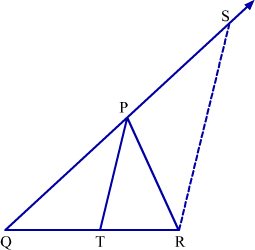
Given: In ΔPQR, line PT divides the opposite side BC internally such that.
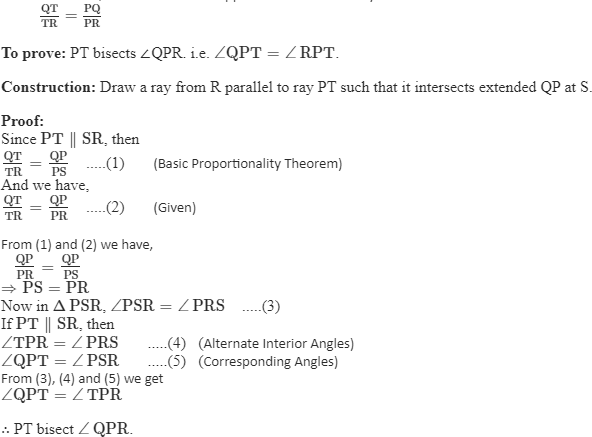
Hence proved.
These properties are very useful sometimes.
Let us now solve some examples based on BPT, its converse and properties related to BPT.
Example 1: In triangle ABC, D and E are points on the sides AB and AC, such that AB =11.2 cm, AD = 2.8 cm, AC = 14.4 cm, and AE = 3.6 cm. Show that DE is parallel to BC.

Solution:
It is given that,
AB = 11.2 cm, AD = 2.8 cm, AC =14.4 cm, and AE = 3.6 cm
Therefore, BD = AB – AD = 11.2 – 2.8 = 8.4 cm
And,
EC = AC –AE =14.4 – 3.6 = 10.8 cm
Now,

Thus, DE divides sides AB and AC of triangle ABC in the same ratio. Therefore, by the converse of BPT, we obtain that DE is parallel to BC.
Example 2: In the figure shown below, find the length of PM, if it is given that LM || QR. The corresponding measures are shown in the figure.
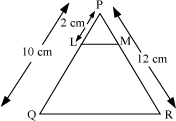
Solution:
Here, LM || QR
Then, using basic proportionality theorem, we obtain
![]()
Let PM = x cm
Then, MR = 12 – x cm And, PL = 2 cm
LQ = 10 cm – 2 cm = 8 cm
On putting these values in equation (i), we obtain

2(12 – x) = 8x
24 – 2x = 8x
24 = 8x + 2x
24 = 10x
x = 2.4 cm
Thus, PM = 2.4 cm
Example 3: If ABCD is a trapezium with AD || BC, then prove that ![]() , where O is the point of intersection of diagonals AC and BD.
, where O is the point of intersection of diagonals AC and BD.
Solution:
A trapezium has been shown in the following figure.
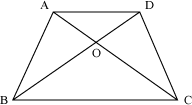
A line LM is drawn parallel to AD and BC and passing through O.
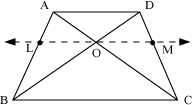
Here, LO || BC.
Using BPT in ΔABC,

Similarly, using BPT in ΔABD as LO || AD, we obtain

From equations (i) and (ii), we obtain

Hence, proved
Example 4: In ΔPQR, LM || QR and L is the mid-point of side PQ. Show that PM = MR.
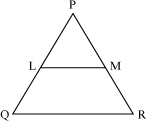
Solution:
Here, LM || QR
Using basic proportionality theorem (BPT),

Now, L is the mid-point of PQ.
∴ PL = LQ
Using this in equation (i), we obtain

∴ PM = MR
Hence, proved
Example 5: In trapezium ABCD, AB || EF || DC. Find the length of BF and FC.
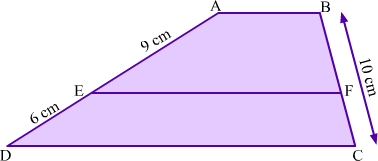
Solution:
In trapezium ABCD, AB || EF || DC.
Here, AD and BC are transversals to parallel segments AB, EF and DC.
Intercepts made by AD are AE and ED while intercepts made by BC are BF and FC. Using property of intercepts made by three parallel lines on a transversal, we obtain
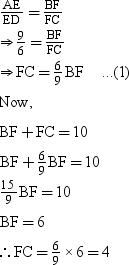
Thus, BF = 6 cm and FC = 4 cm.
Example 6: In ΔABC, BD bisects ∠ABC. Find the length of AD.
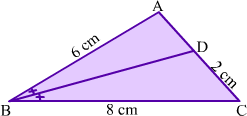
Solution:
In ΔABC, BD bisects ∠ABC
Thus, by using the property of angle bisector of a triangle, we obtain

⇒ AD = 1.5
Hence, the length of AD is 1.5 cm.
Example 7.
In the given figure, DE || AB. If perimeter of Δ ABC : perimeter of ΔCDE = 4:5 and DE = 1.2 cm, then find the length of AB.
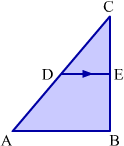
Answer:
It is given that, perimeter of ΔABC : perimeter of ΔCDE = 4:5 and DE = 1.2. InΔ ABC, DE || AB.
By applying the corollary of basic proportionality theorem, we get
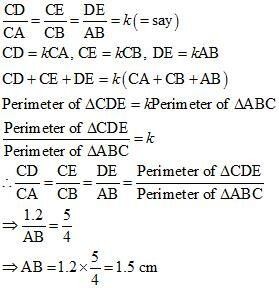
1.Distance Formula
Distance Formula
Let us consider the following graph.
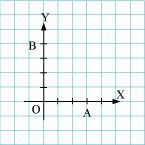
In the above figure, O is the origin, A is a point at a distance of 3 units on x-axis, and B is a point at a distance of 4 units on y-axis.
Can we find the distance between the two points A and B?
In coordinate geometry, the distance formula has a lot of applications. Let us look at one of its applications.
What can you say about the three points (–6, 10), (–1, 1), and (3, –8)? Are they collinear?
Let us see.
If the sum of the distances of any point from the other two is equal to the distance between the other two points, then we can say that the given points are collinear.
For example, let (–6, 10), (–1, 1), and (3, –8) be denoted by A, B, and C respectively.
Now, using distance formula, , we obtain
, we obtain
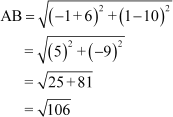
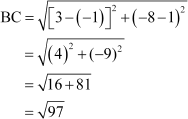
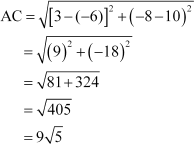
Here, AB + BC
≠ AC
Therefore, the points A, B, and C are not collinear.
Let us solve some more examples based on the distance formula.
Example 1: Find the distance between the point (7, –1) and origin.
Solution:
Let the points (7, –1) and origin (0, 0) be denoted by A and O respectively. Then, using distance formula, we obtain
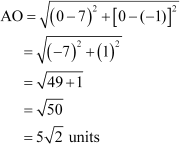
Thus, the distance between the points (7, –1) and (0, 0) is  units.
units.
Example 2: Find the value of a, if the distance between (a, –1) and (8, 3) is  .
.
Solution:
Let points (a, –1) and (8, 3) be denoted by A and B respectively. Then, using distance formula, we obtain

The distance is given as . Therefore, we can write
. Therefore, we can write

On squaring both sides, we obtain
16 × 5 = 64 + a2 – 16a + 16
⇒ 80 – 64 – 16 = a2 – 16a
⇒ 80 – 80 = a2 – 16a
⇒ a2 – 16a = 0
⇒ a (a – 16) = 0
∴ a = 0 and 16
Thus, the values of a are 0 and 16.
Example 3: Find the point on y-axis that is equidistant from (–5, 2) and (9, –2).
Solution:
The x-coordinate of all points on the y-axis is zero. Therefore, let (0, b) be the point which is equidistant from (–5, 2) and (9, –2).
∴ Distance between (0, b) and (–5, 2) = Distance between (0, b) and (9, –2) Using distance formula, we obtain

On squaring both sides, we obtain
29 + b2 – 4b = 85 + b2 + 4b
⇒ 8b = 29 – 85
⇒ 8b = –56
⇒ b = –7
Thus, the point (0, –7) on the y-axisis equidistant from (–5, 2) and (9, –2).
Example 4: Check whether the points (–3, –2), (–2, 3), and (3, 4) are the vertices of an isosceles triangle or not.
Solution:
Let the vertices (–3, –2), (–2, 3), and (3, 4) be denoted as A, B, and C respectively as shown in the figure.
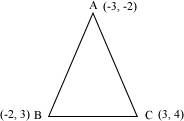
Using distance formula, we obtain
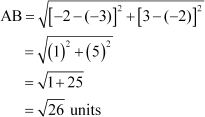
BC

AC

Now, AB = BC =  units
units
Thus, (–3, –2), (–2, 3), and (3, 4) are the vertices of an isosceles triangle.
1.Trigonometric Ratios
Trigonometric Ratios
Suppose a boy is standing in front of a lamp post at a certain distance. The height of the boy is 170 cm and the length of his shadow is 150 cm.
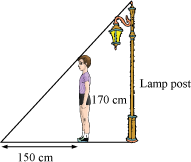
You can see from the above figure that the boy and his shadow form a right-angled triangle as shown in the figure below.
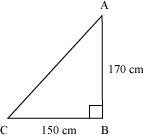
The ratio of the height of the boy to his shadow is 170:150 i.e., 17:15.
Is this ratio related to either of the angles of ΔABC?
We can also conclude the following:
cos A , tan A
, tan A
Also, note that
tan A =  and cot A =
and cot A =
Let us now solve some more examples based on trigonometric ratios.
Example 1: In a triangle ABC, right-angled at B, side AB = 40 cm and BC = 9 cm. Find the value of sin A, cos A, and tan A.
Solution:
It is given that AB = 40 cm and BC = 9 cm
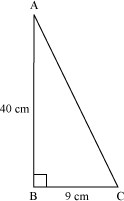
Using Pythagoras theorem in ΔABC, we obtain
(AC)2 = (AB)2 + (BC)2
(AC)2 = (40)2 + (9)2
(AC)2 = 1600 + 81
(AC)2 = 1681
(AC)2 = (41)2
AC = 41 cm
Now, sin A
cos A
tan A
Example 2: From the given figure, find the values of cosec C and cot C, if AC = BC + 1.
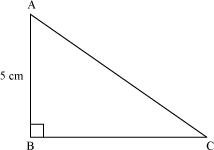
Solution:
Now, it is given that AB = 5 cm and
AC = BC + 1 … (1)
By Pythagoras theorem, we obtain
(AB)2 + (BC)2 = (AC)2
⇒ (AC)2 − (BC)2 = (AB)2
⇒ (BC + 1)2 – (BC)2 = (5)2 [Using (1)]
⇒ (BC)2 + 1 + 2BC – (BC)2 = 25
⇒ 2BC = 25 – 1
⇒ 2BC = 24
⇒ BC = 12 cm
∴ AC = 12 + 1 = 13 cm
Thus, cosec C =
=![]()
And, cot C =
=
Example 3: In a right-angled triangle ABC, which is right-angled at B, tan A  . Find the value of cos A and sec A.
. Find the value of cos A and sec A.
Solution:
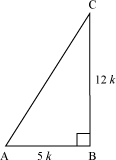
It is given that tan A
We know that tan A
⇒

Let BC = 12k and AB = 5k
Using Pythagoras theorem in ΔABC, we obtain
(AC)2 = (AB)2 + (BC)2
= (5k)2 + (12k)2
= 25k2 + 144k2
(AC)2 = 169k2
AC = 13k
Now, cos A

Sec A


Use Trigonometric Ratios In Solving Problems
If we know the value of a trigonometric ratio, then we can find the values of other trigonometric ratios and the value of any expression involving these trigonometric ratios.
Example1: If cot A  , then find the value of
, then find the value of .
.
Solution:
It is given that cot A  .
.
We know that
tan A

tan A = 3
Then ,
,

Example 2: Find the value of (sin2 θ + cos2 θ), if sec θ .
.
Solution:
We have sec θ  … (i)
… (i)
We know that sec θ 
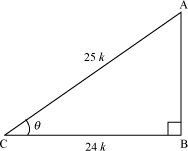
Let ABC be a triangle in which ∠C = θ, therefore we have
sec θ
From equations (i) and (ii), we have

Let us take AC = 25k and BC = 24k.
Using Pythagoras theorem, we have,
(AC)2 = (AB)2 + (BC)2
(25k)2 = (AB)2 + (24k)2
625k2 = (AB)2 + 576k2
AB2 = (625 − 576)k2
AB2 = 49k2
AB = 7k
∴ sin θ

cos θ

Now, sin2 θ + cos2 θ

= 1
∴ sin2 θ + cos2 θ = 1
1.Height and Distance
Some Applications of Trigonometry
Solving Real World Problems Involving Heights and Distances
Tushar is looking at the top of a tree. The height of Tushar is 1.6 m. The distance between the foot of the tree and Tushar is 12 m. The line joining his eye and the top of the tree makes an angle of 30° with the horizontal line. Tushar wants to know the height of the tree.
Can we help him?
In this way, we can find the unknown distance or height using the concept of trigonometric ratios. Let us discuss some examples based on problems related to heights and distances.
Example 1: A boy is looking at a ball on the ground from the top of a building which is ![]() high. If the distance between his eye and the ball is 40 m, then what will be the angle of depression and the distance between the foot of the building and the ball?
high. If the distance between his eye and the ball is 40 m, then what will be the angle of depression and the distance between the foot of the building and the ball?
Solution:
The diagram of this situation can be drawn as follows

Let the angle of depression be θ and the distance between the foot of the building and the ball be x m.
It is given that,
AC = line of sight = 40 m
AB = height of the building = ![]()
The angle of depression = ∠ACB = θ
Now, in right-angled triangle ABC, we have
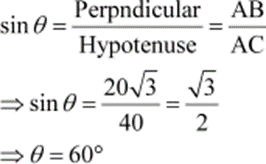
Thus, the angle of depression is 60°.
Again, in , we have
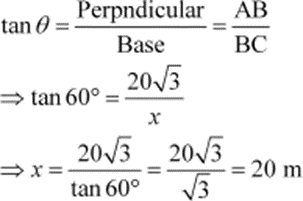
Thus, the distance between the foot of the building and the ball is 20 m.
Example 2: A man is standing at a distance of 20 m at a point C in front of a lamp post AB. The angle of elevation at point C is 60º. Find the distance covered by the man if he walks away from the lamp post so that the angle of elevation becomes 30°.
Solution:
The figure of this situation can be drawn as follows.

Let the man walk x m and reach at point D. Let the height of the lamp post AB be h. Now, in right-angled triangle ABC, we have

Thus, the height of the lamp post is . In , we have
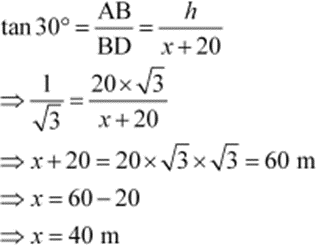
Thus, the required distance is 40 m.
Example 3: Two buildings are at a distance of ![]() from each other. A boy standing at the top of the smaller building is looking at the top and bottom of the other building. The angle of elevation and depression are 60° and 30° respectively. What will be the heights of the two buildings?
from each other. A boy standing at the top of the smaller building is looking at the top and bottom of the other building. The angle of elevation and depression are 60° and 30° respectively. What will be the heights of the two buildings?
Solution:
The given situation can be represented geometrically by the following figure.

Let the height of smaller building be x m and larger building be y m.
Here, the angle of elevation, i.e., ∠CAB = 60°
and the angle of depression, i.e., ∠BAD = 30°.
∠BAD and ∠ADE are alternate interior angles.
∴ ∠ADE = ∠BAD
= 30°
From the figure, we have
BD = AE = x
∴ BC = CD − BD
= y − x
Now, in right-angled![]() , we have
, we have
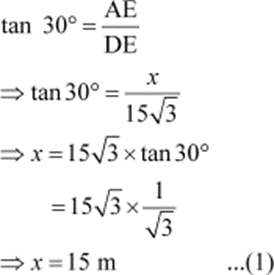
Now, in right angled ![]() , we have
, we have
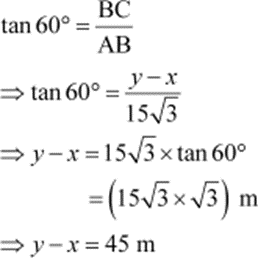
Using equation (1), we have
y − 15 = 45
⇒ y =45 + 15 = 60 m
Thus, the heights of the two buildings are 15 m and 60 m respectively.
1.Tangent to a Circle
Concept Of Tangent At Any Point Of The Circle
A circle has important elements such as chords, secants, and tangents.
A tangent at any point of a circle is perpendicular to the radius through the point of contact.
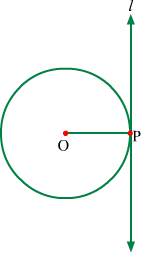
In the above figure O is the centre of circle, line l is the tangent and P is point of contact.
∴ l ∴ OP
Proof:
It is given that O is the centre of the circle, l is the tangent to this circle and P is the point of contact.
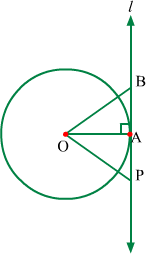
Let us assume l is not perpendicular to the radius of the circle.
In this case, let us draw perpendicular OA to tangent l. Thus, point A is distinct from point P.
Let B be any point on tangent such that BAP is a line and BA = AP.
Now, in ΔOAB and ΔOAP, we have
OA = OA (Common side)
∠OAB = ∠OAP (OA ⊥ tangent l)
BA = AP (By construction)
∴ ΔOAB  ΔOAP
ΔOAP
∴ OB = OP (By CPCT)
Since OB = OP, point B also lies on the circle.
Also, point B is different from point P.
Thus, tangent l touches the circle at two distinct points. This contradicts the definition of tangent.
Hence, our assumption is wrong.
Therefore, tangent l ⊥OP.
Hence proved.
The converse of this theorem is also true which states that:
The line perpendicular to the radius of a circle at its outer end is tangent to the circle.
Proof:
Let O be the centre of the circle, OP be the radius and l be the line perpendicular to OP such as it passes through point P on the circle.
Also, let A be any point on line l distinct from P.
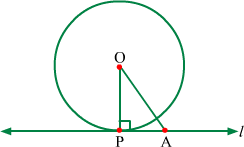
From the figure, it can be observed that ΔOAP is a right angled triangle.
∴ OA is hypotenuse for ΔOAP.
∴ OA > OP (Radius)
∴ OA is not radius.
∴ Point A does not lie on the circle.
∴ No point of line l other than P lies on the circle.
∴ P is the only point common to the circle and line l.
∴ Line l is tangent to the circle at point P. Hence proved.
Let us now solve some examples related to the tangents of the circle.
Example 1: Draw a circle with centre O, and two lines such that one is a tangent and other is a secant.
Solution:
The figure can be drawn as follows.
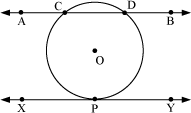
Here,  is the secant, which intersects the circle at C and D and
is the secant, which intersects the circle at C and D and  is a tangent whose point of contact with the circle is P.
is a tangent whose point of contact with the circle is P.
Example 2: Which of the following statements are correct?
(i) There can be only one tangent at a point on the circle.
(ii) Diameter is also a secant of the circle.
Solution:
(i) Correct
(ii) Incorrect
Example 3: A line XY is a tangent of the circle with centre O and radius 6 cm. The point of contact is P, and Q is any point on the tangent XY. If OQ = 10 cm, then what is the length of PQ?
Solution:
The figure can be drawn as follows.
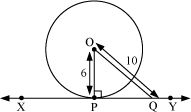
We know that the radius through the point of contact is perpendicular to the tangent.
∴ OP⊥XY
Using Pythagoras theorem in right-angled triangle OPQ, we obtain (OQ)2 = (OP)2 + (PQ)2
 (PQ)2 = (OQ)2 – (OP)2
(PQ)2 = (OQ)2 – (OP)2
 (PQ)2 = (10)2 – (6)2
(PQ)2 = (10)2 – (6)2
 (PQ)2 = 100 – 36
(PQ)2 = 100 – 36
 (PQ)2 = 64
(PQ)2 = 64
 PQ = 8 cm
PQ = 8 cm
Thus, the length of PQ is 8 cm.
Example 4: Two tangents XY and PQ are drawn at the ends of a diameter AB of the circle
 with centre O. Show that XY PQ.
with centre O. Show that XY PQ.
Solution:
The figure can be drawn as follows.
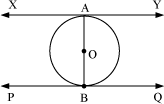
XY is a tangent at A and OA is the radius.
We know that the radius through the point of contact is perpendicular to the tangent.
∴ XY⊥OA
⇒ XY⊥AB … (1)
Similarly, PQ⊥AB … (2)
Now, the lines perpendicular to the same line are parallel.
∴ From equations (1) and (2), we obtain
XY || PQ
Hence, proved
Example 5: A circle is inscribed in a triangle such as it touches all the three sides of the triangle. Prove that the area of the triangle is half the product of its perimeter and the radius of circle.
Solution:
Let O be the centre of the circle inscribed in ΔABC.
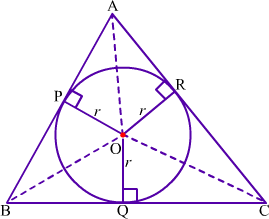
It can be seen that AB, BC and CA are tangents which touches the circle at P, Q and R respectively.
Also, OP, OQ and OR are the radii of the circle.
We know that a tangent at any point of a circle is perpendicular to the radius through the point of contact.
Therefore, AB ⊥ OP, BC ⊥ OQ and CA ⊥ OR.
Let s be the perimeter of ΔABC.
∴ s = AB + BC + CA
Now,
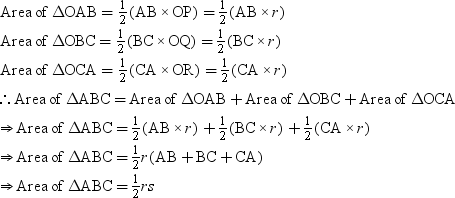
Hence proved.
Example 6: Observe the given figure.
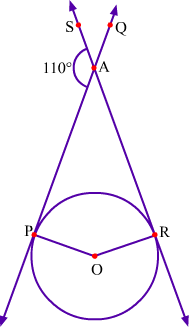
Find the angle between radii.
Solution:
In the given figure, O is the centre of the circle and OP and OR are the radii. Also, QP and SR are the tangents to the circle at points P and R respectively which intersect each other at point A.
It is given that,
∠PAS = 110°
We need to find the angle between radii OP and OR i.e., ∠POR.
From the figure, we have
∠PAS + ∠PAR = 180°
⇒ 110° + ∠PAR = 180°
⇒ ∠PAR = 180° – 110°
⇒ ∠PAR = 70°
We know that a tangent at any point of a circle is perpendicular to the radius through the point of contact.
Therefore, QP ⊥ OP and SR ⊥ OR.
∴ ∠APO = 90° and ∠ARO = 90°
Now, in quadrilateral APOR, we have
∠POR +∠APO + ∠ARO + ∠PAR = 360° (By angle sum property of quadrilaterals)
⇒ ∠POR + 90° + 90° + 70° = 360°
⇒ ∠POR + 250° = 360°
⇒ ∠POR = 110°
Thus, the angle between the radii is 110°.
1.Construction Of a Triangle
Division of a Line Segment into a Given Ratio
Vijay’s class teacher told him to mark two points A and B on a line segment PQ of length 10
cm such that  and
and  . He does not know how to construct it. Can we help him? Now let us try to mark a point B in the same way.
. He does not know how to construct it. Can we help him? Now let us try to mark a point B in the same way.
It is given that .
Let us take PB = x and BQ = 2x. It is also given that PQ = 10 cm.
But, PQ = PB + BQ
10 cm = x + 2x 3x = 10 cm
x = cm
cm
Now, it is difficult to mark a point B on the line segment PQ, since the value of x is in decimal form and even non-terminating.
We can observe that the marking of point A was only possible due to two factors.
1.We were able to measure the length of AQ and PA.
2. The length of the line PQ was divisible by the sum of the numerator and denominator in the ratio 3:2 i.e., the sum of numerator and denominator is 3 + 2 = 5. The length of PQ i.e., 10 cm was divisible by 5.
But in the second example, length of PQ is not divisible by the sum of the denominator and numerator of the given ratio. In order to carry out such constructions, we follow two methods. Let us learn each of these methods with the help of examples.
Let us suppose that we have to divide a line segment of 8.8 cm in the ratio 4:7.
Let us discuss one more example to understand the concept better.
Example: Draw a line segment of length 6.2 cm and divide it in the ratio 5:3.
Solution:
To divide a line segment of length 6.2 cm in the ratio 5:3, we follow the below given steps.
1. We draw a line segment PQ of length 6.2 cm.
2. Now, we draw a ray PX making an acute angle with PQ and draw a ray QY parallel to PX by making ∠PQY equal to ∠QPX.
3. We locate 5 points P1, P2, P3, P4, and P5 on PX and 3 points Q1, Q2, and Q3 on QY such that PP1 = P1P2 = P2P3 = P3P4 = P4P5 = QQ1 = Q1Q2 = Q2Q3.
4. Now, we join P5Q3 which intersects PQ at R.
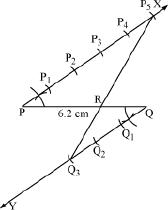
Now, R is the point on PQ which divides the line segment PQ in the ratio 5:3.
Construction Of A Triangle Similar To The Given Triangle
Consider the following triangle ABC.
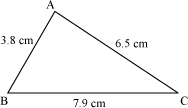
In the above figure, the measures of the sides AB, BC, and CA are given as 3.8 cm, 7.9 cm, and 6.5 cm respectively.
Can we construct a triangle similar to ΔABC and whose sides are of the sides of ΔABC?
of the sides of ΔABC?
Example 1: Construct a triangle similar to the following triangle with sides  of the sides of the given triangle.
of the sides of the given triangle.
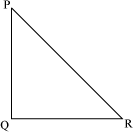
Solution:
Firstly, we draw a ray QX making an acute angle with QR on the side opposite to vertex P and mark 5 points (corresponding to the greater of 2 or 5) X1, X2, X3, X4, and X5 on QX such that QX1 = X1X2 = X2X3 = X3X4 = X4X5.
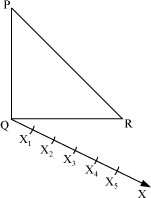
Now, we join X2R (corresponding to the denominator of the given ratio) and draw a line passing through X5 (corresponding to the numerator of the given ratio) and parallel to X2R. Let this line intersect the extended line QR at point R′. Now, we draw a line passing through R′ and parallel to RP, which intersects the extended line PQ at point P′.
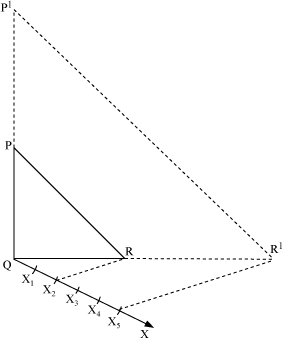
Thus, P′QR′ is the required triangle which is similar to the given triangle and with sides  of the sides of the given triangle.
of the sides of the given triangle.
1.Perimeter and Area of a Circle
Areas Related to Circles
Length of Arc and Area of Sector of Circle
Some important formulae to remember are:
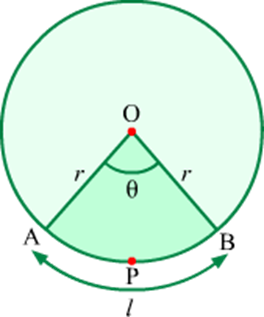

In case of quadrant, θ = 90°. Therefore,

In case of semicircle, θ = 180°. Therefore,

![]()
Relation between the area of sector and the length of an arc:
Look at the following figure.
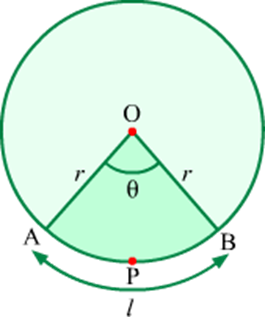
Here, O is the centre of the circle of radius r and APB is an arc of length l.
Clearly, measure of arc APB = Central angle = θ
Let the area of sector OAPB be A.
Now, we have

From length of arc and area of corresponding sector, we can also conclude that.
![]()
These formulae are very helpful to calculate various attributes related to circle. Let us solve some examples to learn the concept better.
Example 1: Find the area of the sectors OACB and OADB. Also find the length of the arc ACB. (Take π =![]() )
)
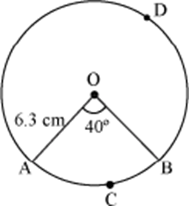
Solution:
Given, radius of the circle, r = 6.3 cm
Angle of sector OACB, θ = 40°
![]()
θ360×πr2
![]()
= 13.86 cm2
And, area of sector OADB = πr2 − area of the sector OACB
![]()
= 124.74 − 13.86 cm2
= 110.88 cm2
Length of arc ACB = ![]()
![]() = 4.4 cm
= 4.4 cm
Example 2: Find the area swept by the hour hand of length 10 cm of a clock when it moves from 2 p.m. to 4 p.m. Also find the length covered by the tip of the hour hand during that time. (Take π =3.14)
Solution:
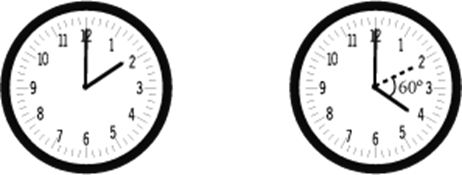
When an hour hand moves from 2 p.m. to 4 p.m., it moves for 2 hours.
The hour hand takes 12 hours to complete 1 rotation i.e., to rotate 360°.
In 1 hour, it will rotate = ![]()
In 2 hours, it will rotate = 30° × 2 = 60°
Therefore, when it moves from 2 p.m. to 4 p.m., it sweeps an area equal to the area of a sector of angle 60°.
Radius of this sector = length of the hour hand = 10 cm
∴ Area swept ![]()
= 52.33 cm2 (approx.)
Length covered by the tip ![]()
= 10.47 cm (approx.)
Example 3: If the area and length of the arc of a sector are ![]() cm2 and
cm2 and ![]() cm respectively, then find out the radius of the circle and the angle of sector.
cm respectively, then find out the radius of the circle and the angle of sector.
Solution:
Let r be the radius of the circle and θ be the angle of sector.
It is given that the area of the sector is ![]() cm2.
cm2.
![]()
Also, the length of the arc is![]() cm.
cm.
⇒ ![]() =
=![]() … (2)
… (2)
On dividing Equation (1) with Equation (2), we obtain

![]()
![]() cm
cm
On putting the value of r in equation (1), we obtain
= ![]()
![]()
![]()
Thus, the radius of the circle is 16 cm and the angle of the sector is 105°.
Example 4: Find the area of the sector OAXB and length of the arc AXB for the given figure.

Solution:
In the figure, OA = AB = OB (All are of length 7 cm) Hence, ΔOAB is an equilateral triangle.
∴ ![]()
⇒ θ = 60°
Area of the sector = ![]() cm2
cm2
Length of the arc = ![]() cm
cm
Example 5: A truck has two wipers which do not overlap and each wiper has a blade of length 28 cm sweeping through an angle of 90°. What is the total area cleaned at each sweep of the blades?
Solution:
It is clear that each wiper sweeps a quadrant of a circle of radius 28 cm.
Area cleaned at each sweep =
Example 6: Radius of a circle is 14 cm. What is the area of the sector corresponding to the arc of length 20 cm?
Solution:
Radius of circle (r) = 14 cm
Length of arc (l) = 20 cm

Example 7: Area of a sector of a circle whose radius is 12 cm is 132 cm2. Find the measure of central angle and length of the corresponding arc.
Solution:
Area of sector (A) = 132 cm2
Radius of circle (r) = 12 cm
Let the measure of central angle be θ and length of arc be l.
Now, we have
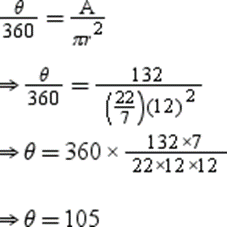
Thus, the central angle measures 105°.
Also, we have
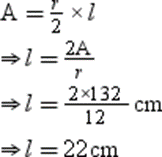
1.Surface Area and Volume of Different Solid Shapes
Curved Surface Area Of Combination Of Solids
We know how to find the curved surface areas of three-dimensional figures such as cone, cylinder, sphere, etc. Now, we will learn to find out the curved surface area of a combination of solids.
Let us consider the following figure.
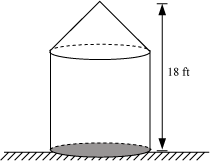
The given figure shows a temple. In this figure, the base of the temple is a right circular cylinder and the top is a right circular cone. The height of the conical part is half the height of the cylindrical part and the radius of the base of the temple is 2 ft more than the height of the conical part. The temple has to be plastered from outside at the rate of Rs 5 per square foot.
Can we find the approximate cost of plastering the temple from outside?
In order to find the cost, we have to find the curved surface area of the temple. By adding the curved surface areas of cone and cylinder, we can obtain the curved surface area of the temple.
First of all, let us review the formulae to find the curved surface areas of different solids. The formulae for different solids are given in the following table.
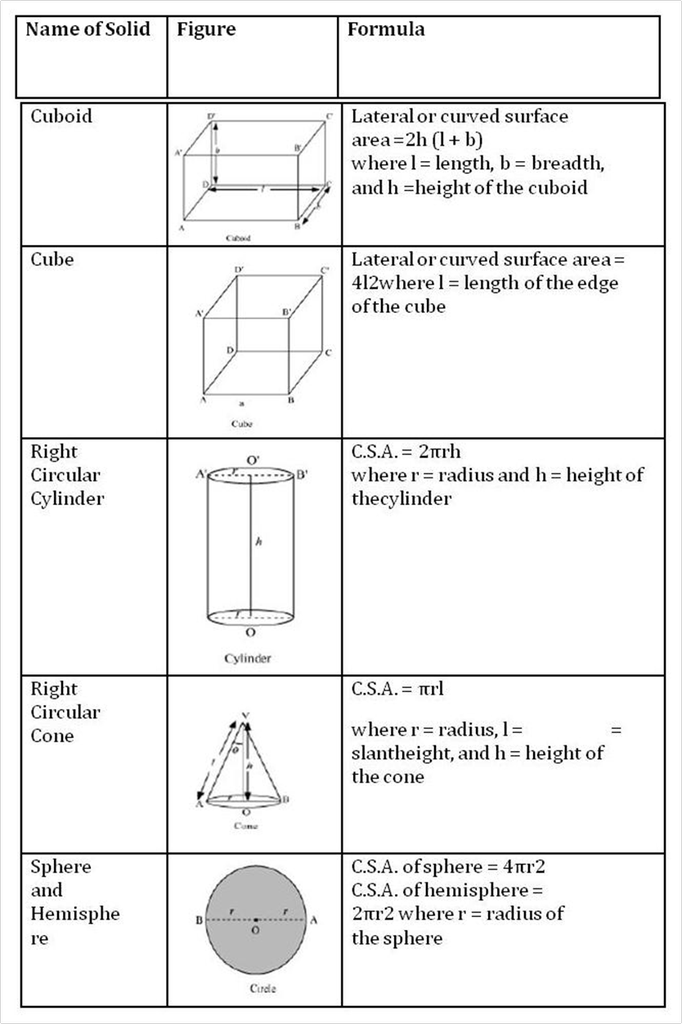
In this way, we can find the curved surface area of a combination of solids. Now, let us solve some more examples to understand the concept better.
Example 1: A toy is in the form of a hemisphere mounted by a cone. The diameter of the hemisphere is 21 cm and height of the whole toy is 24.5 cm. If the surface of the
toy is painted at the rate of Rs 1 per 5 cm2, then find the cost required to paint the entire toy.
Solution:
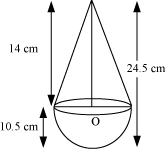
It is given that the diameter of the hemisphere is 21 cm.
∴ Radius of the hemisphere, r = 10.5 cm
Radius of the base of the cone, r = 10.5 cm
From the figure, height of cone, h = 24.5 − 10.5 = 14 cm
Now, l = =
= cm
cm
∴ Surface area of the toy = C.S.A. of hemisphere + C.S.A. of cone
= 2πr2 + πrl
= πr (2r + l)
=
= 22 × 1.5 × 38.5
= 1270.5 cm2
∴ Cost required for painting = 1270.5 ×  = Rs 254 approximately
= Rs 254 approximately
Example 2: The given figure shows a post office box. It was painted with red colour and it is observed that the ratio between the cost of painting the hemispherical part and the cylindrical part is 2:7. What is the ratio between the height of the box and the radius of the hemispherical part?

Solution:
As the box is painted with a constant cost, irrespective of the hemispherical part and the cylindrical part, we obtain

 , where r is the radius of the hemispherical part and h is height of the
, where r is the radius of the hemispherical part and h is height of the
cylindrical part
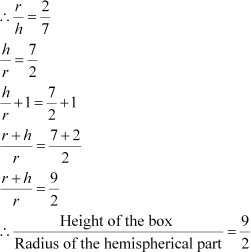
Thus, the ratio between the height of the box and the radius of the hemispherical part is 9:2.
Example 3: A tent is in the shape of a cylinder surmounted by a conical top. If the ratio of the height of the cylinder, the radius of cylinder, and the height of the cone is 8:4:3 and the cost of canvas required for making the tent is Rs 10560 at the rate of Rs 10 per m2, then find the height of the tent.
Solution:
Let us consider, height of cylinder = h’, radius of cylinder = r, and height of cone = h
Let h’ = 8x, r = 4x, and h = 3x
Then, l =  =
=  = 5x
= 5x

Amount of canvas =  m2
m2
However, amount of canvas = C.S.A. of cylinder + C.S.A. of cone
1056 = 2πrh’ + πrl
1056 = πr (2h’ + l)
1056 =
1056 =
264x2 = 1056
x2 =
 x = m
x = m
Height of tent = height of cylindrical part + height of conical part
= 8x + 3x
= 11x
= 11× 2
= 22
Thus, the height of the tent is 22 m.
Board question(s) related to this lesson:
Total Surface Areas Of Combination Of Solids
Total surface area of any solid is the sum of its curved surface area and bases. In many situations, we are required to find the total surface area of a combination of solids. Let us consider such a situation.
The largest possible hemisphere is taken out from a cube of side 10 cm. Can we find out the total surface area of the remaining solid?
To find it, consider the following figure.

From the cube, the largest hemisphere is taken out.
That means, diameter of hemisphere = edge of the cube = 10 cm
∴ Radius of the hemisphere =![]()
Total Surface area of the remaining solid = T.S.A. of cube without the circular base + C.S.A. of hemisphere

= 678.5 cm2
Thus, the required area is 678.5 cm2.
Let us solve some more examples to understand the concept better.
Example 1: From a cylinder of radius 7 m and height 24 m, a cone of same radius and same height is taken out. Find the surface area of the remaining part. If the inner portion of this remaining part is painted in pink colour at the rate of Rs 23 per 5 m2 and the exterior portion is painted in green colour at the rate of Rs 40 per 11 m2, then find the total cost required to paint such a solid.
Solution:
It is given that the radius and height of the cylinder and cone are the same. Let radius r = 7 m and height h = 24 m
Now, slant height of the cone, l = =
=  m
m
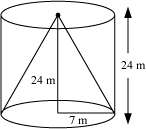
After taking out the cone from the cylinder,
T.S.A. of remaining outer part = C.S.A. of cylinder + Area of Circle
= 2πrh + πr2
= πr (2h + r)
= 
= 22 × 55
= 1210 m2
T.S.A. of remaining inner part = C.S.A. of cone
= πrl
=
= 550 m2
Cost of painting the exterior part =
Cost of painting the interior part =
∴ Cost of painting the remaining solid = 4400 + 2530 = Rs 6930
Thus, the required cost is Rs 6930.
Example 2: A right triangle, whose perpendicular sides are 30 cm and 40 cm, is made to revolve about its hypotenuse. Find the surface area of the double cone so obtained.
Solution:
Let ABD be the right-angled triangle such that AB = 30 cm and AD = 40 cm Using Pythagoras theorem, we obtain
BD2 = AB2 + AD2
BD2 =
BD =  cm
cm
Let OB = x and OA = y
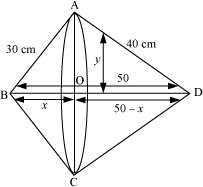
Applying Pythagoras theorem in ΔAOB, we obtain
OA2 + OB2 = AB2
x2 + y2 = 302
y2 = 900 − x2 … (1)
Applying Pythagoras theorem in ΔAOD, we obtain
OA2 + OD2 = AD2
y2 + (50 − x) 2 = 402
900 − x2 + 2500 + x2 − 100x = 1600 {From equation (1), we have y2 = 900 − x2}
100x = 1800
x = 18
On putting this value in equation (1), we obtain
y2 = 900 − x2 = 900 − 182 = 900 − 324 = 576
y = cm
cm
Here, y is the radius of both the cones.
Now, surface area of the solid = C.S.A. of cone ABC + C.S.A. of cone ADC
= π × 24 × 30 + π × 24 × 40
= 1680 π
= 1680 ×
= 5280 cm2
Thus, the surface area of the double cone so obtained is 5280 cm2.
Example 3: The inner and outer radii of a cylindrical iron container are 10 cm and 11 cm respectively. The thickness of the base is 1.5 cm and the total height of the container is 21.5 cm. Find the cost, if the container has to be thoroughly electroplated with silver metal at the rate of 70 paise per cm2.
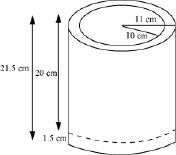
Solution:
To find out the cost, we have to find out the T.S.A. of the container.
Height of the base, h = 1.5 cm
∴Height of the hollow cylinder, H = 21.5 − 1.5 = 20 cm
External radius, R = 11 cm and internal radius, r = 10 cm
T.S.A. of the container = Outer C.S.A. of hollow cylinder + Inner C.S.A. of hollow cylinder + Area of the ring + C.S.A. of solid cylinder + Area of inner base + Area of outer base
= 2π RH + 2πrH + π (R2 − r2) + 2πRh + πr2 + πR2
= 2π (R + r) H + π (R2 − r2) + π (2Rh + r2 + R2)
=
=
= 2640 + 66 +
 = cm2
= cm2
∴ Cost of electroplating = × 70 = 245300 paise = Rs 2453
× 70 = 245300 paise = Rs 2453
Thus, the required cost is Rs 2453.
Volume Of Combination Of Solids
We come across many figures in our daily life that are made up of two or more solid figures. Let us consider such an example.
A company produces metallic solid toys that are in the shape of a cylinder with one hemisphere and one cone stuck to their opposite ends. The length of the entire toy is 30 cm; the diameter of the cylinder is 14 cm, while the height of the cone is 10 cm.
Can we find out how much metal should the company order to make 200 toys of this type?
In this way, we can find the volume of any solid figure which is formed by combining two or more basic solids. Let us now look at some more examples.
Example 1: A largest cone is to be taken out from a cube of edge 15 cm. Find the volume of the remaining portion. (Use π = 3.14)
Solution:
The figure can be drawn as follows:
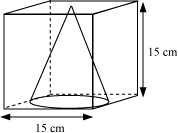
It is given that length of the cube, l = 15 cm
The base of the cone is a circle whose diameter is equal to the length of the edge of the cube.
∴ Radius of cone, r =  cm
cm
The height of the cone would be equal to the height of cube.
∴ Height of cone, h = 15 cm
Volume of the remaining portion = Volume of Cube − Volume of Cone
=
=
= 3375 − 883.125
= 2491.875 cm3
Thus, the volume of the remaining portion is 2491.875 cm3.
Example 2: A plastic toy is in the following shape. The diameter of the cylindrical shape is 7 cm, but the bottom of the toy has a hemispherical raised portion. The top of the toy is a cone of same base. If the height of the cylinder is 21 cm and cone is 4
cm, find the amount of air inside the toy. (Use π = )
)
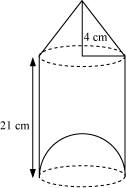
Solution:
Diameter of the cylinder = 7 cm
Radius of cylinder, r =  cm
cm
r =  , is also the radius for cone and hemisphere.
, is also the radius for cone and hemisphere.
Height of the cylinder, H = 21 cm
Height of the cone, h = 4 cm
∴ Volume of the toy = Volume of cylinder + Volume of Cone − Volume of Hemisphere
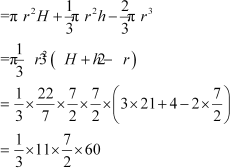
= 770 cm3
Thus, the volume of air inside the given toy is 770 cm3.
Example 3: A right triangle, whose perpendicular sides are 30 cm and 40 cm, is made to revolve about its hypotenuse. Find the volume of figure so obtained in terms of π.
Solution:
Let ABD be a right-angled triangle, such that AB = 30 cm and AD = 40 cm.
Using Pythagoras theorem, we have
BD2 = AB2 + AD2
BD2 =
BD =  cm
cm
After revolution, we have the following figure.
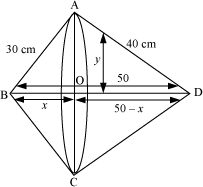
Let OB = x and OA = y
Using Pythagoras theorem in triangle AOB, we obtain
OA2 + OB2 = AB2
x2 + y2 = 302
y2 = 900 − x2 … (1)
Using Pythagoras theorem in triangle AOD, we obtain
OA2 + OD2 = AD2
y2 + (50 − x)2 = 402
900 − x2 + 2500 + x2 − 100x = 1600 {using equation (1)}
100x = 1800
x = 18
On putting the value of x in equation (1), we obtain
y2 = 900 − x2 = 900 − 182 = 900 − 324 = 576
y =  cm
cm
Here, y is the radius of the cones ABC and ADC.
Now, height of the cone ABC, x = 18 cm
Height of the cone ADC, 50 − x = 32 cm
Volume of the double cone = Volume of cone ABC + Volume of cone ADC
=
=
=
= 9600π cm3
Thus, the volume of the figure so obtained is 9600π cm3.
Example 4: An iron container is cylindrical in shape as shown in the figure. The inner and outer diameters are 12 cm and 14 cm respectively. The container has a solid base of width 1.5 cm and the total height of the container is 22.5 cm. If the mass of 1 cm3 of iron is 8 gm, find the weight of the container.
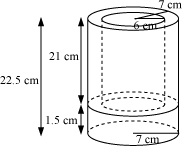
Solution:
The iron container consists of two cylinders.
- A solid cylinder and
- A hollow cylinder
External and internal diameters of the hollow cylinder are 14 and 12 cm respectively.
Hence, internal radius, r = 6 cm and external radius R = 7 cm
Height of the solid cylinder, h = 1.5 cm
∴ Height of the hollow cylinder, H = 22.5 − 1.5 = 21 cm
Volume of the iron used in the container = Volume of solid cylinder + Volume of hollow cylinder
 =
=
 =
=
= 231 + 858
= 1089 cm3
Mass of 1 cm3 of iron = 8 gm
Mass of 1089 cm3 of iron = 1089 × 8 = 8712 gm = 8.712 kg
Thus, the weight of the container is 8.712 kg.
1.Mean of Grouped Data
Mean Of Grouped Data Using The Direct Method
A cricket player played 7 matches and scored 88, 72, 90, 94, 56, 62, and 76 runs. What is the average score or mean score of the player in these 7 matches?
We know that,
“The mean is the sum of all observations divided by the number of observations”.
We can use the following formula to find the mean of the given data.

Using this formula, the mean of scores obtained by the player

 = 76.86
= 76.86
Thus, the average score of the player is 76.86. There are many situations where the number of observations is very large and then it is not possible to use this formula to find the mean of the given data.
Let us consider such a situation.
We have the marks distribution of 100 students of a class in a Mathematics test. The
distribution is given in the form of groups like 0 − 10, 10 − 20 …. To find the mean in such situations, we follow another method.
Example 1: The following table shows the various income brackets of the employees of a company.

Find the average monthly income of each employee.
Solution:
Firstly, we will calculate the class marks of each class interval and then the product of the class marks with the corresponding frequencies. By doing so, we obtain the following table.
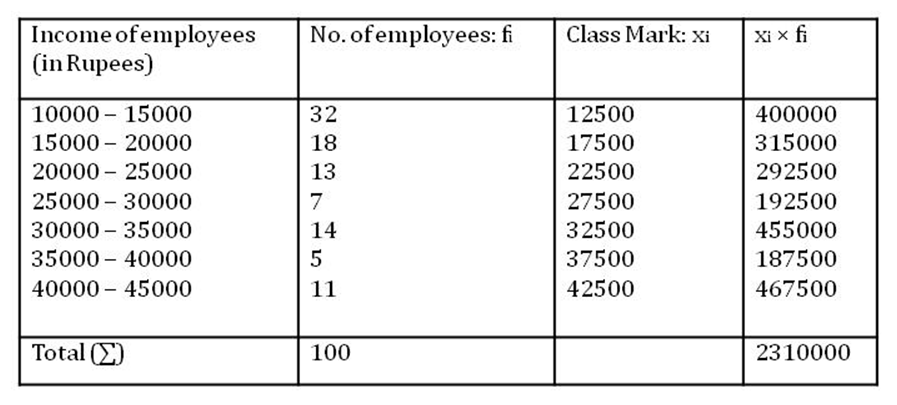
The mean can now be easily calculated using the formula.
Mean 

Hence, the average income of the employees is Rs 23100.
Example 2: The mean of the following frequency distribution is 62.8 and the sum of all the frequencies is 50. Find the value of f1 and f2.
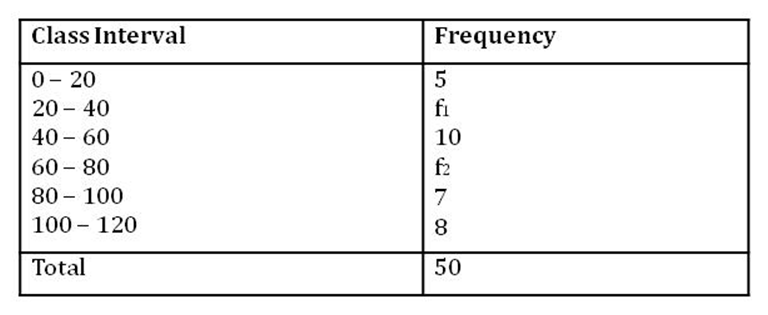
Solution:
Firstly, let us find the class marks of each class interval and then the product of class marks with the corresponding frequencies for each class interval as shown in the following table.
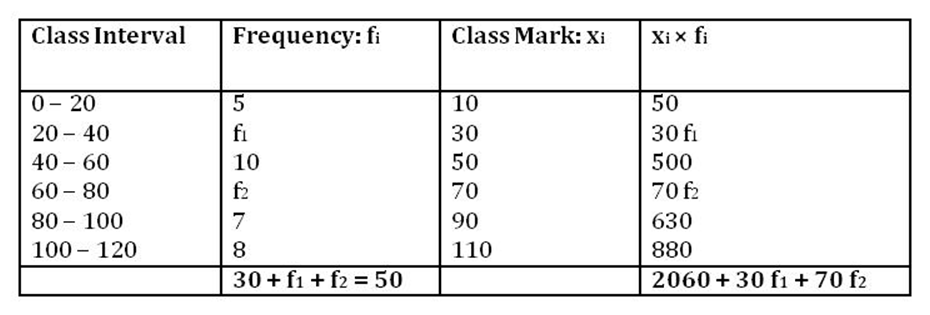
It is given that the sum of the frequencies is 50.
∴ 30 + f1 + f2 = 50
f1 + f2 = 20
f1 = 20 − f2 … (1)
The mean is given as 62.8.
∴  = 62.8
= 62.8




Using equation (1),
30(20 − f2) + 70 f2 = 1080
600 + 40 f2 = 1080
40 f2 = 1080 − 600 = 480
f2 =
On putting the value of f2 in equation (1), we obtain
f1 = 20 − f2 = 20 − 12 = 8
Thus, the values of f1 and f2 are 8 and 12 respectively.
Mean Of Grouped Data Using Assumed Mean Method
We know that direct method can be used to find the mean of any data given in grouped form, but the calculation in direct method becomes very tough when the data is given in the form of large numbers, because finding the product of xi and fi becomes difficult and time consuming.
Therefore, we introduce assumed mean method to find the mean of grouped data. This method is also known as shift of origin method. This is an easier method to find the mean as it involves less calculation.
Example 1: The following table shows the life time (in hours) of 20 bulbs manufactured by a reputed company.
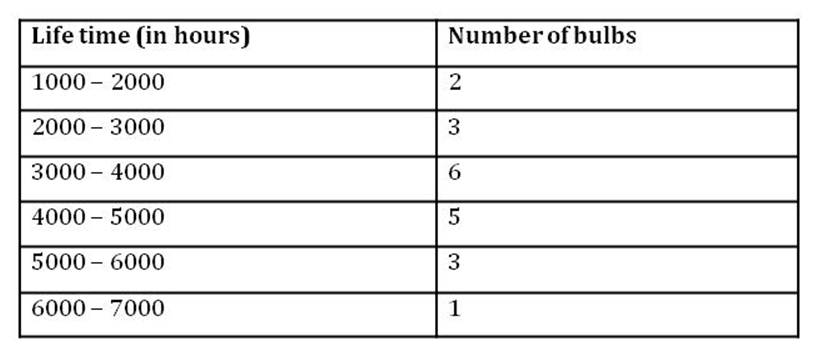
Find the average life time of a bulb in hours. Solution:
Firstly, we calculate the class mark of each class-interval and assume one of them as the assumed mean. Here, we take a = 3500. The calculations of the deviations and the product of the deviations with the corresponding frequencies have been represented in the following table.
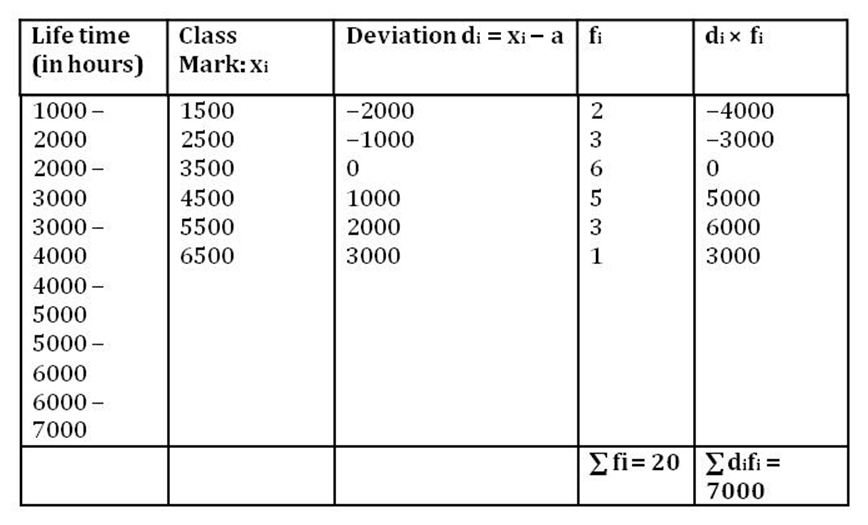
Using the formula,

= 3500 + 350
= 3850
Thus, the average lifetime of a bulb is 3850 h.
Example 2:
The following table shows the percentage of girls in the top 33 schools of Delhi.
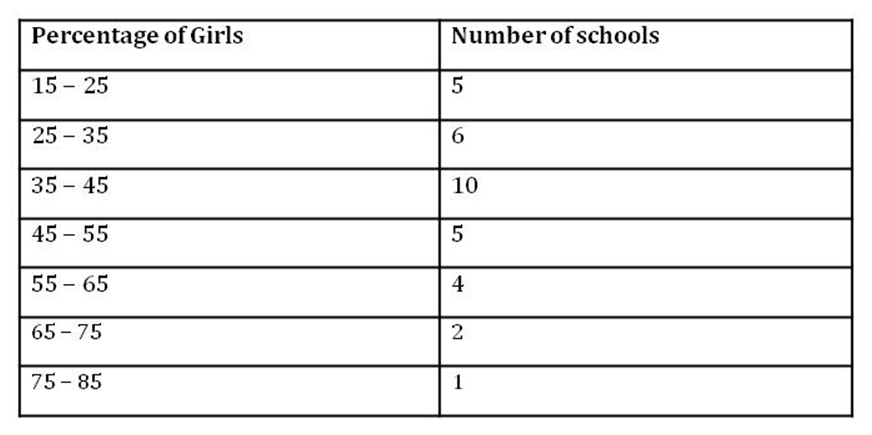
Find the mean percentage of girls by using the assumed mean method.
Solution:
Firstly, we calculate the class mark of each class-interval and assume one of them as the assumed mean. Here, we take a = 50. The calculations of the deviations and the product of the deviations with the corresponding frequencies have been represented in the following table.
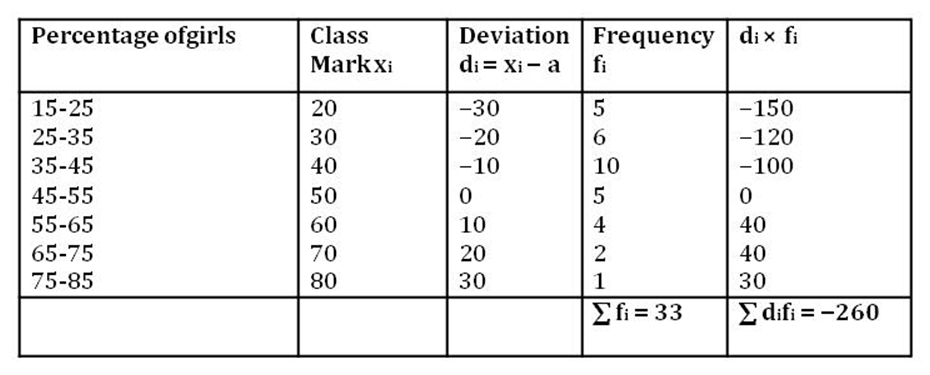
Using the formula,  , we obtain
, we obtain

Thus, the mean of the given data is 42.12 i.e., the mean percentage of girls in the 33 schools of Delhi is 42.12.
Mean Of Grouped Data Using Step Deviation Method
In the assumed mean method, we assume the mean as a from the class-marks and we use the following formula to find the actual mean.

Where, di is the deviation of a from xi.
When the data is given in the form of large numbers, then sometimes it is difficult and even lengthy to find the mean by using the assumed mean method. In such cases, we follow another method called step deviation method or shift of origin and scale method. Using this method, we can further reduce the calculation.
Example 1: Calculate the mean of the following data using step deviation method.

Solution:
Let us assume a = 50
Let us calculate the deviations of class marks from the assumed mean a. The calculations are shown in the following table.
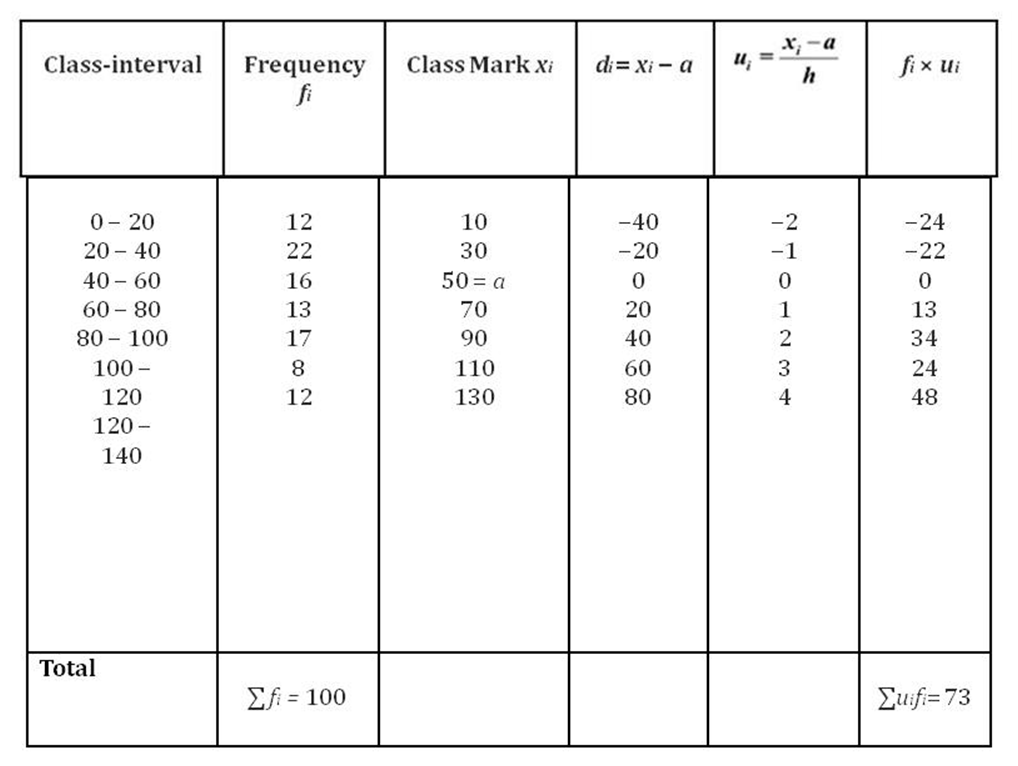
Highest common factor of all the di’s = h = 20
Now, using the formula ,  we obtain
we obtain
![]() Thus, the mean of the given data is 64.6.
Thus, the mean of the given data is 64.6.
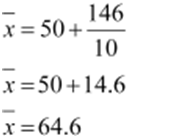
1.Theoretical Approach to Probability
Theoretical and Experimental Probability
Consider an experiment of tossing a coin. Before tossing a coin, we are not sure whether head or tail will come up. To measure this uncertainty, we will find the probability of getting a head and the probability of getting a tail.
A student tosses a coin 1000 times out of which 520 times head comes up and 480 times tail comes up.
The probability of getting a head is the ratio of the number of times head comes up to the total number of times he tosses the coin.
Probability of getting a head
= 0.52
Similarly, probability of getting a tail
= 0.48
These are the probabilities obtained from the result of an experiment when we actually perform the experiment. The probabilities that we found above are called experimental (or empirical) probabilities.
On the other hand, the probability we find through the theoretical approach without actually performing the experiment is called theoretical probability.
The theoretical probability (or classical probability) of an event E, is denoted by P(E) and is defined as
P(E) 
Here, we assume that the outcomes of the experiment are equally likely.
When a coin is tossed, there are two possible outcomes. We can either get a head or a tail and these two outcomes are equally likely. The chance of getting a head or a tail is 1.
Thus, probability of getting a head
P(E)
Similarly, probability of getting a tail =
Here, (or 0.5) is the theoretical probability.
(or 0.5) is the theoretical probability.
Relation between Experimental and Theoretical Probabilities:
There is a fact that the experimental probability may or may not be equal to the theoretical probability.
For example, if we take a coin and toss it by a particular number of times then the theoretical probability of getting a head or a tail will be  in each trial, but if we observe the outcomes of all the trials and calculate the experimental probability for head or tail then it will not be exactly equal to theoretical probability.
in each trial, but if we observe the outcomes of all the trials and calculate the experimental probability for head or tail then it will not be exactly equal to theoretical probability.
For approval, we can consider the theoretical and experimental probabilities of getting tail in the above experiment.
We have:
Theoretical probability of getting head = 0.52
Also, in our experiment we obtained:
Experimental probability of getting tail = 0.5
It can be observed that experimental probability is not exactly equal to theoretical probability, but very close to it.
Also, experimental probability of the same event can vary according to the number of trials.
Probability
Consider an experiment where two coins are tossed simultaneously. So, can you find out the probability of getting at least one head?
In this experiment, we are not actually performing the experiment. Therefore, here we can find the probability of getting at least one head using theoretical approach.
The theoretical probability for an event E can be defined as follows.

Using this formula, let us try to find the probability of getting at least one head.
The numbers of possible outcomes by tossing two coins simultaneously are as follows. HH, HT, TH, TT
∴ Total number of outcomes = 4
The favourable outcomes for getting at least one head are HH, HT, TH
∴ Number of favourable outcomes = 3
Probability of getting at least one head =
= 0.75
Let us consider some more examples and calculate the probability using theoretical approach.
Example 1: A dice is thrown and the number on the upper face of the dice is noted.
Find the probability of getting
(a) 3
(b) 7
(c) an odd number
(d) an even number
(e) a number less than or equal to 5
(f) a number greater than 2.
Solution:
When a dice is thrown, any of the numbers 1, 2, 3, 4, 5, and 6 can be on the upper face of the dice.
∴ Total number of outcomes = 6
(a) Getting 3
Here, the favourable outcome is only 3.
∴ Number of favourable outcomes = 1
∴ Probability of getting a number 3 on the upper face =
(b) Getting 7
There is no favourable outcome as we cannot get 7 by throwing a dice.
∴ Number of favourable outcomes = 0
∴ Probability of getting 7 on the upper face of the dice =
(c) Getting an odd number
The favourable outcomes are 1, 3, and 5.
∴ Number of favourable outcomes = 3
∴ Probability of getting an odd number =
(d) Getting an even number
The favourable outcomes are 2, 4, and 6.
∴ Number of favourable outcomes = 3
∴ Probability of getting an even number =
(e) Getting a number less than equal to 5
The favourable outcomes are 1, 2, 3, 4, and 5.
∴ Number of favourable outcomes = 5
∴ Probability of getting a number less than equal to 5 =
(f) Getting a number greater than 2
The favourable outcomes are 3, 4, 5, and 6.
∴ Number of favourable outcomes = 4
∴ Probability of getting a number greater than 2 =
Example 2: In tossing three coins simultaneously, find the probability of getting
Solution:
(a) at least one head
(b) at most one tail
(c) at most two heads
(d) exactly two heads
(e) at least one head but at most one tail
(f) no head at all
(g) at least one head but at most two heads
In tossing three coins, the possible outcomes are HHH, HTT, THT, TTH, HHT, HTH, THH, and TTT.
∴ Number of all possible outcomes = 8
(a) Let E be the event of getting at least one head.
The outcomes favourable to E are HHH, HTT, THT, TTH, HHT, HTH, and THH.
∴ Number of outcomes favourable to E = 7


(b) Let E be the event of getting at most one tail.
The outcomes favourable to event E are HHH, HHT, HTH, and THH.
∴ Number of outcomes favourable to E = 4


(c) Let E be the event of getting at most two heads.
The outcomes favourable to E are HTT, THT, TTH, HHT, HTH, THH and TTT.
∴ Number of outcomes favourable to E = 7


(d) Let E be the event of getting exactly two heads.
The outcomes favourable to E are HHT, HTH, and THH.
∴ Number of outcomes favourable to E = 3


(e) Let E be the event of getting at least one head but at most one tail.
The outcomes favourable to E are HHH, HHT, HTH and THH
∴ Number of outcomes favourable to E = 4


(f) Let E be the event of getting no head at all.
The outcome favourable to E is TTT.
∴ Number of outcomes favourable to E = 1


(g) Let E be the event of getting at least one head but at most two heads.
The outcomes favourable to E are HTT, THT, TTH, HHT, HTH, and THH.
∴ Number of outcomes favourable to E = 6


Example 3: In the experiment of throwing two dices, find the probability that the sum of two numbers appearing on the upper face is
(i) 7
(ii) greater than 11
Solution:
Let E denote the event of getting a sum 7 and F denote the event of getting a sum greater than 11.
The possible outcomes of this experiment have been shown in the following table.

Number of all possible outcomes = 36
(i) The outcomes favourable to E are (1, 6), (2, 5), (3, 4), (4, 3), (5, 2), and (6, 1).
Number of outcomes favourable to event E = 6


(ii) The outcome favourable to F is (6, 6).
Number of outcomes favourable to event F = 1


Example 4: 8 defective bulbs are accidentally mixed with 92 good bulbs. When one bulb is drawn at random, it is not possible to look at the bulb and say whether it is defective or non defective. What is the probability that the bulb drawn is non- defective?
Solution:
Let E be the event of drawing a non defective bulb. Total number of bulbs = 92 + 8
= 100
Number of non defective bulbs = 92
 ∴
∴
Example 5: From a pack of cards, five of club and spade, jack of heart, ten of diamond and spade, and queen of club is put aside and then the remaining cards are well shuffled. Find the probability of getting
(a) card of red queen
(b) a card of black queen
(c) a ten
(d) a five of club
(e) a jack
(f) an ace
(g) a face card
(h) a black face card
Solution:
After taking out 6 cards (five of club and spade, jack of heart, ten of diamond and spade, and queen of club) from 52 cards, we are left with 46 cards.
∴ Number of possible outcomes = 46
(a) Let E be the event of getting a card of red queen.
Number of outcomes favourable to E = 2 (A queen of diamond and a queen of heart)
∴
(b) Let E be the event of getting a card of black queen.
Number of outcomes favourable to E = 1 (Already queen of club is taken out)
∴
(c) Let E be the event of getting a card of ten.
Number of outcomes favourable to E = 2 (Ten of heart and club)
∴
(d) Let E be the event of getting a five of club.
Number of outcomes favourable to E = 0 (Already five of club is taken out)
∴
(e) Let E be the event of getting a jack.
Number of outcomes favourable to E = 3 (Already jack of heart is taken out)
∴
(f) Let E be the event of getting an ace.
Number of outcomes favourable to E = 4
∴
(g) Let E be the event of getting a face card.
Number of outcomes favourable to E = 10 (Already two face cards have been removed)
∴
(h) Let E be the event of getting a black face card.
Number of outcomes favourable to E = 5 (Already queen of club has been removed)
∴
Example 6: A bag contains 25 balls of red and green colour. If 3 red balls and 2 green balls are added, then the probability of getting green is twice the probability of getting red. Find the number of balls of each colour.
Solution:
Total numbers of balls in the bag = 25
Let the bag contain x number of red balls.
∴ Number of green balls = 25 − x
By adding 3 red balls and 2 green balls,
Total numbers of balls in the bag = 25 + 2 + 3 = 30
Number of red balls = x + 3
∴ Number of green balls = 25 − x + 2= 27 − x
The probability of ball of each colour is
 and
and
But it is given that
 = 2 ×
= 2 ×
 = 2 ×
= 2 × 
27 − x = 2x + 6
3x = 21
x = 7 (Number of red balls)
∴ Number of green balls = 25 − x = 25 − 7 = 18
Thus, the bag contains 7 red balls and 18 green balls.
Example 7: 25 cards numbered 6, 7, 8, 9, 10 … 30 are put in a box and mixed thoroughly. If one card is drawn at random, then find the probability that the number on the card is
(a) odd
(b) even
(c) prime
(d) divisible by 5
(e) divisible by both 2 and 5
Solution
We have, total number of cards = 25
∴ Total number of outcomes = 25
(a) Let E be the event of getting an odd number.
The favourable outcomes are 7, 9, 11, 13, 15, 17, 19, 21, 23, 25, 27, and 29.
∴ Number of outcomes favourable to E = 12
∴
(b) Let X be the event of getting an even number.
The favourable outcomes are 6, 8, 10, 12, 14, 16, 18, 20, 22, 24, 26, 28, and 30.
∴ Number of outcomes favourable to X = 13
∴
(c) Let F be the event of getting a prime number.
The favourable outcomes are 7, 11, 13, 17, 19, 23, and 29.
∴ Number of outcomes favourable to F = 7
∴
(d) Let Y be the event of getting a number divisible by 5.
The favourable outcomes are 10, 15, 20, 25, and 30.
∴ Number of outcomes favourable to Y = 5
∴
(e) Let G be the event of getting a number divisible by both 2 and 5 (i.e. getting a number divisible by 10).
The favourable outcomes are 10, 20, and 30.
∴ Number of outcomes favourable to G = 3
∴
Finding Probability Using Complement of a Known Event
Consider the experiment of throwing a dice. Any of the numbers 1, 2, 3, 4, 5, or 6 can come up on the upper face of the dice. We can easily find the probability of getting a number 5 on the upper face of the dice?
![]()
Mathematically, probability of any event E can be defined as follows.

Here, S represents the sample space and n(S) represents the number of outcomes in the sample space.
For this experiment, we have
Sample space (S) = {1, 2, 3, 4, 5, 6}. Thus, S is a finite set.
So, we can say that the possible outcomes of this experiment are 1, 2, 3, 4, 5, and 6.
 Number of all possible outcomes = 6
Number of all possible outcomes = 6
Number of favourable outcomes of getting the number 5 = 1
 Probability (getting 5)
Probability (getting 5)
Similarly, we can find the probability of getting other numbers also.
P (getting 1)  , P (getting 2)
, P (getting 2)  , P (getting 3)
, P (getting 3)  , P (getting 4)
, P (getting 4) and
and
P (getting 6)
Let us add the probability of each separate observation.
This will give us the sum of the probabilities of all possible outcomes.
P (getting 1) + P (getting 2) + P (getting 3) + P (getting 4) + P (getting 5) + P (getting 6) =  +
+ +
+ +
+ +
+ +
+ = 1
= 1
 “Sum of the probabilities of all elementary events is 1”.
“Sum of the probabilities of all elementary events is 1”.
Now, let us find the probability of not getting 5 on the upper face.
The outcomes favourable to this event are 1, 2, 3, 4, and 6.
 Number of favourable outcomes = 5
Number of favourable outcomes = 5
 P (not getting 5)
P (not getting 5)
We can also see that P (getting 5) + P (not getting 5)
 “Sum of probabilities of occurrence and non occurrence of an event is 1”.
“Sum of probabilities of occurrence and non occurrence of an event is 1”.
i.e. If E is the event, then P (E) + P (not E) = 1 … (1)
or we can write P(E) = 1 − P (not E)
Here, the events of getting a number 5 and not getting 5 are complements of each other as we cannot find an observation which is common to the two observations.
Thus, event not E is the complement of event E. Complement of event E is denoted by  or E'.
or E'.
Using equation (1), we can write
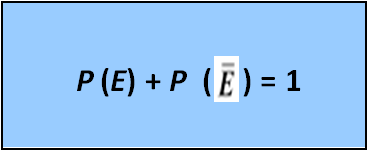
or
![]()
This is a very important property about the probability of complement of an event and it is stated as follows:
If E is an event of finite sample space S, then P (  ) = 1 – P(E) where
) = 1 – P(E) where  is the complement of event E.
is the complement of event E.
Now, let us prove this property algebraically.
Proof:
We have,
E ∪ = S and E ∩
= S and E ∩  =
= 
⇒ n(E ∪ ) = n(S) and n(E ∩
) = n(S) and n(E ∩  ) = n(
) = n( )
)
⇒ n(E ∪ ) = n(S) and n(E ∩
) = n(S) and n(E ∩  ) = 0 ...(1)
) = 0 ...(1)
Now,
n(E ∪ ) = n(S)
) = n(S)
⇒ n(E) + n( ) – n(E ∩
) – n(E ∩ ) = n(S)
) = n(S)
⇒ n(E) + n( ) – 0 = n(S) [Using (1)]
) – 0 = n(S) [Using (1)]
⇒ n( ) = n(S) – n(E)
) = n(S) – n(E)
On dividing both sides by n(S), we get
![]()
⇒ P( ) = 1 – P(E)
) = 1 – P(E)
Hence proved.
Let us solve some examples based on this concept.
Example 1: One card is drawn from a well shuffled deck. What is the probability that the card will be
(i) a king?
(ii) not a king?
Solution:
Let E be the event ‘the card is a king’ and F be the event ‘the card is not a king’.
(i) Since there are 4 kings in a deck.
 Number of outcomes favourable to E = 4
Number of outcomes favourable to E = 4
Number of possible outcomes = 52
 P (E)
P (E)

(ii) Here, the events E and F are complements of each other.
∴ P(E) + P(F) = 1
P(F) = 1 −

Example 2: If the probability of an event A is 0.12 and B is 0.88 and they belong to the same set of observations, then show that A and B are complementary events.
Solution:
It is given that P (A) = 0.12 and P (B) = 0.88
Now, P(A) + P(B) = 0.12 + 0.88 = 1
 The events A and B are complementary events.
The events A and B are complementary events.
Example 3: Savita and Babita are playing badminton. The probability of Savita winning the match is 0.52. What is the probability of Babita winning the match?
Solution:
Let E be the event ‘Savita winning the match’ and F be the event ‘Babita wining the match’. It is given that P (E) = 0.52
Here, E and F are complementary events because if Babita wins the match, Savita will surely lose the match and vice versa.
 P (E) + P (F) = 1
P (E) + P (F) = 1
0.52 + P (F) = 1
P (F) = 1 − 0.52 = 0.48
Thus, the probability of Babita winning the match is 0.48.
Example 4: In a box, there are 2 red, 5 blue, and 7 black marbles. One marble is drawn from the box at random. What is the probability that the marble drawn will be (i) red (ii) blue (iii) black (iv) not blue?
Solution:
Since the marble is drawn at random, all the marbles are equally likely to be drawn. Total number of marbles = 2 + 5 + 7 = 14
Let A be the event ‘the marble is red’, B be the event ‘the marble is blue’ and C be the event ‘the marble is black.
(i) Number of outcomes favourable to event A = 2
 P (A)
P (A)
(ii) Number of outcomes favourable to event B = 5
∴ P (B)
(iii) Number of outcomes favourable to event C = 7
 P (C)
P (C)
(iv) We have, P (B)
The event of drawing a marble which is not blue is the complement of event B.
 P
P  = 1 − P (B) = 1 −
= 1 − P (B) = 1 −
Thus, the probability of drawing a marble which is not blue is .
2.Zeros and Coefficients of Polynomial – 1
Relationship Between Zeroes Of A Polynomial And Its Coefficients
We have learnt to find the zeroes or roots of a polynomial. Also, we know that zeroes or roots of a polynomial are those values of its variables for which the polynomial results to zero.
Now, let us learn about the relation between zeroes and the coefficients of the polynomial.
Relationship between the zero and the coefficient of a linear polynomial:
Let p(x) = ax + b be a linear polynomial such that a ≠ 0.
Zero of this polynomial can be obtained by equating it with 0. i.e, p(x) = 0
⇒ ax + b = 0
⇒ ax = –b

Using this relation, we can find the zero of a linear polynomial.
Relationship between the zeroes and the coefficients of a quadratic polynomial:
Consider a quadratic polynomial p(x) = 3x2– 5x – 12.
Can we find out the sum and the product of the zeroes of this polynomial?
Yes, we can find the sum and the product of zeroes but firstly we have to find out the zeroes of the polynomial.
Here, the zeroes of polynomial p(x) are 3 and .
Now, the sum of zeroes = 3 +
And the product of zeroes = 3 × = – 4
= – 4
Can we find out the sum and the product of zeroes by any other method?
Yes, there is also a method in which there is no need to find out the zeroes. In that method we use the coefficients of the polynomial to find the sum and the product of zeroes.
Firstly let us see the relation between the sum and product of zeroes and the coefficients of the polynomial.
Let us first consider a quadratic polynomial p(x) = ax2 + bx + c, where a, b and c are constants.
If αand β are the zeroes of p(x) = ax2 + bx + c, then,
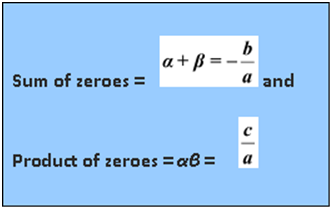
Now, let us find the sum and product of zeroes of the polynomial given in the beginning, using these relations.
The polynomial is p(x) = 3x2 – 5x – 12.
On comparing this equation with ax2 + bx + c, we have
a = 3, b = –5 and c = –12
∴ Sum of zeroes = –  =
=
And the product of zeroes =
Using these relations we obtained the same values as we found after calculating the zeroes.
Now, let us know the relations between the sum and the product of zeroes and the coefficients of a cubic polynomial.
The general form of a cubic polynomial is p(x) = ax3 + bx2 + cx + d where a, b, c and d are constants.
If α, β and γ are the three zeroes of cubic polynomial p(x), then the relations are given by
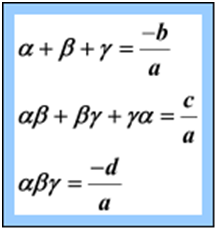
Let us solve some more problems to have a better understanding of the concept.
Example 1: Find the zeroes of the following quadratic polynomials and verify the relationship between the zeroes and the coefficients.
(a) x2 – 9x + 20 (b) 5x2 + 21x – 20.
Solution:
(a) The given quadratic polynomial is p(x) = x2 – 9x + 20.
Firstly we will find the zeroes by the method of splitting the middle term and then verify the relationship between the zeroes and the coefficients of the polynomial.
In this method, we have to find two numbers whose product is 20 and sum (or difference) is 9.
Such two numbers are 4 and 5 so, we have
x2 – 9x + 20 = x2 – (4 + 5)x + 20
= x2 – 4x – 5x + 20
= x (x – 4) – 5 (x – 4)
= (x – 4) (x – 5)
Thus, for finding zeroes, we put
x2 – 9x + 20 = 0.
(x – 4) (x – 5) = 0
(x – 4) = 0 or (x – 5) = 0
x = 4 or 5
Thus, 4 and 5 are the zeroes of the polynomial p(x) = x2 – 9x + 20.
Now sum of zeroes = 4 + 5 = 9
And product of zeroes = 4 × 5 = 20
Now, on comparing p(x) = x2 – 9x + 20 with the general quadratic polynomial
ax2 + bx + c = 0, we have a = 1, b = –9 and c = 20.
Using the formulae, we have
Sum of zeroes

= 9
Product of zeroes

= 20
Hence, it is verified that Sum of zeroes =  and
and
Product of zeroes = αβ = .
(b) Comparing the given polynomial with ax2 + bx + c, we have, a = 5, b = 21
and c = – 20.
Using the method of splitting the middle term we have,
p(x) = 5x2 + 21 x – 20 = 5x2 + (25 – 4)x – 20
= 5x2 + 25x –4 x – 20
= 5x(x + 5) –4 (x + 5)
= (x + 5) (5x – 4)
For finding zeroes, put p(x) = 0 (x + 5) (5x – 4) = 0
x = – 5 or x =
Thus, the zeroes of the polynomial 5x2 + 21 x – 20 are – 5 and  .
.
Now, sum of zeroes = – 5 +  =
= =
=
And product of zeroes = – 5 × = –4 =
= –4 =  =
= 
Hence, verified.
Example 2: If 1, 2, and 6 are the zeroes of the cubic polynomial x3 – 9x2 + 20x – 12, then verify the relations between the zeroes and the coefficients.
Solution:
The given cubic polynomial is p(x) = x3 – 9x2 + 20x – 12.
On comparing the given polynomial with the general form ax3 + bx2 + cx + d of cubic polynomial, we have a = 1, b = – 9, c = 20, d = – 12.
Now the zeroes are 1, 2, and 6.
Let α = 1, β = 2 and γ = 6
Now α+ β + γ = 1 + 2 + 6

 = 1 × 2 + 2 × 6 + 6 × 1
= 1 × 2 + 2 × 6 + 6 × 1
= 2 + 12 + 6
= 20

and αβ γ = 1 × 2 × 6
= 12

Hence, this verifies the relations between the coefficients and the zeroes of the cubic polynomial.
Formation Of Polynomial Using The Sum And Product Of Zeroes
5 and –3 are the zeroes of a quadratic polynomial p(x). Can we form the quadratic polynomial with the help of these zeroes?
Yes, we can. Let us see how we can form the polynomial.
5 is a zero of the polynomial, it means that (x – 5) is a factor of the polynomial p(x). Similarly (x + 3) is also a factor of the polynomial p(x). We know that a quadratic polynomial can have only two linear factors. Thus, we can write the polynomial p(x) as follows:
p(x) = (x – 5) (x + 3)
= x2 + (– 5 + 3) x + (– 5) (3)
[Using the identity (x + a) (x + b) = x2 + (a + b) x + ab, where a = – 5 and b = 3]
Thus, p(x) = x2 – 2x – 15
This is the required quadratic polynomial.
If we know the zeroes of the quadratic polynomial, then we can find the polynomial as above. On the other hand, if we know the sum and product of the zeroes of the polynomial, then we can use the following formula to find the polynomial.

For example: if the sum and the product of the zeroes of a polynomial are 2 and –8 respectively, then find the polynomial.
Using the above formula, we have
p(x) = x2 – (2)x + (–8)
p(x) = x2 – 2x – 8
In this way, we can find the polynomial if the relationship between the zeroes is known to us.
Let us discuss some more examples based on formation of quadratic polynomial using sum and products of zeroes.
Example 1: If the sum and product of zeroes of a quadratic polynomial are 13 and 36 respectively, find the quadratic polynomial.
Solution:
Let the polynomial be p(x).
It is given that the sum of the zeroes of the polynomial = 13 and the product of the zeroes of the polynomial = 36
But we know that the quadratic polynomial p(x) in terms of sum and product of zeroes is given by the formula
p(x) = x2 – (sum of zeroes)x + product of zeroes
so, we have
p(x) = x2 – 13x + 36
Therefore, x2 – 13x + 36 is the quadratic polynomial whose sum and the product of zeroes are 13 and 36 respectively.
Example 2: If the sum and product of zeroes of a quadratic polynomial are and – 6 respectively, find the quadratic polynomial.
and – 6 respectively, find the quadratic polynomial.
Solution:
Let the quadratic polynomial be p(x).
It is given that the sum of the zeroes of the polynomial is  and the product of the zeroes of the polynomial is – 6.
and the product of the zeroes of the polynomial is – 6.
We know that the quadratic polynomial p(x) in terms of sum and product of zeroes is given by the formula
p(x) = x2 – (sum of zeroes)x + product of zeroes so, we have
p(x) = x2 – (  )x + (– 6)
)x + (– 6)
p(x) = x2 x – 6
x – 6
Therefore, x2 x – 6 is the quadratic polynomial whose sum and product of zeroes are
x – 6 is the quadratic polynomial whose sum and product of zeroes are  and – 6 respectively.
and – 6 respectively.
Example 3: If and
and  are the zeroes of a quadratic polynomial, then find the polynomial.
are the zeroes of a quadratic polynomial, then find the polynomial.
Solution:
Let p(x) be the required quadratic polynomial.  and
and are the zeroes of the polynomial p(x).
are the zeroes of the polynomial p(x).
Now, the sum of zeroes =
and the product of zeroes =
Now, the polynomial is given by the formula
p(x) = x2 – (sum of zeroes)x + product of zeroes
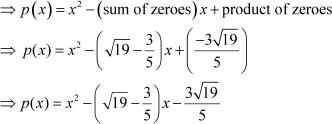
Hence, this is the required polynomial whose zeroes are  and
and  respectively.
respectively.
3.Zeros and Coefficients of Polynomial – 2
Division Of Polynomials by Polynomials (Degree More than 1) Using Long Division Method
All of us have already studied the method of long division of polynomials by other polynomials in earlier classes. But there, our divisor was just of degree one. Now we will
revise long division method of polynomials with other polynomials and extend the discussion to do the division when the divisor is of a higher degree.
Let us discuss the method of division by taking an example. Let us divide (x3 − 7x + 6) by (x2 + 2x − 3).
Now let us solve some examples to practice the above method.
Example 1: Divide the polynomial by monomial and write the quotient and remainder.
(i) 36n5 – 3n3 + 12n2 ÷ 9n2
(ii) 7p7 + 3p5 – 42p3 + 10 ÷ 21p3
Solution:
(i) 36n5 – 3n3 + 12n2 can be divided by 9n2 using long division method as follows:
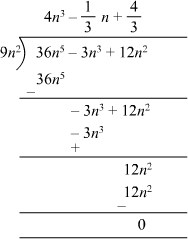
Therefore,
Quotient = 
Remainder = 0
(ii) 7p7 + 3p5 – 42p3 + 10 can be divided by 21p3 using long division method as follows:
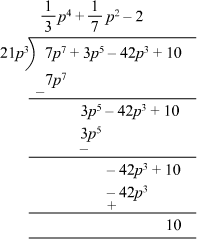
Therefore,
Quotient = 
Remainder = 10
Example 2: Check whether (x2 − 3x + 2) is a factor of (x3 − 7x2 + 14x − 8) or not. Solution:
(x2 − 3x + 2) will be a factor of (x3 − 7x2 + 14x − 8), if the polynomial (x3 − 7x2 + 14x − 8) on dividing by (x2 − 3x + 2) gives remainder zero.
The division has been shown below:
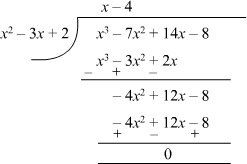
The remainder is zero.
∴ (x2 − 3x + 2) is a factor of (x3 − 7x2 + 14x − 8).
Example 3: Find the quotient and remainder when (15x − 4 + x3 − 6x2) is divided by
(x2 − 3x + 2).
Solution:
Firstly, we arrange the terms of the dividend and the divisor in the standard form.
The dividend in the standard form will be
x3 − 6x2 + 15x − 4.
The divisor is already in standard form. The division has been shown below:
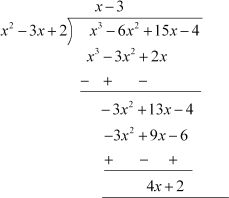
Therefore, Quotient = x – 3
Remainder = 4x + 2
Example 4: and
and are the zeroes of the polynomial 16x4 − 64x3 + 40x2 + 80x − 75. Find the other zeroes of the polynomial.
are the zeroes of the polynomial 16x4 − 64x3 + 40x2 + 80x − 75. Find the other zeroes of the polynomial.
Solution:
Let p(x) = 16 x4 − 64x3 + 40x2 + 80x − 75
 and
and  are two zeroes of p(x).
are two zeroes of p(x).
⇒ (x − ) and (x +
) and (x + ) are the factors of p(x)
) are the factors of p(x)
⇒ x2 − is a factor of p(x)
is a factor of p(x)
To find the other factors, we have to divide p(x) by x2 −  as follows:
as follows:
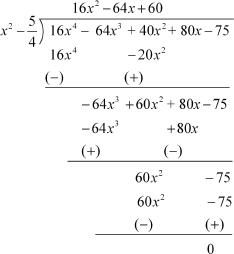
Now,  is the factor of p(x).
is the factor of p(x).
So, we can write  =
=
= (Splitting the middle term)
(Splitting the middle term)
=
=
To find the zeroes, put  = 0
= 0
We have 

Thus, the remaining zeroes of the polynomial are x = and
and  .
.
4.Division of Polynomial
Division Algorithm Of Polynomials
We are aware of the process of division of numbers. Let us divide 487 by 3. We can divide 487 by 3 as follows:

From the above division, we can see that when we divide 487 by 3, we get 1 as remainder and 162 as quotient.
We can also write the dividend 487 in terms of divisor, quotient and remainder as follows: 487 = 3 × 162 + 1
Thus, for real numbers we can write
Dividend = Divisor × Quotient + Remainder
In the same way, we can also divide a polynomial p(x) by another polynomial g(x) when the degree of the polynomial p(x) is greater than or equal to the degree of polynomial g(x). The above relation is also true in case of polynomials and then it is known as division algorithm of polynomials.
Using the division algorithm of polynomials, we can also find any one of the values among p(x), g(x), q(x) and r(x) if other three are known.
Note that degree of q(x) = degree of p(x) – degree of g(x)
Let us discuss more examples based on division algorithm of polynomials.
Example 1: Find the quotient, if the polynomial −2x3 + 7x2 − 7x − 2 when divided by 2x2 − 5x + 2 gives remainder −4.
Solution:
Let the quotient be q(x).
It is given that when we divide the polynomial (−2x3 + 7x2 − 7x − 2) by (2x2 − 5x + 2), we get the q(x) as quotient and −4 as remainder.
Thus, we have
p(x) = −2x3 + 7x2 − 7x − 2
g(x) = 2x2 − 5x + 2
r(x) = −4
We know that the division algorithm for polynomials is:
p(x) = g(x) × q(x) + r(x)
Now, on putting the values in this equation, we have
−2x3 + 7x2 − 7x − 2 = (2x2 − 5x + 2) × q(x) − 4
⇒ −2x3 + 7x2 − 7x − 2 + 4 = (2x2 − 5x + 2) × q(x)
⇒ −2x3 + 7x2 − 7x + 2 = (2x2 − 5x + 2) × q(x)

We can divide −2x3 + 7x2 − 7x + 2 by (2x2 − 5x + 2) as follows:
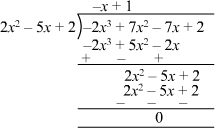
Now, we have q(x) = 1 − x
Therefore, the quotient is 1 − x.
Example 2: Find the quotient, if the polynomial 3x3 − 3x2 + 9x + 2 when divided by x2 + 5x + 1 gives remainder 4x3.
Solution:
Let the quotient be q(x).
It is given that when we divide the polynomial (3x3 − 3x2 + 9x + 2) by (x2 + 5x + 1), we get the q(x) as quotient and 4x3 as remainder.
Thus, we have
p(x) = 3x3 − 3x2 + 9x + 2
g(x) = x2 + 5x + 1
r(x) = 4x3
We know that the division algorithm for polynomials is:
p(x) = g(x) × q(x) + r(x)
Now, on putting the values in this equation, we have
3x3 − 3x2 + 9x + 2 = (x2 + 5x + 1) × q(x) + 4x3
⇒ 3x3 − 3x2 + 9x + 2 − 4x3 = (x2 + 5x + 1) × q(x)
⇒ −x3 − 3x2 + 9x + 2 = (x2 + 5x + 1) × q(x)

We can divide −x3 − 3x2 + 9x + 2 by (x2 + 5x + 1) as follows:
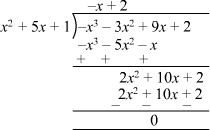
Now, we have q(x) = 2 − x
Therefore, the quotient is 2 − x.
Example 3: By applying division algorithm, find the quotient and remainder when p(x)
= x4 + 3x3 + 2x2 + 5x –  is divided by g(x) = x3 + 2x – 1.
is divided by g(x) = x3 + 2x – 1.
Solution:
p(x) = x4 + 3x3 + 2x2 + 5x –  , g(x) = x3 + 2x – 1
, g(x) = x3 + 2x – 1
deg p(x) = 4, deg g(x) = 3
Degree of quotient q(x) = 4 – 3 = 1, and deg of remainder r(x) < deg g(x) = 3 Let q(x) = ax + b, r(x) = cx2 + dx + e
By division algorithm,
p(x) = g(x) × q(x) + r(x)
⇒ x4 + 3x3 + 2x2 + 5x –  = (ax + b)(x3 + 2x – 1) + (cx2 + dx + e)
= (ax + b)(x3 + 2x – 1) + (cx2 + dx + e)
= ax4 + 2ax2 – ax + bx3 + 2bx – b + cx2 + dx + e
= ax4 + bx3 + (2a + c)x2 + (–a + 2b + d)x + (–b + e)
Equating the coefficients of respective powers, we obtain
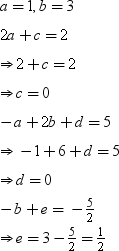
Quotient, q (x) = x + 3
Remainder, r (x) = 
2.Solution of Quadratic Equation by Squaring Method
Solution of Quadratic Equations by Completing Squares
Many real life situations can result in quadratic equations. For example, consider the following situation:
A ladder is leaning against a wall. The top of the ladder touches the wall at a
height of 15 feet. The length of the ladder is one foot more than twice its distance from the foot of the wall. We need to find the length of the ladder.
We can express the given situation mathematically with the help of a quadratic equation.
Let us see how.
Let the distance from the wall to the bottom of the ladder be x feet.
It is given that the length of the ladder is one foot more than twice its distance from the foot of the wall.
Hence, the length of the ladder becomes (2x + 1).
The wall makes an angle of 90° with respect to the ground. Since the ladder is leaning against the wall, the entire arrangement forms a right triangle in which the ladder acts as the hypotenuse.
On applying Pythagoras theorem, we get


Now, to find the length of the ladder, we first need to solve the given quadratic equation. Observe that if you try to solve it by splitting the middle term, then it will become very lengthy. In such cases, it is easier to solve the quadratic equation by another method called the Completion of Squares.
Let us learn this method with the help of an example. Consider the following quadratic equation:

In this method, we need to convert the quadratic equation in the form

To convert a quadratic equation in this form, we will make use of the following identities:

In the example taken previously, the given equation was  .
.
Note that the term with the coefficient x has a negative sign attached to it.
We thus need to make use of the identity  here.
here.
On comparing this equation with the given identity, we get 2b = 6, i.e., b = 3.
Thus, we need to add  on both sides of the equation.
on both sides of the equation.
The equation now becomes .

It is important to remember that has two values, i.e., 4 and –4.
has two values, i.e., 4 and –4.
Thus, the equation can be further simplified as

Thus, the given equation has two solutions, i.e., x = 7 and x = –1.
Let us now go back to the initial problem we were discussing.
We had arrived at a final quadratic equation, which was .
.
Note that in this case, the term with the coefficient x2 is not a perfect square. We thus need to multiply the equation by 3 to make it a perfect square.
On doing so, we get

The identity can be used here.
be used here.
The equation can now be solved as
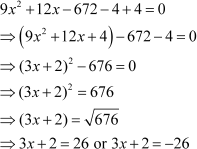

However, x represents the distance of the foot of the ladder from the base of the wall, which cannot be negative. Thus, x has only one value, i.e., 8.
Thus, length of the ladder = 2x + 1 = (2 × 8 + 1) ft = 17 ft
We can follow one more approach to solve this equation.
The equation was  .
.
Here, the term with the coefficient x2 is not a perfect square. We thus convert it to a perfect square by multiplying the equation by 3.
Note that we could also have divided the equation by 3 and still have converted the term to a perfect square.
Let us see how.
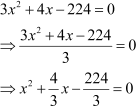
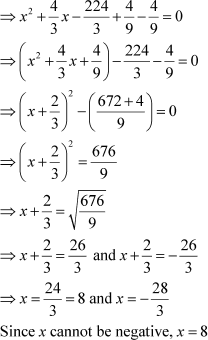
We can use any of the two methods mentioned above, as long as we covert the equation to the form .
.
 Note: Usually, the roots of the quadratic equation ,
Note: Usually, the roots of the quadratic equation , can be found by first dividing the equation by and then completing the squares of the terms in the equation.
can be found by first dividing the equation by and then completing the squares of the terms in the equation.
Example 1: Find the roots of the equation  by the method of completion of squares.
by the method of completion of squares.
Solution:
The given equation is .
By multiplying the equation by 5, we get  .
.
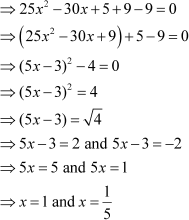
Example 2: Find the roots of the equation  by the method of completion of squares.
by the method of completion of squares.
Solution:
The given equation is  .
.
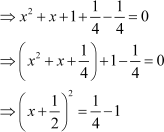
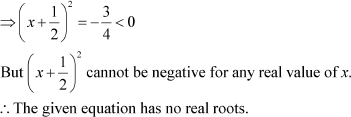
Example 3: Find three consecutive even integers so that the product of the first two numbers is three times the third number.
Solution:
Let the three numbers be x, (x + 2), and (x + 4).
From the given condition, we have x(x + 2) = 3(x + 4).
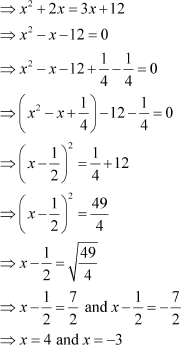
However, the three numbers are positive integers.
Thus, x cannot be equal to –3.
Thus, the three consecutive even integers are 4, 6, and 8.
Example 4: Denominator of a fraction is 3 more than its numerator such that both are positive integers. If the sum of the fraction and its reciprocal is  then find the fraction.
then find the fraction.
Solution:
Let the numerator be x. Then the denominator will be x + 3.
According to the question, we have

⇒ 10(x2 + x2 + 6x + 9) = 29x(x + 3)
⇒ 20x2 + 60x + 90 = 29x2 + 87x
⇒ 9x2 + 27x – 90 = 0
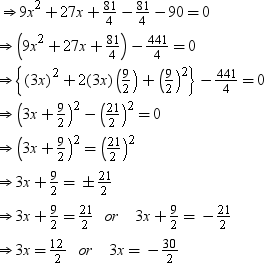
⇒ x = 2 or x = –5
–5 is a negative integer, so it is discarded.
Consider x = 2
∴ Numerator = 2 and Denominator = 2 + 3 = 5
∴ Fraction = 
Example 5: Base of a small triangular garden is 7 m more than its height. If the area of the garden is 60 m2 then find its base and height.
Solution:
Let the height of the triangular garden be x m. Then its base will be (x + 7) m.
Area of triangular garden = 

⇒120 = x2 + 7x
⇒ x2 + 7x – 120 = 0
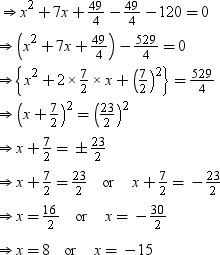
Length cannot be negative, so we consider x = 8.
∴ Height of triangular garden = 8 m
∴ Base of triangular garden = (8 + 7) m = 15 m
Solution of Quadratic Equations by Using Quadratic Formula
The following equations are quadratic in nature:
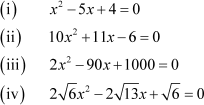
If we were to solve these equations, we could have either factorized the equations (i), (ii), and (iii) or completed their squares.
However, note that we would face a lot of difficulty in solving equation (iv) by either of these two methods.
Apart from factorizing a quadratic equation or completing its square, we can also use the quadratic formula to factorize an equation.
Let us go back to equation (iv), which was  . Comparing this equation with the general form of a quadratic equation:
. Comparing this equation with the general form of a quadratic equation:

Thus, according to the quadratic formula:
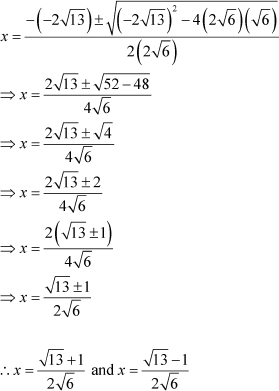
Let us now solve some more quadratic equations by using the quadratic formula.
Example 1: Solve the quadratic equation 5x2 + x− 22 = 0 by using the quadratic formula.
Solution:
On comparing the given equation with the general form ax2 + bx + c = 0, we get
a = 5, b = 1, c = −22
On putting these values in the quadratic formula, we get
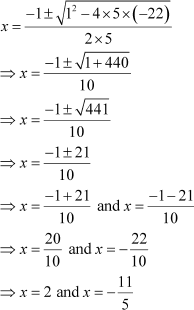
Example 2: Find the roots of the equation 3x2 + 5x + 10 = 0 by using the quadratic equation formula.
Solution:
On comparing the given equation with the general form ax2 + bx + c = 0, we get
a = 3, b = 5, c = 10
∴ b2 − 4ac = (5)2 − 4 × 3 × 10
= 25 − 120
= −95 <</span> 0
Thus,  does not have any real value.
does not have any real value.
Thus, there are no real roots for the given equation.
Example 3: The denominator of a fraction is 2. If the sum of the fraction and its
reciprocal is ![]() , then find the fraction.
, then find the fraction.
Solution:
Let the numerator of the fraction be x.
Hence, the rational number is .
.
It is given that the sum of the fraction and its reciprocal is  .
.
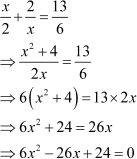
On comparing this equation with the general form ax2 + bx + c = 0, we get
a = 6, b = −26, c = 24
On putting these values in the quadratic formula, we get
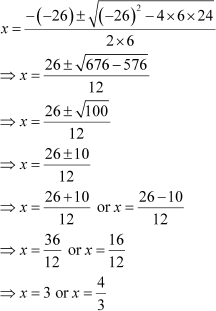
Since x is the numerator of the fraction, it has to be an integer.
∴ x = 3
Thus, the fraction is  .
.
Example 4: The perimeter of a rectangle is 34 cm and its area is 70 cm2. Find the length and the breadth of the rectangle.
Solution:
Let the length and breadth of the rectangle be x and y respectively.
Thus, perimeter of the rectangle = 2(x + y) = 34 cm
⇒ x + y = 17
⇒ y = 17 – x … (1)
Thus, area of the rectangle = x × y = 70 cm2 … (2)
Substituting the value of y from (1) in (2):
x(17 – x) = 70
⇒ 17x – x2 = 70
⇒ x2 – 17x + 70 = 0
By using the quadratic formula, we get
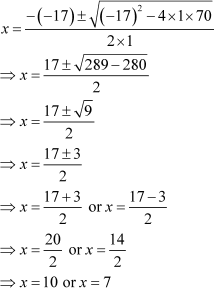
Thus, the length and the breadth of the rectangle are 10 cm and 7 cm respectively.
Example 5: A ball is thrown upwards from a height of 6 m with a particular speed. The height h of the ball after t seconds is given by 6 + 13t – 5t2. How long the ball will take to touch the ground?
Solution:
Height of the ball after t seconds is given as follows:
h = 6 + 13t – 5t2
When ball will touch the ground, the height will be 0 m.
⇒ 0 = 6 + 13t – 5t2
⇒ 5t2 – 13t – 6 = 0
By using the quadratic formula, we get
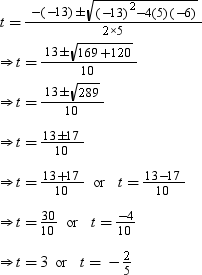
Time cannot be negative, so we will consider t = 3.
Thus, the ball will touch the ground after 3 seconds.
Example 6: A super fast train takes 6 hours less than a passenger train to reach the destination which is 1440 km away. If the speed of the super fast train is 40 km/hr more than that of passenger train then find the average speed of both trains.
Solution:
Let the average speed of passenger train be x km/hr.
Then the average speed of super fast train will be x + 40 km/hr.
Total distance to be covered = 1440 km
Total time taken by passenger train = 
Total time taken by super fast train = 
According to the question, we have
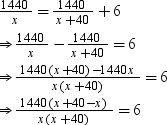
⇒ 1440(40) = 6x(x + 40)
⇒ x2 + 40x – 9600 = 0
By using the quadratic formula, we get
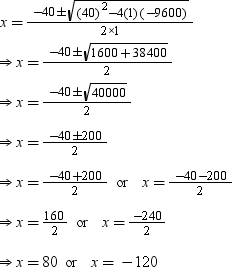
Speed cannot be negative, so we consider x = 80.
∴ Average speed of passenger train = 80 km/hr
∴ Average speed of super fast train = (80 + 40) km/hr = 120 km/hr
3.Determination of Types of Roots
Conditions Under which a Quadratic Equation has Real or Imaginary Roots
A right angled ΔABC is given in the following figure.

In this triangle, the base BC is 5 cm less than twice its height AB. The hypotenuse of the triangle is 2 cm.
Is the above given situation possible for triangle ΔABC?
Can we also find the nature of roots of a quadratic equation without solving the equation?
We can see from the above example that the value of x depends on the value under the sign of square root. If this value is positive, then the value of x will be real and if it is negative, the value of x will be imaginary.
Thus, we can say that the nature of the values of x in quadratic equation ax2 + bx + c = 0, depends on the value of b2 − 4ac.
Here, b2 − 4ac is called the discriminant of the quadratic equation ax2 + bx + c = 0. The value of b2 − 4ac determines the nature of the roots of a quadratic equation.

For example: The quadratic equation 3x2 − x + 2 = 0 has no real root because for this equation,
b2 − 4ac = (−1)2 − 4 × 3 × 2
= 1 − 24
= − 23 < 0
Here b2 − 4ac < 0.
Thus, the equation 3x2 − x + 2 = 0 has no real roots.
Now, let us solve some more examples based on the natures of roots of quadratic equations.
Example 1: Find the value of discriminant for the quadratic equation x2 + 4x − 21 = 0.
Solution:
The given quadratic equation is x2 + 4x − 21 = 0.
On comparing this equation with the standard form of quadratic equation, ax2 + bx + c = 0,
we have
a = 1, b = 4, c = − 21
Therefore, the discriminant, b2 − 4ac = (4)2 − 4 × 1 × (− 21)
= 16 + 84
= 100
Thus, the value of discriminant for the given quadratic equation is 100.
Example 2: Find the nature of the roots of quadratic equation, x2 − 8x + 16 = 0.
Solution:
The given equation is x2 − 8x + 16 = 0.
On comparing this equation with the standard form of quadratic equation, ax2 + bx + c = 0, we have a = 1, b = − 8, c = 16.
Therefore, the discriminant,
b2 − 4ac = (− 8)2 − 4 × 1 × 16
⇒ b2 − 4ac = 64 − 64
⇒ b2 − 4ac = 0
Thus, the given quadratic equation has two equal real roots.
Example 3: Find the value of k for which the quadratic equation x2 − 12x + k = 0 has two real equal roots.
Solution:
On comparing the given equation with ax2 + bx + c = 0, we have a = 1, b = − 12, c = k
For two real equal roots,
b2 − 4ac = 0
⇒ (− 12)2 − 4 × 1 × k = 0
⇒ 144 − 4k = 0
⇒ 4k = 144
⇒ k = 36
Thus, the value of k is 36.
Example 4: Is it possible to design a rectangular garden whose area is 250 square m and the sum of whose length and breadth is 20 m?
Solution:
Let the length of the garden be x m.
∴ Breadth = (20 − x) m
Area of garden = length × breadth
250 = x × (20 − x)
⇒ 250 = 20x − x2
⇒ x2 − 20x + 250 = 0
This is a quadratic equation whose discriminant is b2 − 4ac = (− 20)2 − 4 × 1 × 250
= 400 − 1000
= − 600 < 0
Therefore, the roots of the equation are not real. Hence, it is not possible to design such a garden.
Example 5: Can we find two consecutive positive numbers whose product is 420? If yes, then find the numbers.
Solution:
Let one number be x.
Then the other number = x + 1
According to the question,
x × (x + 1) = 420
⇒ x2 + x = 420
⇒ x2 + x − 420 = 0
The discriminant of this equation is b2 − 4ac = (1)2 − 4 × 1 × (− 420)
= 1 + 1680
= 1681
∴ b2 − 4ac > 0
Therefore, the roots of the quadratic equation x2 + x − 420 = 0 are real. We can find the numbers using quadratic formula as follows
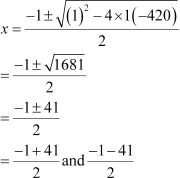
x = 20 and − 21
We take x = 20, as − 21 is a negative number.
Thus, 20 and 21 are the two consecutive positive numbers whose product is 420.
2.Nth Term of Arithmetic Progression
Nth Term Of An Arithmetic Progression
We know what an arithmetic progression (A.P.) is. Also, we have learnt that there is a common difference between any two consecutive terms of an A.P..
Now, can we find the required term of a given A.P. with this information? Let us consider the A.P. 3, 7, 11, 15,...
Here, first term (a) = 3 and common difference (d) = 4
Now, if we want to find the 5th term of this A.P., then we will simply add the common difference to 4th term. Thus, 5th term of this A.P. will be 15 + 4 = 19.
What would we do if we are asked to find the 20th term or 100th term or nth term? Obviously, the process of adding common difference will be very time consuming.
For such problems, we must have a short cut or a formula to find the general term of an A.P. Let us derive the same.
Consider the A.P. a, a + d, a + 2d, a + 3d, ...
For this A.P., we have
a1 = a
a2 – a1 = d a3 – a2 = d
. . .
. . .
. . .
an – 1 – an – 2 = d
an – an – 1 = d
Adding all these equations, we get
a1 + (a2 – a1) + (a3 – a2) +...+ (an – 1 – an – 2) + (an – an – 1) = a + {d + d +... + d (n – 1 times)}
⇒(a1 – a1) + (a2 – a2) + (a3 – a3) +...+ (an – 1 – an – 1) + an = a + (n – 1)d
⇒an = a + (n – 1)d
Hence, the general term or nth term i.e., an of an A.P. whose first term is a and common difference is d can be found by the following formula:
an = a + (n – 1)d
Sometimes, we need to find three, four or five consecutive terms of an A.P. then it is convenient to take them as follows:
- Three consecutive terms can be taken as a – d, a, a + d
- Four consecutive terms can be taken as a – 3d, a – d, a + d, a + 3d. Here, common difference is 2d.
- Five consecutive terms can be taken as a – 2d, a – d, a, a + d, a + 2d
Result:
In an A.P., common difference,  , where Tp and Tq are pth and qth term respectively.
, where Tp and Tq are pth and qth term respectively.
In particular,  .
.
Proof:
Tp = a + (p – 1)d, Tq = a + (q – 1)d
⇒Tp – Tq = a + (p – 1)d – {a + (q – 1)d} = (p – q)d

In particular, take T1 = a.
Then, 
Now, let us solve some examples to understand the concept better.
Example 1: Find the 20th term of the following arithmetic progression. 0.4, 1.5, 2.6, 3.7, 4.8 …
Solution:
Here, a = 0.4 and d = 1.5 – 0.4 = 1.1
Thus, the 20th term is given by,
a20 = a + (20 – 1) d
= 0.4 + (20 – 1) 1.1
= 0.4 + 19 × 1.1
= 0.4 + 20.9
= 21.3
Thus, the 20th term of the given A.P. is 21.3.
Example 2: If the 7th term of an A.P. is – 21 and 15th term is – 53, then find the first term and common difference.
Solution:
Let the first term and common difference of the A.P. be a and d respectively.
It is given that a7 = –21 and a15 = –53
Using the formula for nth term, we obtain
a7 = a + (7 – 1) d
– 21 = a + 6d … (1)
and, a15 = a + (15 – 1) d
– 53 = a + 14d … (2)
Subtracting equation (1) from (2), we obtain
–32 = 8d
⇒ d = –4
Substituting the value of d in equation (1), we obtain
–21 = a + 6 (–4)
–21 = a – 24
⇒ a = 3
Thus, the first term is 3 and the common difference is –4.
Example 3: Is 102 a term of the A.P., 5, 11, 17, 23 …?
Solution:
Let 102 be the nth term of the given sequence.
∴ an = 102
Using the formula for nth term, we obtain
an= a + (n – 1) d
∴ 102 = a + (n – 1) d
For the given A.P., a = 5 and d = 11 – 5 = 6
∴ 102 = 5 + (n – 1) 6
102 – 5 = (n – 1) 6
97 = (n – 1) 6



However, n should be a positive integer. Therefore, 102 is not a term of the given A.P.
Example 4: Find the number of three-digit numbers that are divisible by 5.
Solution:
The first three-digit number which is divisible by 5 is 100, second is 105, third is 110, and so on. The last three-digit number which is divisible by 5 is 995.
Thus, we obtain the following A.P. 100, 105 … 995
Here, we have to find the number of terms, n.
∴Last term of A.P. = 995
The number of terms in the A.P. is n, so the last term is the nth term.
a + (n – 1)d = 995
Here, a = 100 and d = 5
100 + (n – 1)5 = 995
(n – 1)5 = 995 – 100
5n – 5 = 895
5n = 895 + 5
5n = 900

n = 180
Thus, there are 180 three-digit numbers, which are divisible by 5.
Example 5: The fare of a bus is Rs 10 for the first kilometre and Rs 5 for each additional kilometre. Find the fair after 12 kilometres.
Solution:
The fare after each kilometre forms an A.P. as follows.
Fare after one kilometre = Rs 10
Fare after two kilometres = 10 + 5 = Rs 15
Fare after three kilometres = 15 + 5 = Rs 20
Now the arithmetic progression is 10, 15, 20 …
Here, first term, a = 10 and common difference, d = 5
Now the fare after 12 kilometres is the 12th term of the A.P.
∴ a12 = a + (12 – 1) d
a12 = 10 + 11 × 5
= 10 + 55
= 65
Thus, the fare after 12 kilometres is Rs 65.
Example 6: Mohit borrowed a sum of money at a simple interest rate of 2% per annum. He has to pay an amount of Rs 1120 after 6 years. How much money did he borrow?
Solution:
Let the amount of money Mohit borrowed be Rs x. We know that the amount after T years is

Where, P and R denotes the principal and rate respectively
The amount after every year forms an A.P.
Amount after first year

Amount after second year

Thus, the A.P. is as follows.

Here, the first term is  and common difference is
and common difference is  .
.
Now, it is given that the amount after 6 years is Rs 1120 i.e., 6th term of the A.P. is 1120. Now using the formula, an = a + (n – 1)d, we obtain

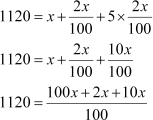
1120 × 100 = 112x
x = 1000
Thus, Mohit borrowed Rs 1000.
Example 7: Find four consecutive terms of an A.P. such that the difference of the middle terms is 8 and the product of the extreme terms is 217.
Solution:
Let four consecutive terms of required A.P. be a – 3d, a – d, a + d, a + 3d.
According to the question, we have
a + d – (a – d) = 8
⇒ a + d – a + d = 8
⇒ 2d = 8
⇒ d = 4 Also,
(a – 3d)(a + 3d) = 217
⇒ a2 – (3d)2 = 217
⇒ a2 – 9d2 = 217
⇒ a2 – 9(42) = 217
⇒ a2 – 144 = 217
⇒ a2 = 361
⇒ a = ±19
When d = 4 and a = 19, then four consecutive terms are:
19 – 3(4), (19 – 4), (19 + 4), 19 + 3(4)
i.e., 7, 15, 23, 31
When d = 4 and a = –19, then four consecutive terms are:
–19 – 3(4), (–19 – 4), (–19 + 4), –19 + 3(4)
i.e., –31, –23, –15, –7
Example 8: Find five consecutive terms of an A.P. such that the product of the extreme terms is –63 and product of second and fourth terms is –15.
Solution:
Let five consecutive terms of required A.P. be a – 2d, a – d, a ,a + d, a + 2d.
According to the question, we have
(a – 2d)(a + 2d) = –63
⇒ a2 – (2d)2 = –63
⇒ a2 – 4d2 = –63 ...(1)
Also,
(a – d)(a + d) = –15
⇒ a2 – d2 = –15 ...(2)
On subtracting (1) from (2), we get
3d2 = 48
⇒ d2 = 16
⇒ d = ±4
On substituting d2 = 16 in (2), we get
a2 – 16 = –15
⇒ a2 = 1
⇒ a = ±1
When a = 1 and d = 4, A.P. will be –7, –3, 1, 5, 9
When a = 1 and d = –4, A.P. will be 9, 5, 1, –3, –7
When a = –1 and d = 4, A.P. will be –9, –5, –1, 3, 7
When a = –1 and d = –4, A.P. will be 7, 3, –1, –5, –9
Example 9: If the 25th and 35th terms of an arithmetic progression are 121 and 171 respectively, then find the common difference of the A.P.
Answer:
T25 = 121, T35 = 171
It is known that common difference,  .
.

Example 10: In an A.P, show that  .
.
Answer:


Therefore, 
3.Sum of N Terms of Arithmetic Progression
Sum of n Terms of an Arithmetic Progression
We know what an arithmetic progression (A.P.) is. Sometimes, we may come across the situations when we have to find the sum of all terms involved in a series and if the series is an AP, then there is a formula which can make the process very simple.
Let us consider a similar situation.
Harry saved Rs 2000 from his salary in the first month. He increases his savings by Rs 50 every month.
Can we calculate his total savings for the first four months?
Let us try to find it.
To find the total savings for the first 4 months, we have to take the sum of the savings for the first four months.
It is given that, savings of Harry for the first month = Rs 2000
Every month, he increases his savings by Rs 50.
Thus, savings for second month = Rs (2000 + 50) = Rs 2050
Similarly, savings for the third month = Rs (2050 + 50) = Rs 2100 nd,
savings for the fourth month = Rs (2100 + 50) = Rs 2150
Thus, the total savings of Harry for the first four months = Rs (2000 + 2050 + 2100 + 2150)
= Rs 8300
Now, can we calculate the total savings of Harry for 2 years?
Yes, we can find it as above but it is a very lengthy as well as time consuming process as we have to find the savings for 24 months.
We can also find the total savings of Harry for first two years using a formula. Now, let us see how we can find it.
The savings of Harry for each month forms an A.P., which is as follows. 2000, 2050, 2100, 2150 ….
The sum of savings of Harry = Rs (2000 + 2050 + 2100 + 2150 ….)
Here, we can observe that the total savings of Harry for the first month is the first term of the A.P., i.e. Rs 2000. The total savings for the first two months is the sum of first two terms of the A.P., i.e. Rs (2000 + 2050). In the same way, the total savings of Harry for first 2 years, i.e. 24 months, is the sum of first 24 terms of the A.P. We can find it by using the formula for finding the sum of n terms of an A.P.
Now, let us find the sum of first 24 terms of the above discussed A.P. which is as follows: 2000, 2050, 2100, 2150 ….
Here, first term, a = 2000
Common difference, d = 2050 − 2000 = 50
The sum of first 24 terms of the A.P. is
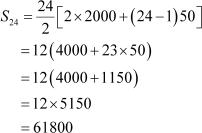
Therefore, the total savings of Harry for the first two years is Rs 61800.
This formula is used when we are given the first term and the common difference of the arithmetic progression.
We can also find the sum of n terms of an A.P., if we know the first and the last term.
The sum of n terms of an A.P. whose first term is a and last term is l is given by the formula:

For example, consider an A.P. whose first term is 2 and 30th term is 263. Then, what will be the sum of 30 terms?
Here, a = 2, l = 263 and n = 30
Therefore, sum of 30 terms

= 15 × 265
= 3975
Thus, the sum of 30 terms is 3975.
Result: The sum of the first n natural numbers is given by  .
.
Proof:
This can be proved by two methods.
1st method (Using concept of A.P.):
The first n natural numbers can be listed as 1, 2, 3, …, n.
Here, a = 1, d = 1.

2nd method (Without using concept of A.P.):
Sn = 1 + 2 + 3 + … + n … (1)
Sn = n + (n – 1) + (n – 2) + … + 3 + 2 + 1 … (2)
Adding (1) and (2):
2Sn = (n + 1) + (n + 1) + …… + (n + 1)
Here, there are n terms in the RHS.

Now, let us discuss some more examples based on sum of n terms of an A.P.
Example 1: Find the sum of first 25 terms of the following A.P. 2, 7, 12 …
Solution:
Here, a = 2 and d = 7 − 2 = 5.
Sum of the first 25 terms is given by
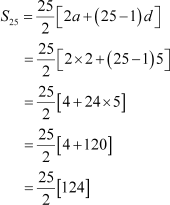
= 25 × 62
= 1550
Thus, the sum of first 25 terms of the given A.P. is 1550.
Example 2: Find the sum of first 8 terms of the A.P whosenthterm is given by 6n − 5.
Solution:
The nth term is given by
an = 6n − 5
On replacing n by 1, 2, 3 … respectively, we get the first, second, third … terms of the A.P.
∴ a1 = 6(1) − 5 = 1
a2 = 6(2) − 5 = 7
a3 = 6(3) − 5 = 13 … and so on.
The A.P. so obtained is as follows.
1, 7, 13 …
Here, the first term, a = 1
and the common difference d = a2 − a1 = 7 − 1 = 6
Using the formula, ,  the sum of first 8 terms is given by
the sum of first 8 terms is given by
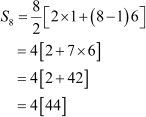
= 176
Thus, the sum of first 8 terms is 176.
Example 3: How many terms of the A.P. −28, −24, −20 … should be taken so that the sum will be zero?
Solution:
Let the sum of n terms be zero.
Here, a = − 28 and d = − 24 − (−28) = 4
Sum of n terms of an A.P. is given by

But, it is given that the sum of n terms of the given A.P. is zero.
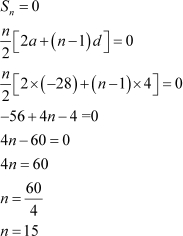
Thus, the sum of 15 terms of the A.P is zero.
Example 4: Sapna’s father planted 4 trees in his garden, when he was 22 years old. After that, every year he planted one more tree than the number of trees he planted in the previous year. How many trees will be there in his garden when he will become 40 years old?
Solution:
We can write the given information in the form of an A.P. as follows
Number of trees he planted in the first year = 4
Number of trees he planted in the second year = 4 + 1 = 5
Number of trees he planted in the third year = 5 + 1 = 6
And so on.
Now, the A.P. is 4, 5, 6 …
He planted trees from the age of 22 years to 40 years, i.e. for 19 years.
Thus, we have to find the sum of 19 terms of this A.P.
Here, a = 4, d = 1
And, n = 19
Using the formula, ,  the sum of 19 terms of this A.P. is given by
the sum of 19 terms of this A.P. is given by
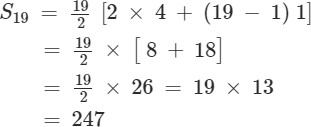
Thus, there will be 247 trees in his garden when he will become 40 years old.
Example 5: The  term of an A.P. is q and the
term of an A.P. is q and the  term of the A.P. is p. What is the sum of (p + q) terms of the A.P.?
term of the A.P. is p. What is the sum of (p + q) terms of the A.P.?
Solution:
Let the first term and the common difference of the A.P. be a and d respectively.
It is given that the  term is q.
term is q.
∴ ap = q
⇒ a + (p − 1) d = q … (1)
Similarly, the qth term is p, therefore we obtain
a + (q − 1) d = p … (2)
On subtracting equation (1) from (2), we obtain
p − q = (q − 1) d − (p − 1) d
p − q = d [q − 1 − p + 1]

By putting the value of d in equation (1), we obtain
q = a + (p − 1) (−1)
q = a + 1 − p
a = p + q − 1
But we know that the sum of n terms of an A.P. is

Thus, the sum of (p + q) terms is
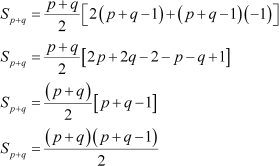
Thus, the sum of (p + q) terms is .
Example 6: Find the nth term of the A.P., the sum of whose n terms is n2 + 2n.
Solution:
Let Sn be the sum of n terms.
It is given that the sum of n terms of the A.P. is n2 + 2n.
∴ Sn = n2 + 2n … (1)
On replacing n by (n − 1) in the equation, we obtain

Let an be the nth term of the A.P. Therefore, we can write
Sn = Sn−1 + an
Thus, an = Sn − Sn−1
= n2 + 2n − [(n − 1)2 + 2(n − 1)]
= n2 + 2n − [n2 + 1 − 2n + 2n − 2]
= n2 + 2n − n2 + 1
= 2n + 1
Thus, the nth term of the A.P is (2n + 1).
Example 7: Find the sum of first 1000 natural numbers.
Solution:
The sum of first n natural number is given by  .
.

Hence, the sum of first 1000 natural numbers is 500500.
Example 8: If sum of the first n natural numbers is 5050, find the value of n.
Solution:
The sum of first n natural number is given by  . Now,
. Now,
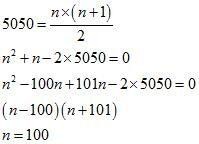
Hence, n = 100
Properties of Arithmetic Progressions and the Concept of Arithmetic Mean
Arithmetic progression is a sequence of numbers such that the difference between the consecutive terms is a constant. It exhibits some properties which are used in solving various problems.
Properties of an Arithmetic Progression
- If a constant is added to each term of an A.P., the resulting sequence will also be an A.P.
- If a constant is subtracted from each term of an A.P., the resulting sequence will also be an A.P.
- If a constant is multiplied to each term of an A.P., the resulting sequence will also be an A.P.
- If each term of an A.P. is divided by a non-zero constant, the resulting sequence is also an A.P.
Arithmetic Mean
If we are given two numbers a and b, then we can insert a number A between these two numbers so that the sequence a, A, b becomes an A.P. Such a number i.e., A is called an arithmetic mean (A.M.) of the numbers a and b.
If A is the A.M. of the numbers a and b, then A is given by A =  .
.
For example, the A.M. of the two numbers 18 and 16 is  .
.
For any two given numbers a and b, we can insert as many numbers between them as we want such that the resulting sequence becomes an A.P.
Example 1: Between −12 and 40, p numbers have been inserted in such a way that the resulting sequence is an A.P. Find the value of p if the ratio of the 4th and the (p −
3)th number is 1 : 6.
Solution:
Let A1, A2, … Ap be p numbers such that −12, A1, A2, … Ap, 40 is an A.P.
Here, a = −12, b = 40, n = p + 2
∴ 40 = −12 + (p + 2 − 1) (d)
⇒ 52 = (p + 1) d

A1 = a + d
A2 = a + 2d
A3 = a + 3d …
∴ A4 = a + 4d
Ap−3 = a + (p − 3) d
According to the given information,
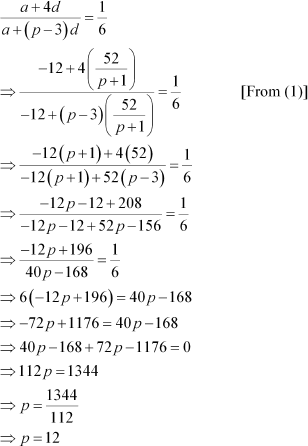
Thus, the value of p is 12.
Example 2: Between 10 and 30, m numbers are inserted such that the resulting sequence is an A.P. If the sum of all the terms of the A.P. is 140, then find the value of m.
Solution:
It is given that between 10 and 30, m numbers are inserted such that the resulting sequence is an A.P.
It is also given that the sum of all the terms in the A.P. is 140.
We know that the sum of n terms of an A.P. is given by
 , where a is the first term and l is the last term
, where a is the first term and l is the last term
Here, a = 10, l = 30
Therefore,
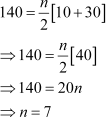
Thus, the total number of terms in the A.P. is 7.
Thus, the value of m is 7 − 2 = 5.
2.Criteria for Similarity of Triangle
AAA Criterion Of Similarity Of Triangles
We have various criteria to prove two triangles similar. AAA criterion is one of these.
We can check the similarity of any two triangles using AAA criterion of similarity if any two angles of each triangle are given so, AAA criterion is same as AA criterion.
AA criterion "If two triangles are equiangular, then their corresponding sides are proportional." can be proved as below.
Given: ΔABC and ΔPQR where ∠A = ∠P, ∠B = ∠Q and ∠C = ∠R.

To prove:
Construction: Mark X and Y on AB and AC respectively such that AX = PQ and AY = PR.
Proof:
In ΔAXY and ΔPQR,
AX = PQ [By construction]
∠A = ∠P [Given]
AY = PR [By construction]
So, by SAS postulate, ΔAXY ≡ ΔPQR.
[Note: The symbol '≡' stands for congruency]
⇒XY = QR and ∠X = ∠Q [CPCT]
Now, ∠X = ∠B [∠X = ∠Q = ∠B]
∴XY||BC [∠X and ∠B are corresponding angles]

Hence, AA criterion is proved.
Now, look at the following triangles.
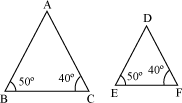
Here, ∠B = ∠E = 50°
and ∠C = ∠ F = 40°
Then, using AAA similarity criterion, ΔABC is similar to ΔDEF.
In symbolic form, we can write ΔABC ∼ ΔDEF. In symbolic form, the order of vertices is very important. For the above triangles, we cannot write ΔABC ∼ ΔEFD because ∠B = ∠E and ∠C = ∠F
Let us look at one more application of the AAA similarity criterion in the video in order to get a better understanding of this concept.
Converse of AAA criterion is also true which states that:
If two triangles are similar then their corresponding angles are equal.
For example, if ΔABC ∼ ΔDEF then ∠A = ∠D, ∠B = ∠E and ∠C = ∠ F.
Note: In some state boards, the symbol "|||"is used for similarity.
I.e., ΔABC ∼ ΔDEF may also be written as ΔABC ||| ΔDEF.
Let us now look at some more problems based on AAA similarity criterion.
Example 1: In the following figure, if DE || BC, then prove the following.
(a) ΔABC ∠ ΔADE
(b) ΔDFE ∠ ΔCFB
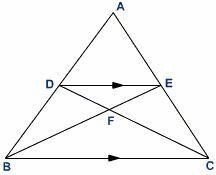
Solution:
(a) In ΔABC and ΔADE,
∠BAC = ∠DAE (Common to both)
∠ADE = ∠ABC (Since DE is parallel to BC, ∠ADE and ∠ABC are corresponding angles) By AAA similarity criterion,
ΔABC ∼ ΔADE
(b) In ΔDFE and ΔBFC,
∠DFE = ∠BFC (Vertically opposite angles)
∠EDF = ∠BCF (Alternate angles) By AAA similarity criterion,
ΔDFE ∼ ΔCFB
Example 2: In the given figure, if WY || ZX, then prove that ΔOWY ∠ ΔOXZ.
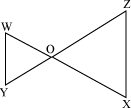
Solution:
Here, WY || ZX
Now, in ΔOWY and ΔOZX,
∠WOY = ∠ZOX (Vertically opposite angles)
∠OWY = ∠OXZ (Alternate angles)
∠OYW = ∠OZX (Alternate angles)
By AAA similarity criterion of triangles, ΔOWY ∼ ΔOXZ
SSS Criterion of Similarity of Triangles
Now that we have understood the concept of AAA similarity criterion, we will try and understand another similarity criterion which is the SSS similarity criterion. It involves the ratio of the corresponding sides of the two triangles.
Converse of SSS criterion is also true which states that:
If two triangles are similar then their corresponding sides are proportional.
For example, if ΔABC ∼ ΔPQR then  .
.
Let us solve some problems to understand this concept better.
Example 1: If PQR is an isosceles triangle with PQ = PR and A is the mid-point of side QR, then prove that ΔPAQ is similar to ΔPAR.
Solution:
It is given that ΔPQR is an isosceles triangle and PQ = PR.

In triangles PAQ and PAR, PQ = PR
Also, A is the mid-point of QR, therefore
QA = AR
And, PA = PA (Common to both triangles)
Therefore, we can say that

∴ Using SSS similarity criterion, we obtain ΔPAQ ∼ ΔPAR
Example 2: In the following figure, E and D are the mid-points of the sides BC and AC respectively. Prove that ΔABC∠ΔDEC.

Solution:
It is given that E is the mid-point of BC.
∴ BE = EC
Now, BC = BE + EC
⇒ BC = 2EC
 ⇒
⇒
Similarly, D is the mid-point of AC, therefore
AC = 2DC
⇒
Also, from the figure,


By SSS criterion of similarity of triangles,
ΔABC ∼ ΔDEC
Example 3: In the following figure, the lines XC and YC of same length are drawn such that C is the mid-point of AB. If AX = BY, then find the measure of the following angles.
[1] ∠BYC (c) ∠CAX
[2] ∠CBY (d) ∠ACX

Solution:
In the triangles CAX and CBY,
CX = CY (Given)
CA = CB (C is the mid-point of AB)
AX = BY (Given)
Therefore, by SSS similarity criterion, ΔCAX ∼ ΔCBY
We know that the corresponding angles of similar triangles are equal.
∴ ∠AXC = ∠BYC = 40°
⇒ ∠BYC = 40°
Also, ∠ACX = ∠BCY
Let
Therefore, x + x + 120° = 180° (∠ACX, ∠BCY, and ∠XCY form a linear pair)
⇒ 2x = 180° − 120° = 60°
⇒ x = 30°
∴ ∠ACX = ∠BCY = 30°
Now, by angle sum property in ΔACX, we obtain
30° + ∠CAX + 40° = 180°
⇒ ∠CAX = 180° − 70° = 110°
∴ ∠CBY = ∠CAX = 110°
Thus, we obtain
1. ∠BYC = 40°
2. ∠CBY = 110°
3. ∠CAX = 110°
4. ∠ACX = 30°
Example 4: ABCD is a square and PQS is an isosceles triangle with PQ = PS and R is the mid-point of QS. If ΔABD ∠ ΔRPQ, then prove that ΔCBD ∠ ΔRPS.
Solution:
ABCD is a square and PQS is an isosceles triangle.
Therefore, AB = BC = CD = DA
And, PQ = PS

It is also given that ΔABD ∼ ΔQRP.
In
AB = CB (Sides of a square)
BD = BD (Common side)
DA = DC (Sides of a square)
By SSS similarity criterion,
ΔABD ∼ ΔCBD … (2)
Now, in ΔRPQ and ΔRPS,
RP = RP (Common side)
PQ = PS (Equal sides of an isosceles triangle)
QR = SR (R is the mid-point of QS)
Therefore, ΔRPQ ∼ ΔRPS … (3)
However, ΔABD ∼ ΔRPQ
Therefore, from (2) and (3), we obtain
ΔCBD ∼ ΔRPS
SAS Criterion Of Similarity Of Triangles
Look at the following figures.
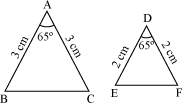
Is there any similarity between them?
We can see that in both the triangles, the lengths of two sides are given and also the measure of the included angle is given. Now, let us compare the sides of the triangles and observe the result we obtain.
On taking the ratio of the sides, we obtain

Therefore, we observe that the sides of the triangles are in the same ratio i.e., we can say that the sides of the triangles are proportional.
Using the above fact, can we say that the given triangles are similar?
To know the answer, let us first know about a similarity criterion known as SAS similarity criterion.
SAS similarity criterion can be stated as follows.
“If one angle of a triangle is equal to one angle of the other triangle and the sides including these angles are proportional, then the two triangles are similar”.
Using this criterion, we can check the similarity of any two triangles, if the two sides and the included angle between them are given.
In the above example, ∠A = ∠D = 65° and the sides including these angles are in the same
proportion i.e., .  Thus, we can say that ΔABC is similar to ΔDEF.
Thus, we can say that ΔABC is similar to ΔDEF.
In symbolic form, we can write ΔABC ∼ ΔDEF. For writing the symbolic form, the order of the vertices is very important.
For example, consider the following figure.

Here, ΔABC and ΔDEF are similar triangles as two sides of both the triangles are proportional and the angles included between them are also equal.
Therefore, we can write ΔABC ∼ ΔEFD.
Let us now look at some more examples to understand this concept better.
Example1: If PQRS is a parallelogram, then prove that ΔSOR is similar to ΔPOQ.
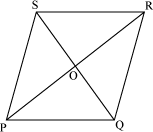
Solution:
Consider ΔSOR and ΔPOQ.
Since PQRS is a parallelogram, the diagonals bisect each other.
∴ SO = OQ and PO = OR
and ∠POQ = ∠SOR (Vertically opposite angles)
By SAS similarity criterion, we obtain
ΔSOR ∼ ΔQOP
Example2: ΔABC is an isosceles triangle with AB and AC as the equal sides. The points D and E divide the side BC into three equal parts as shown in the figure. Prove that ΔABD ∠ ΔACE.
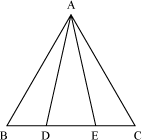
Solution:
Since ABC is an isosceles triangle,
AB = AC
∠ABC = ∠ACB (Angles opposite to equal sides are equal in an isosceles triangle)
It is given that the points D and E divide the side BC in three equal parts. Therefore,
BD = DE = EC
In ΔABD and ΔAEC,
AB = AC
BD = EC
∠ABD = ∠ACE
By SAS similarity criterion,
ΔABD ∼ ΔACE
3.Area of Similar Triangle
AREAS OF SIMILAR TRIANGLES
We know what similar triangles are. Now, let us learn about an interesting theorem related to areas of similar triangles.
The theorem states that:
The ratio of areas of two similar triangles is equal to the ratio of squares of their corresponding sides.
Let us prove this theorem.
Given: ΔABC ∼ ΔXYZ
To prove: 
Construction: Draw segment AD perpendicular to BC and segment XP perpendicular to YZ.
Proof:
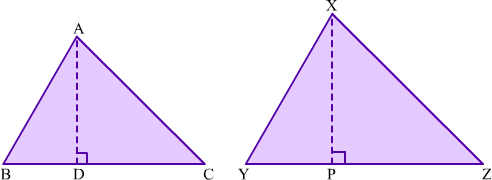
From the figure, we have
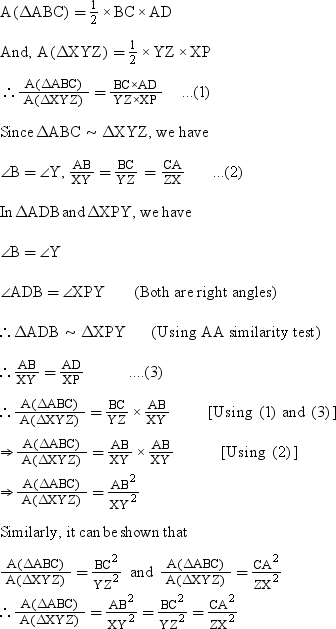
Thus, the ratio of areas of similar triangles is equal to the ratio of squares of their corresponding sides.
Let A1 and A2 be the areas of similar triangles and s1 and s2 be their corresponding sides. Then

Now, let us learn to apply this formula with the help of an example.
Consider a trapezium PQRS in which SR = 3 PQ. The diagonals PR and QS intersect each other at O.
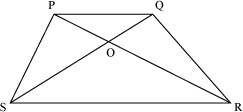
If the area of ΔPOQ is 9 square cm, then what will be the area of ΔSOR? Relation between areas, heights, medians and perimeters of similar triangles:
Let A1 and A2 be the areas of two similar triangles such that s1 and s2 are their corresponding sides, h1 and h2 are their corresponding heights, m1 and m2 are their corresponding medians and P1 and P2 are their respective perimeters.
Then,

Let us go through some examples based on the areas of similar triangles.
Example 1: The ratio of areas of two similar triangles is 16:25. Find the ratio of their corresponding sides.
Solution:
We know that,
Ratio of areas of similar triangles = (Ratio of corresponding sides)2
⇒ (Ratio of corresponding sides)2
(Ratio of corresponding sides)2
Ratio of corresponding sides
= 4:5
Example 2: The areas of two similar triangles are 25 cm2 and 100 cm2. If one side of the first triangle is 4 cm, then find the corresponding side of the other triangle.
Solution:
Let ABC and DEF be two triangles whose areas are 25 cm2 and 100 cm2 respectively. Let AB = 4 cm
Then, we have to find DE.
Since the two triangles ABC and DEF are similar,
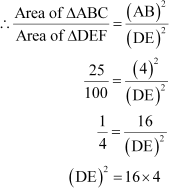
(DE)2 = 64
DE = 8 cm
Thus, the corresponding side of the other triangle is 8 cm.
Example 3: In a triangle ABC, X, Y, and Z are the mid-points of the sides BC, AC, and AB respectively. Find the ratios of the areas of ΔABC and ΔXYZ.
Solution:
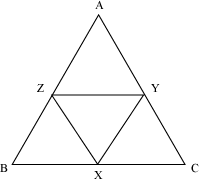
Here, X, Y, and Z are the mid-points of sides BC, AC, and AB respectively.
We know that the line joining the mid-points of two sides is parallel to the third side and its length is half of the third side.
∴ XY || AB and XY =
YZ || BC and YZ =
Again, XZ || AC and
As, XY || AB, YZ || BC, and XZ || AC,
∴ Quadrilaterals AYXZ, BXYZ, and CXZY are parallelograms.
∴ ∠BAC = ∠ZXY, ∠ABC = ∠ZYX, and ∠ACB = ∠XZY
Using AAA similarity criterion, we obtain
ΔABC ∼ ΔXYZ
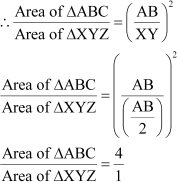
Area of ΔABC: Area of ΔXYZ = 4:1
Example 4: In the given figure, AB and CD are perpendiculars to the line segment BC. Also, AB = 5 cm, CD = 8 cm, and area of ΔAOB is 175 cm2. Find the area of ΔCOD.
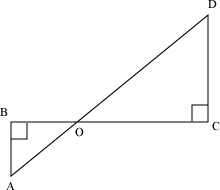
Solution:
Here, ΔAOB and ΔDOC are similar triangles because
∠ABO = ∠DCO (Each 90°)
∠AOB = ∠COD (Vertically opposite angles)
Therefore, by AAA similarity criterion, ΔAOB ∼ ΔDOC
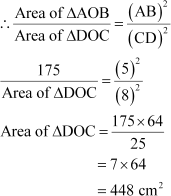
Thus, the area of ΔCOD is 448 cm2.
4.Pythagoras Theorem
Pythagoras Theorem and Its Applications

Look at the following right triangle ABC.
We have the following relationship between the sides of a right-angled triangle ABC. (AC)2 = (AB)2 + (BC)2
This relation between the sides of a right-angled triangle is known as Pythagoras Theorem.
This theorem has several other proofs also. Let us discuss two of them here.
Proof by American President:
The 20th president of United States, James Garfield proved this theorem taking two right angled triangles having sides as a, b and c and an other right angled triangle with side c.
The proof given by him is as follows:
All three triangles are combined as shown in the following figure.
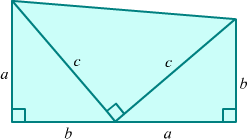
Thus, we got a trapezium.
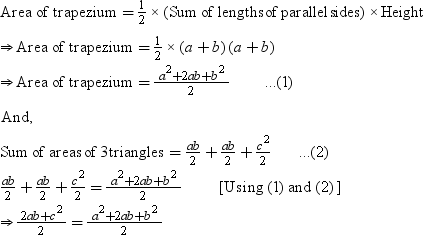
⇒ 2ab + c2 = a2 + 2ab + b2
⇒ c2 = a2 + b2
This theorem of right angled triangles was also known to Indian, Chinese, Greek and Babylonian mathematician long before Pythagoras lived. Thus, it was proved by the mathematicians of that time differently.
Proof by Indian Mathematician:
Bhaskaracharya, the great Indian mathematician of 2nd century AD, used the below given diagrams to prove this theorem.
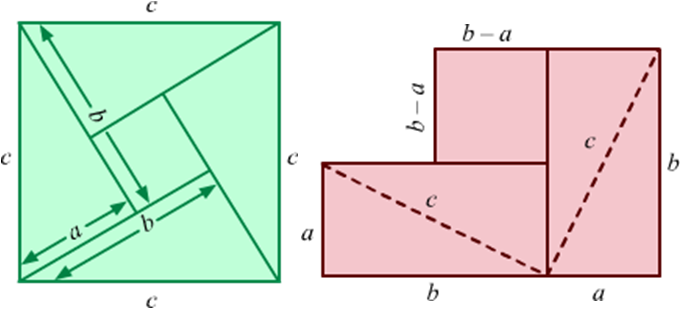

Area of small square = (b – a)2 = b2 – 2ab + a2
Area of big square = Area of 4 triangles + Area of small square
⇒ c2 = 2ab + (b2 – 2ab + a2)
⇒ c2 = 2ab + b2 – 2ab + a2
⇒ c2 = b2 + a2
Bhaskaracharya proved this theorem by using property of similarity also, but we will not discuss it here.
Note: Conventionally in ΔABC, we consider the lengths of sides opposite to vertices A, B and C as a, b and c respectively.
In real life, we come across many situations where a right angle is formed. Let us consider such a situation.
A 10m long ladder is placed on a wall such that the ladder touches the wall at 8m above the ground. This situation can be shown geometrically as follows.
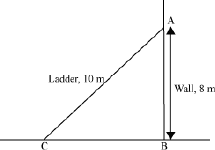
In the above figure, AB is the wall of height 8 m and AC is the ladder of length 10 m. We know that a wall is perpendicular to the floor, i.e. AB is perpendicular to BC. Thus, ∠ABC is a right angle.
Now, can we calculate the distance of the foot of the ladder from the base of the wall?
We can calculate the distance of the foot of the ladder from the base of the wall by using Pythagoras theorem.
In this way, we can use Pythagoras theorem in many situations where right-angled triangle is formed.
Is the converse of Pythagoras theorem also true? Yes, the converse of Pythagoras theorem is also true. Its converse can be stated as follows:
“In a triangle, if the square of one side is equal to the sum of the squares of the other two sides, then the angle opposite to the first side is a right angle”.
But how will we prove it?
Thus, in a triangle, if the square of one side is equal to the sum of the squares of the other two sides, then the angle opposite to the first side is a right angle.
Using the converse, we can check whether the given triangle is a right triangle or not.
Let ABC be a triangle with sides AB = 2.5 cm, BC = 6 cm and CA = 6.5 cm. Can we say that the triangle ABC is a right-angled triangle?

Here, (AB)2 = (2.5)2 = 6.25
(BC)2 = 62 = 36
And, (CA)2 = (6.5)2 = 42.25
Therefore, we obtain
(AB)2 + (BC)2 = 6.25 + 36 = 42.25 = (CA)2
Thus, using the converse of Pythagoras theorem, we can say that the angle opposite to the side CA, i.e. ∠B, is a right angle.
Pythagorean triplet: Any three natural numbers a, b, c form a Pythagorean triplet if it satisfies a2 = b2 + c2 irrespective of order.
General form to find the Pythagorean Triplets:

For example, the number 39, 80, and 89 forms a Pythagorean triplet.
392 = 1521
802 = 6400
892 = 7921
Now, 1521 + 6400 = 7921
∴392 + 802 = 892
Here, the square of a number is equal to the sum of the squares of the other two numbers. Therefore, we can say that 39, 80, and 89 forms a Pythagorean triplet.
Applications of Pythagoras theorem:
Though Pythagoras theorem holds true for only right angled triangle, it can be applied to obtuse and acute angled triangles as well. The obtained results are discussed below:
{1] In acute angled ΔPQR , if PS ∠ QR, QSR is a line and ∠Q < 90° then
PR2 = PQ2 + QR2 – 2QR . QS
Proof: Observe the acute angled triangle ΔPQR.
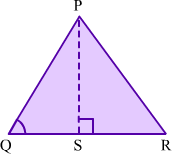
Here, PS ⊥ QR, QSR is a line and ∠Q < 90°.
In ΔPSQ, we have
PQ2 = PS2 + QS2 ...(1) (By Pythagoras theorem)
In ΔPSR, we have
PR2 = PS2 + SR2 (By Pythagoras theorem)
⇒ PR2 = PS2 + (QR – QS)2
⇒ PR2 = PS2 + QR2 + QS2 – 2QR . QS
⇒ PR2 = (PS2 + QS2) + QR2 – 2QR . QS
⇒ PR2 = PQ2 + QR2 – 2QR . QS [Using (1)]
Hence proved.
(2) In obtuse angled ΔPQR , if PS ∠ QR, SQR is a line and ∠Q > 90° then
PR2 = PQ2 + QR2 + 2QR . QS
Proof:
Observe the acute angled triangle ΔPQR.
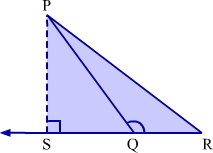
Here, PS ⊥ QR, SQR is a line and ∠Q > 90°.
In ΔPSQ, we have
PQ2 = PS2 + QS2 ...(1)
(By Pythagoras theorem) In
ΔPSR, we have
PR2 = PS2 + SR2 (By Pythagoras theorem)
⇒ PR2 = PS2 + (QR + QS)2
⇒ PR2 = PS2 + QR2 + QS2 + 2QR . QS
⇒ PR2 = (PS2 + QS2) + QR2 + 2QR . QS
⇒ PR2 = PQ2 + QR2 + 2QR . QS [Using (1)]
Hence proved.
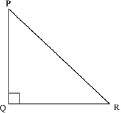
Now, let us discuss some more examples based on Pythagoras theorem and its converse.
Example 1: ΔPQR is an isosceles triangle, right angled at Q. Prove that PR2 = 2PQ2.
Solution:
Here, PQR is an isosceles triangle, right angled at Q. Therefore,
PQ = QR … (1)
Now, using Pythagoras theorem, we obtain
(PR)2 = (PQ)2 + (QR)2
Using equation (1), we obtain
(PR)2 = (PQ)2 + (PQ)2
(PR)2 = 2(PQ)2
Example 2: Two poles are of length 5m and 11m. The distance between the feet of the poles is m. Find the distance between the tops of the poles.
m. Find the distance between the tops of the poles.
Solution:
The figure for the given situation can be drawn as follows.
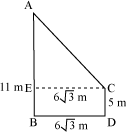
In the above figure, the poles are denoted by AB and CD, where AB = 11 m and CD = 5 m. The distance between the feet of the poles, i.e. BD, is m.
m.
Let us draw a perpendicular CE from C on AB
. AC is the distance between the top of the poles.
Here, BD = CE =  m
m
And AE = AB− BE
= AB − CD [since BE = CD]
= (11 − 5) m
= 6 m
Using Pythagoras theorem in ΔACE, we obtain
(AC)2 = (AE)2 + (EC)2
(AC)2 = (6)2 m2 +  m2
m2
= (36 + 108) m2
= 144 m2
⇒ AC =
⇒ AC = 12 m
Thus, the distance between the tops of the poles is 12 m.
Example 3: O is any point in the interior of ΔABC and OX, OY, and OZ are the perpendiculars drawn from O to BC, CA, and AB respectively.
Prove that
AZ2 + BX2 + CY2 = AY2 + CX2 + BZ2
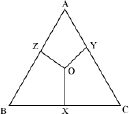
Solution:
Let us join OA, OB, and OC in the given figure.
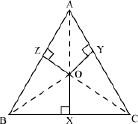
Using Pythagoras theorem in ΔOZA, we obtain
OA2 = OZ2 + AZ2
or AZ2 = OA2 − OZ2 … (i)
Similarly, in ΔBOX and ΔCOY respectively, we obtain
BX2 = OB2 − OX2 … (ii)
and CY2 = OC2 − OY2 … (iii)
On adding equations (i), (ii) and (iii), we obtain
AZ2 + BX2 + CY2 = OA2 + OB2 + OC2 − OZ2 − OX2 − OY2
AZ2 + BX2 + CY2 = (OA2 − OY2) + (OB2 − OZ2) + (OC2 − OX2) … (iv)
Using Pythagoras theorem in ΔOYA, we obtain OA2 = OY2 + AY2
Or AY2 = OA2 − OY2
Similarly, BZ2 = OB2 − OZ2 and CX2 = OC2 − OX2
Using these in equation (iv), we obtain AZ2 + BX2 + CY2 = AY2 + BZ2 + CX2
Hence, proved.
2.Section Formula
Section Formula
Bageecha Singh’s garden is rectangular in shape and its length and breadth are 10 m and 20 m respectively. Two lamp posts in the garden are placed at the ends of a diagonal of the garden. Bageecha Singh wants to place one more lamp post between the two lamp posts that will divide the line segment joining the two lamp posts in the ratio 3:5.
Now, can you help him to find the position of the new lamp post? External division of a line segment:
Observe the figure given below.

Here, AB is a line segment and P is a point outside the line segment AB such that A – B – P (or P – A – B). So, it can be said that the point P divides the line segment AB externally in the ratio AB : BP. Point P is known as the point of external division.
Let the coordinates of points A and B be (x1, y1) and (x2, y2) respectively. Also, let the point P divide the line segment AB externally in the ratio m : n then the coordinates of point P are given by the following formula.
Coordinates of P = 
This formula is known as the section formula for external division.
![]() are the vertices of a ΔABC, then the centroid of ΔABC is
are the vertices of a ΔABC, then the centroid of ΔABC is![]()
Let us solve some examples based on the section formula.
Example 1: Find the coordinates of the point which divides the line segment joining the points (2, 3) and (–1, 7) internally in the ratio 1:2.
Solution:
Let (2, 3) and (–1, 7) be denoted by A and B respectively.

Let C be the point that divides the line segment AB internally in the ratio 1:2.
Using section formula, we obtain
Coordinates of C
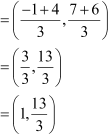
Thus, are the required coordinates of the point.
are the required coordinates of the point.
Example 2: Find the coordinates of the point which divides the line segment joining the points (4, –5) and (6, 2) externally in the ratio 3:2.
Solution:
Let (4, –5) and (6, 2) be denoted by A and B respectively.

Let P be the point that divides the line segment AB externally in the ratio 3:2. Using section formula, we obtain
Coordinates of P

Thus, (10, 16) are the required coordinates of the point.
Example 3: Find the coordinates of the points of trisection of a line segment joining the points (−2, 1) and (4, –3).
Solution:
Let (–2, 1) and (4, –3) be denoted by A and B respectively.
Let C and D be the points of trisection. This means that C divides the line segment AB in the ratio 1 : 2 and D divides the line segment AB in the ratio 2 : 1.

Using section formula, we have
Coordinates of C

and Coordinates of D
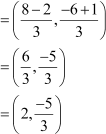
Thus,  and
and  are the points of trisection of a line segment joining the points (– 2, 1) and (4, –3).
are the points of trisection of a line segment joining the points (– 2, 1) and (4, –3).
Example 4: The mid-point of a portion of a line that lies in the first quadrant is (3, 2). Find the points at which the line intersects the axes.
Solution:
The line has been shown in the following graph:
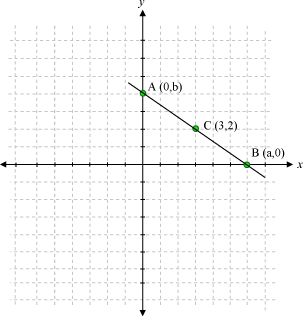
Let A and B be the points of intersection with y and x-axes respectively.
Let the coordinates of A and B be (0, b) and (a, 0).
Here, C is the mid-point of A and B.
∴  = (3, 2)
= (3, 2)
 = (3, 2)
= (3, 2)
On equating the x and y-coordinates on both sides, we obtain
 and
and
∴ a = 6 and b = 4
Thus, the coordinates of A and B are (0, 4) and (6, 0) respectively.
3.Area of Triangle
Area Of A Triangle In A Coordinate Plane
Let us consider a triangle whose base is parallel to x-axis.
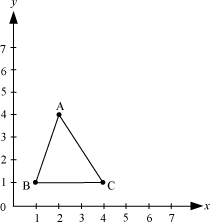
Can you find its area?
Yes, it is a simple question to us as we know that area of triangle is given by the formula
Area
From the figure, it is clear that height of the triangle is 3 units and base is also 3 units.
Area of triangle ABC
 square units
square units
Now, consider the following figure
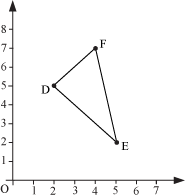
Now, can we calculate the area of ΔDEF? Here, we do not know the base and height. It is very difficult to find the base and height of ΔDEF but we can find the vertices of ΔDEF very easily.
The co-ordinates of D are (2, 5).
The co-ordinates of E are (5, 2).
The co-ordinates of F are (4, 7).
We can calculate the area of ΔDEF by a formula which involves the vertices of a triangle.
Let us derive that formula by considering any triangle, say ΔPQR, such that (x1, y1), (x2, y2), and (x3, y3) are the coordinates of the vertices P, Q and R respectively.

Here, line segments PA, QB and RC are the perpendiculars to X-axis from the vertices P, Q and R respectively. Therefore, PA || QB || RC and hence, quadrilaterals PQBA, PACR and QBCR are trapeziums.
From the figure, it can be seen that
Area of ΔPQR = Area of trapezium PQBA + Area of trapezium PACR – QBCR
We know that
Area of trapezium =  (Sum of parallel sides × Perpendicular distance between parallel sides)
(Sum of parallel sides × Perpendicular distance between parallel sides)
Therefore,
Area of ΔPQR =  (QB + PA)BA +
(QB + PA)BA +  (PA + RC)AC –
(PA + RC)AC –  (QB + RC)BC
(QB + RC)BC


Now, let us find the area of ΔDEF using this formula.

Area of triangle DEF
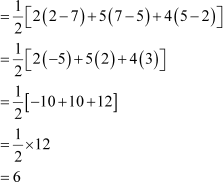
Area of ΔDEF = 6 square units
In this way, we can calculate the area of a triangle in a coordinate plane by using this formula.
Can we have a triangle with area 0 square units? Let us see this.
Let us find the area of a triangle formed by the vertices (1, 4), (−1, 1), and (3, 7).
Now, area

The area of the triangle is 0. What does it mean?
It means that the three given points are collinear.
Thus, “if area of a triangle is zero, then its vertices will be collinear”.
Let us solve some more examples.
Example 1: Find the area of a triangle whose vertices are (−3, −2), (−2, 3), and (3, 4).
Solution:
Let A (−3, −2), B (−2, 3), and C (3, 4) be the vertices of the triangle.
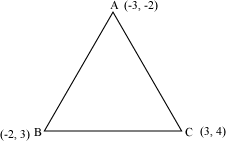
By using the formula,Area of triangle , 
we obtain
Area of ΔABC


Neglecting the negative sign, we obtain
Area of triangle ABC = 12 square units
Example 2: Find the area of a quadrilateral whose vertices are (3, 7), (−5, 3), (−3, −2), and (5, −4) respectively? Solution:
Let ABCD be the quadrilateral as shown in the figure.
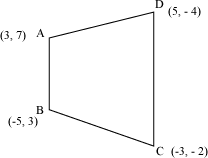
Draw a diagonal BD, which divides the quadrilateral into two triangles.
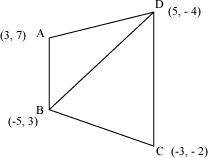
Now, area of quadrilateral ABCD = Area of ΔABD + Area of ΔBCD
Area of ΔABD
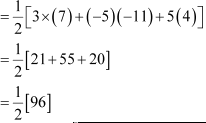
= 48 square units and area of ΔBCD
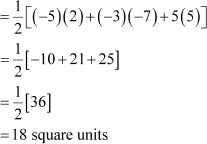
Area of quadrilateral ABCD = 48 + 18
= 66 square units
Thus, the area of quadrilateral ABCD is 66 square units.
Example 3: Find the value of x, if the points (0, 1), (x, −11), and (2, 9) are collinear.
Solution:
It is given that the points (0, 1), (x, −11), and (2, 9) are collinear. Thus, the area of triangle formed by these vertices will be zero.
Now, area of triangle
⇒ 0 =
⇒
⇒ 8x + 24 = 0
⇒ 8x = −24
⇒ x = −3
Thus, the value of x is −3.
2.Trigonometric Ratios of Specific Angles
Trigonometric Ratios Of Some Specific Angles
Trigonometric ratios of some common angles such as 0°, 45°, 90°, etc. are used very often in solving trigonometric questions.
Example 1: Find the value of cos 2A if A = 30°. Solution:
It is given that A = 30°
∴ cos 2A = cos (2 × 30°)
= cos 60°
=
Example 2: Prove that sin 2A = 2 sin A cos A, for A = 45°.
Solution:
L.H.S = sin 2 A = sin (2 × 45°)
= sin 90 °
= 1
R.H.S. = 2 sin A cos A = 2 × sin 45° × cos 45°
= 2 ×
= 1
L.H.S = R.H.S.
∴ sin 2A = 2 sin A cos A
Example 3: From the given figure XYZ, find ∠YZX and ∠ZXY.
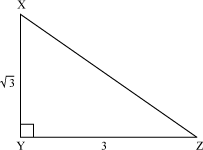
Solution:
It is given that XY = and YZ = 3
and YZ = 3
Now,

∴ ∠YZX = 30°
By angle sum property in ΔXYZ, we obtain
∠ZXY = 180° − 30° − 90°
∴ ∠ZXY = 60°
Example 4: If sin (A + B) = 1 and tan (A −B) = 0, where 0°< A + B ≤ 90°, then find A and B.
Solution:
sin (A + B) = 1,
We know that sin 90° = 1
⇒ A + B = 90° ... (1) tan (A −B) = 0
And, we know that tan 0° = 0
⇒ A − B = 0° ... (2)
On adding (1) and (2), we obtain 2A = 90°
⇒ A = 45°
On putting this value of A in (1), we obtain B = 45°
Thus, the value of both A and B is 45°.
Example 5: Find the value of  , if A = 60° and B = 30°.
, if A = 60° and B = 30°.
Solution:
 =
=
=



Example 6: Find the value of sin2 60° + 2 cos2 30° – tan2 45° + sec2 30°
Solution:
sin2 60° + 2 cos2 30° – tan2 45° + sec2 30°


Example 7: If sin x = sin 60° cos 30° + cos 60° sin 30° then find the value of x.
Solution:
We have
sin x = sin 60° cos 30° + cos 60° sin 30°

⇒ sin x = 1
⇒ sin x = sin 90°
⇒ x = 90°
Example 8: ABCD is a trapezium such that AB || CD and AD = BC.
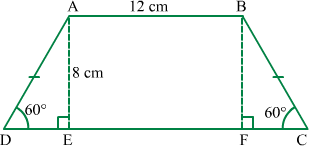
Find the area of the trapezium.
Solution:
In right-angled ΔAED, we have
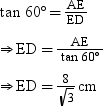
In ΔAED and ΔBFC, we have
AD = BC
∠AED = ∠BEC = 90° and
AE = BF (Perpendiculars drawn between two parallel lines)
∴ΔAED  ΔBFC
ΔBFC
By CPCT, we have
ED = FC = 83√83cm
ABFE is a rectangle, so we have AB = FE = 12 cm
Now, DC = ED + FE + FC =  + 12 cm +
+ 12 cm +  =
= 
Area of trapezium ABCD = (AB + DC) × AE
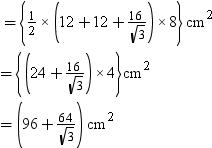
3.Trigonometric Ratios of Complementary Angles
Trigonometric Ratios Of Complementary Angles
Consider the following figure.
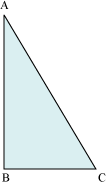
Here, a right-angled triangle ABC has been shown. In this triangle, suppose that the value of
sin C is  .
.
Can we find the value of cos A?
We can use these relations for simplifying the given expression.
For example: Let us express sec 55°− cosec 89° in terms of trigonometric ratios of angles between 0° and 45°.
Now, how can we do so? Let us see.
Since 55° and 35° are complementary angles and also 89° and 1° are complementary angles, we can write 55° as (90° − 35°) and 89° as (90° − 1°).
Therefore,
sec 55° − cosec 89° = sec (90° − 35°) − cosec (90° − 1°)
= cosec 35° − sec 1°
 [ sec (90° – A) = cosec A and cosec (90° – A) = sec A]
[ sec (90° – A) = cosec A and cosec (90° – A) = sec A]
∴ sec 55° − cosec 89°= cosec 35° − sec 1°
Let us now solve some more examples involving trigonometric ratios of complementary angles.
Example 1: Find the value of sin 53° – cos 37°.
Solution:
We know that 53° and 37° are complementary angles as
53° + 37° = 90°
∴ We can write 37° as (90° – 53°).
∴ sin 53° – cos 37° = sin 53° – cos (90° – 53°)
= sin 53° – sin 53°
 [ cos (90° – A) = sin A]
[ cos (90° – A) = sin A]
= 0
Thus, the value of (sin 53° – cos 37°) is 0.
Example 2: Evaluate
Solution:
Here, 27° and 63° are complementary angles as 27° + 63° = 90°
∴ We can write 27° = 90° – 63°
Now,

Example 3: Prove that tan 2A = cot 3A, when A = 18°.
Solution:
When A = 18°,
L.H.S = tan 2A = tan (2 × 18°)
= tan 36°
R.H.S = cot 3A = cot (3 × 18)
= cot 54°
54° and 36° are complementary angles.
∴ We can write 54° as 90° – 36°.
Therefore, cot 3A = cot 54°
= cot (90° – 36°)
= tan 36° [  cot (90° – A) = tan A]
cot (90° – A) = tan A]
∴ L.H.S = R.H.S = tan 36°
∴ tan 2A = cot 3A
Example 4: If sin A = cos A, then prove that A = 45°.
Solution:
It is given that sin A = cos A
⇒ sin A = sin (90° – A)
 [ sin (90° – A) = cos A]
[ sin (90° – A) = cos A]
⇒ A = 90° – A
⇒ 2A = 90°

Hence, proved
Example 5: If P, Q, and R are interior angles of a triangle PQR, which is right-angled at Q, then show that

Solution:
Now, P, Q, and R are the interior angles of the triangle PQR. Therefore, their sum should be 180°.
∴ P + R = 180 – Q
Now, consider the L.H.S. =
=
=
= [
[  cot (90° – A) = tan A]
cot (90° – A) = tan A]
= R.H.S.
∴
Hence, proved
Example 6: Prove that
tan1°× tan 2°× tan 3° … tan 87°× tan 88°× tan 89° = 1
Solution:
Here, 1° and 89° are complementary angles as 1° + 89° = 90°
Therefore, we can write 89° = 90° – 1°
Similarly, 88° = 90° – 2°
87° = 90° – 3°
46° = 90° – 44° and so on
Now, the L.H.S is
tan 1° × tan 2° × tan 3° … tan 44° × tan 45° × tan 46° … tan 87° × tan 88° × tan 89°
= tan 1° × tan 2° × tan 3° … tan 44° × tan 45° × tan (90° – 44°) … tan (90° – 3°) tan (90° – 2°)
tan (90° – 1°)
= tan 1° × tan 2° × tan 3° … tan 44° × tan 45° × cot 44° … cot 3° × cot 2° × cot 1°
[  tan (90° – A) = cot A]
tan (90° – A) = cot A]

= tan 45°
= 1
= R.H.S
∴ tan1° × tan 2° × tan 3° … tan 87° × tan 88° × tan 89° = 1
Hence, proved
4.Trigonometric Identities
Trigonometric Identities
You have studied various algebraic identities so far. Similarly, we have various trigonometric identities, which are true for all variables.
Now, let us prove these identities.
Let us take a standard circle with radius r such that it intersects the X-axis at point A. Also, let the initial arm OA is rotated in anti-clockwise direction by an angle ?.
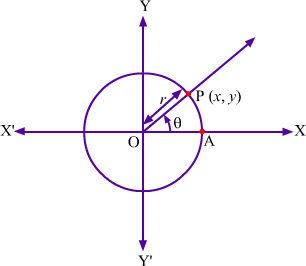
In the figure, the terminal arm intersects the circle at point P (x, y) where x, y ≠ 0 and OP = r. By the definition of trigonometric ratios, we have

Now, OP is a distance between origin O (0, 0) and point P (x, y) which can be obtained by distance formula as follows:

(1) On dividing both sides of the equation (i) by r2, we get
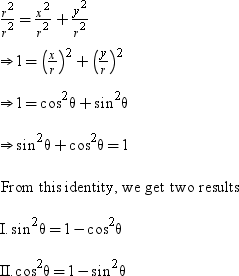
(2) On dividing both sides of the equation (i) by x2 (x ≠ 0), we get
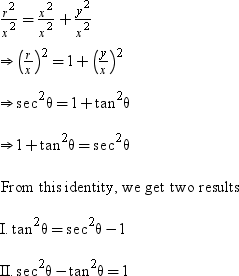
(3) On dividing both sides of the equation (i) by y2 (y ≠ 0), we get
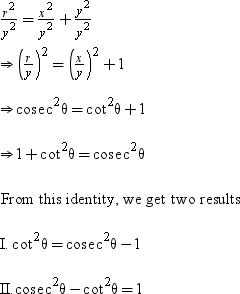
Corollary:
(i) When x = 0 then we have

In this case, the identities sin2θ + cos2θ = 1 and 1 + cot2θ = cosec2θ exist but the identity 1 + tan2θ = sec2θ does not exist.
(ii) When y = 0 then we have

In this case, the identities sin2θ + cos2θ = 1 and 1 + tan2θ = sec2θ exist but the identity 1 + cot2θ = cosec2θ does not exist.
Now, we know the basic trigonometric identities, let us see the following video to know how to use these identities.
Example 1: Find the value of the expression (sec227° – tan27°.cot63°).
Solution:
sec227° – tan27°.cot63° = sec227° – tan27°.cot (90° – 27°)
[27° and 63° are complementary angles]
= sec227°– tan27°.tan27° [cot (90° – ?) = tan ?]
= sec227° – tan227°
= 1 + tan227° – tan2 27° [Using the identity 1 + tan2 θ = sec2 θ]
= 1
Thus, the value of the given expression is 1.
Example 2: Write all the trigonometric ratios in terms of sin A.
Solution:
Using the identity
sin2A + cos2A = 1,
we can write, cos2A = 1 – sin2A
Taking square root on both sides,

Now,
 [Using (i)]
[Using (i)]
⇒

⇒

⇒ [Using (i)]
[Using (i)]
and,
The trigonometric ratios in terms of sin A are given by (i), (ii), (iii), (iv), and (v).
Example 3: Simplify the following expression.
[(1 + cot A – cosec A)(1 + tan A + sec A)]
Solution:
(1 + cot A – cosec A)(1 + tan A + sec A)
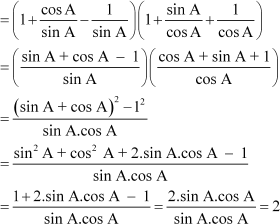
Thus, the value of the given expression is 2.
Use Of Trigonometric Identities In Proving Relationships Involving Trigonometric Ratios
Can we prove the following relation?

To prove this relation, we will make use of the following identities.
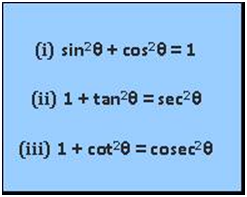
Let us see how to prove this.
We can take any side, L.H.S or R.H.S, of the above relation and prove it equal to the other side.
Now, L.H.S. =
=  (by rationalising the denominator)
(by rationalising the denominator)
=
 = (Using the identity 1 + cot2θ = cosec2θ)
= (Using the identity 1 + cot2θ = cosec2θ)
=
= sec A + tan A
= R.H.S.
Thus,
In this way, we use the above mentioned trigonometric identities to prove other relations involving trigonometric ratios.
Let us now look at another approach to solve a relation.
In this method, we simplify both L.H.S and R.H.S. and when we reach at a common point, we can say that the L.H.S. and R.H.S. are equal.
Let us try to prove that 2tan2A + tan4A = sec4A − 1.
Taking the L.H.S of the equation,
The L.H.S is given as 2tan2A + tan4A.
= tan2A (2 + tan2A)
= (sec2A − 1) (2 + sec2A − 1) [Using the identity 1 + tan2A = sec2A, we obtain tan2A = sec2A − 1]
= (sec2A − 1) (sec2A + 1)
The R.H.S is given by sec4A − 1.
= (sec2A − 1) (sec2A + 1) [a2 − b2 = (a − b) (a + b)]
Therefore, by solving both L.H.S and R.H.S, we obtain (sec2A − 1) (sec2A + 1).
Thus, we can say that 2tan2A + tan4A = sec4A − 1.
Now let us look at some more examples.
Example 1: Prove that  .
.
Solution:
L.H.S =
[Multiplying and dividing by (1 + sin A)]

 [Using the identity cos2A + sin2A = 1]
[Using the identity cos2A + sin2A = 1]

= R.H.S
∴
Example 2: Prove that
Solution:
L.H.S = (cosec A − sin A) (sec A − cos A)
= cosec A × sec A − cosec A × cos A − sin A × sec A + sin A × cos A
 + sin A × cos A
+ sin A × cos A
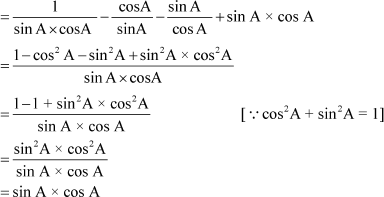
And R.H.S is given by

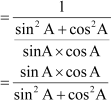
= sin A × cos A [∵sin2A + cos2A = 1]
Now L.H.S = R.H.S = sin A × cos A
∴
2.Number of Tangents from a Point on the Circle
Tangents Drawn From An External Point To A Circle
We are very well aware of what a tangent is. Now let us look at the following video and find out how many tangents can be drawn to a circle from an external point and if there is any relation between the lengths of these tangents.
The lengths of the two tangent segments to a circle drawn from an external point are equal.
Proof:
Let P be the point outside the circle having centre O from which the tangents PQ and PR are drawn touching the circle at Q and R respectively.
We have to prove that PQ = PR.
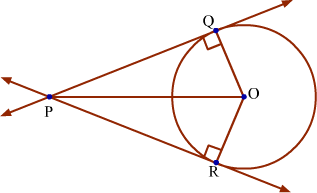
From the figure, it can be observed that OQ and OR are the radii of the circle. Therefore, ∠PQO = ∠PRO = 90°
Now, in ΔPOQ and ΔPOR, we have
∠PQO = ∠PRO = 90°
PO = PO (Common hypotenuse)
OQ = OR (Radii of same circle)
Using RHS (Right-Hypotenuse-Side) congruence rule, we get
ΔPOQ ΔPOR
ΔPOR
∴ PQ = PR (By CPCT)
Thus, the lengths of the two tangent segments to a circle drawn from an external point are equal.
Note: Since ΔPOQ ΔPOR, we have
ΔPOR, we have
∠OPQ = ∠OPR (By CPCT)
∠POQ = ∠POR (By CPCT)
Thus, the above theorem can be extended as,
(1) The tangents drawn to a circle from an external point are equally inclined to the line joining the external point and the centre.
(2) The tangents drawn to a circle from an external point subtend equal angles at the centre.
Now, let us solve some examples to understand the concept.
Example 1: In the given figure, prove that TL + AL = TM + AM
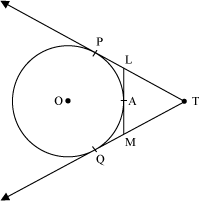
Example 2: A circle is circumscribed by a quadrilateral PQRS such that the circle touches all the sides of quadrilateral PQRS at points A, B, C, and D respectively. Show that
PQ + RS = QR + PS
Solution:
The figure can be drawn as follows.
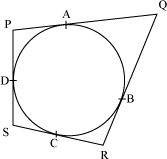
Now, applying the theorem “The tangents drawn from an external point to the circle are equal in length”, we obtain

Therefore,
PQ + RS = (PA + QA) + (RC + SC)
= (PD + QB) + (RB + SD) [Using (i)]
= (PD + SD) + (QB + RB)
= PS + QR
Thus, PQ + RS = PS + QR
Hence, proved
Example 3: A circle is inscribed in a triangle ABC such that the circle touches the sides AB, BC, and AC of the triangle at P, Q, and R respectively. What are the lengths of AP, BQ, and CR if AB = 10 cm, BC = 6 cm, and AC = 12 cm.
Solution:
The figure can be drawn as follows.
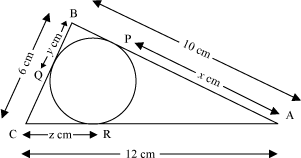
Let AP = x cm, BQ = y cm, and CR = z cm.
Now, applying the theorem “The tangents drawn from an external point to the circle are equal in length”, we obtain
AP = AR = x
BQ = BP = y
CR = CQ = z
Therefore, we can write
AP + BP = AB
 x + y = 10 cm … (i)
x + y = 10 cm … (i)
BQ + QC = BC
 y + z = 6 cm … (ii)
y + z = 6 cm … (ii)
CR + AR = AC
 z + x = 12 cm … (iii)
z + x = 12 cm … (iii)
On adding (i), (ii), and (iii), we obtain
2x + 2y + 2z = 28 cm
 x + y + z = 14 cm … (iv)
x + y + z = 14 cm … (iv)
Subtracting (i) from (iv), we obtain
(x + y + z) – (x + y) = 14 – 10
 z = 4 cm
z = 4 cm
Similarly, subtracting (ii) and (iii) respectively from (iv), we obtain
(x + y + z) – (y + z) = 14 – 6
 x = 8 cm
x = 8 cm
(x + y + z) – (z + x) = 14 – 12
 y = 2 cm
y = 2 cm
Thus, AP = 8 cm, BQ = 2 cm, and CR = 4 cm
Example 4: In the given figure, PQR is an isosceles triangle with PQ = PR. A circle, which is inscribed in ΔPQR, touches the sides of the triangle at A, B, and C. Show that AQ = AR.
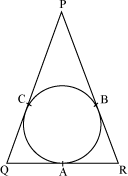
Solution:
It is given that PQR is an isosceles triangle where
PQ = PR … (i)
Now, the tangents drawn from an external point to a circle are equal in length.
∴ PC = PB … (ii)
On subtracting equation (ii) from equation (i), we obtain
PQ – PC = PR – PB
QC = RB … (iii)
Now, QA and QC are tangents to the circle from point Q.
∴ QA = QC
Similarly, RB = RA
Using the above relations in equation (iii), we obtain
QA = RA
∴ AQ = AR
Example 5: PA and QA are tangents drawn to a circle with centre O. Show that ∴BOQ
= ∴PAQ.
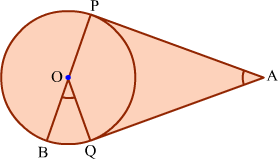
Solution:
Join O with A, P with Q.
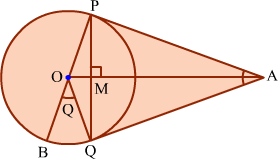
We know that, the tangents drawn to a circle from an external point are equal and they are equally inclined to the line joining the external point and the centre.
Therefore, ∠PAO = ∠QAO and ∠POA = ∠QOA.
It is clear that PQ ⊥ OA.
Now, ∠BOQ = 2∠OPQ … (1)
[Angle subtended by an arc at the centre is twice the angle subtended by the same arc at anywhere on the Circle]
Let ∠PAO = ∠QAO = θ. In ΔPMA,
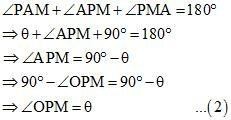
From (1) and (2), ∠BOQ = 2θ. Therefore,

Hence, the result is proved.
2.Area of Sector and Segment of a Circle
Area Of Segment Of A Circle
There is a design on a square window glass as shown below.
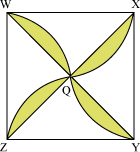
The shaded portion is coloured yellow. They are the segments of a circle whose radius is 7 cm and the angle of the sector is 90°. Rest all the portion is transparent. Can we calculate the area of the shaded portion?
To calculate the area of the shaded portion, we should know how to calculate the area of segments of the circle.
Firstly, let us know the formula to find the area of the segment of a circle.
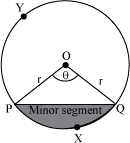
The above figure shows a circle with radius r. OPXQ is a sector of the circle. The angle of sector is θ. PXQP is a segment of the circle.
From the figure, we can see that
Area of the segment PXQP = area of the sector OPXQ − area of the triangle OPQ
 – area of ΔOPQ
– area of ΔOPQ
Using this formula, we can calculate the area of the shaded portion in the figure discussed in the beginning.
In that figure, the radius of the circle is given as 7 cm and angle of the sector 90°. To calculate the area of the shaded portion, we will calculate the area of each segment. Let us draw the circle whose segment has been shown in the given figure. On drawing the circle, we obtain the following figure.
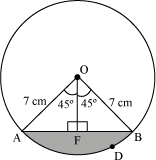
The sector has the angle 90° at the centre, i.e.  AOB = 90°.
AOB = 90°.
Let us draw a perpendicular from O to AB, i.e. OF  AB.
AB.
Now in Δ OAF and Δ OBF,
OA = OB (radius of the circle)
∠OFA = ∠OFB (both 90°)
OF = OF (common side)
By RHS Congruence rule,
ΔOAF ≅ ΔOBF
Therefore, AF = BF =  AB (by CPCT)
AB (by CPCT)
And ∠AOF = ∠BOF =  ∠AOB (by CPCT)
∠AOB (by CPCT)
= × 90° = 45°
× 90° = 45°
We know,

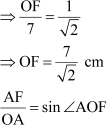
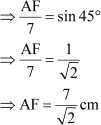
But we know that

⇒ AB = 2 AF
 cm
cm
=  cm
cm
In ΔOAB,
Base =  cm
cm
And corresponding height = cm
cm
Thus, area of ΔOAB = × base × height
× base × height
 = ×
= ×
 cm2
cm2
Given, r = 7 cm
θ = 90°
Thus, area of sector OADB

Therefore, area of the minor segment ADB
= Area of sector OADB − area of ΔOAB
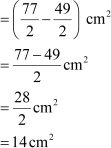
We have calculated the area of one such segment. But we have 4 such segments. Thus, the area of shaded portion is 56 cm2.
It can be seen that it was a very lengthy process to find the area of triangle in the above discussed case.
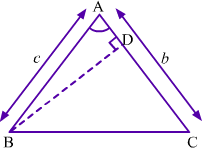
The area of triangle can be calculated in the other way as well. Let us see how. Let us consider ΔABC such that AB = c and AC = b.
BD is perpendicular to AC. Thus, BD is the height of ΔABC corresponding to base AC. In right-angled triangle ΔADB, we have

⇒ BD = AB sin A
⇒ BD = c sin A
Now,
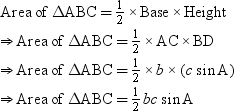
Similarly, we can find the area of the triangle inside the circle. Look at the following figure.
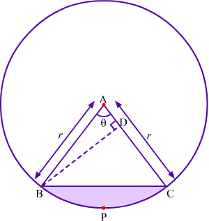
Here, AB = c = r, AC = b = r and ∠A = θ.

It can be seen that the area of triangle is in the form of radius of circle and central angle. For this figure, area of the segment BPC can be calculated as follows:
Area of segment BPC = Area of sector ABPC – Area of ΔABC

Using this formula, we can easily find the area of segment of circle of given radius. Let us solve some examples to understand this concept better.
Example1: Find the area of the segment ADB and AEB in the following figure. (Take π = 3.14)
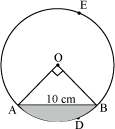
Solution:
In the above figure, chord AB = 10 cm and ∠AOB = 90°.
Now, we have to find out the radius of the circle.
We know that OA = OB (radii of the same circle)
ΔOAB is right-angled triangle as ∠AOB = 90°.
By using Pythagoras Theorem, we obtain
OA2 + OB2 = AB2
OA2 + OA2 = AB2
2OA2 = 102
2OA2 = 100
OA2 = 50
OA =  = 5
= 5 ![]() cm
cm
Hence, r = 5  cm and θ = 90°
cm and θ = 90°
Area of minor segment ADB = Area of sector OADB − Area of ΔOAB
= 
= 
=
= 39.25 − 25
= 14.25 cm2
Area of the major segment AEB = − area of the minor segment ADB
− area of the minor segment ADB
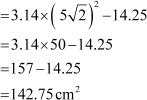
Thus, the area of segment ADB is 14.25 cm2 and the area of segment AEB is 142.75 cm2.
Example 2: In the given figure, O is the centre of the circle with radius 20 cm. Also, area of the shaded portion is 72.66 cm2 and the area of unshaded portion is 346 cm2. Find the measure of θ. ( = 3.14)
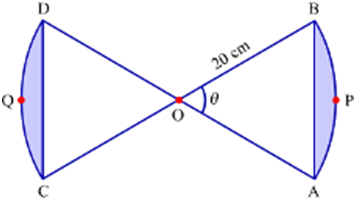
Solution:
It can be seen that the shaded portion has two equal segments APB and CQD of same circle with radius 20 cm whereas the unshaded portion has two equal triangles ΔAOB and ΔCOD.
Radius of circle (r) = 20 cm
∠AOB = ∠COD = θ


Area of segment APB = Area of sector OAPB – Area of ΔAOB
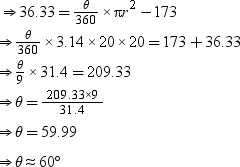
Example 3: In the given figure, O is the centre of the circle. Also, area of the shaded portion is 28.5 cm2. Find the area of the circle. (  = 3.14)
= 3.14)
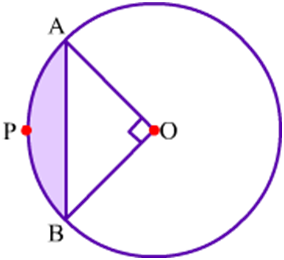
Solution:
We have,
θ = 90°
Area of segment = 28.5 cm2
Let the radius of the circle be r. Now,
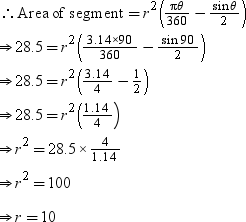
Thus, radius of circle is 10 cm.
Now,
Area of circle =  r2
r2
⇒ Area of circle = (3.14 × 10 × 10) cm2
⇒ Area of circle = 314 cm2
Area of Combination of Circles and Other Plane Figures
In our daily life, we come across various forms of interesting designs that are a combination of plane figures (like design on flower beds, windows, table covers etc.).
Suppose ABCD is a square land in a resort with side 200 m. There are four artificially created circular ponds of equal area in the land such that the perimeter of each pond touches two of the other three and also the perimeter of the land. The rough sketch of the land is shown below.
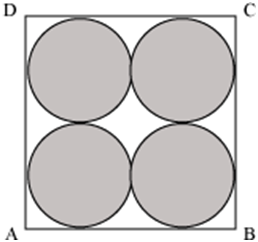
Can we calculate the area of the remaining portion of the land that is the area of the land without water?
Example 1: In the following figure, there are two concentric circles. If the ratio of the radius of the larger c
ircle to that of the smaller circle is 3:2 and the length of the radius of the smaller circle is 14 cm, then find the area of the shaded portion. (Take π =![]() )
)
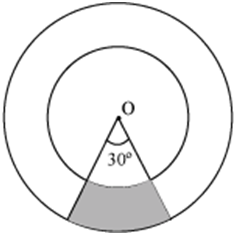
Solution
Let, the length of the radius of the larger circle be r1.
Given, length of the radius of the smaller circle, r2 = 14 cm
The ratio of the lengths of the radii is

Now, area of the shaded portion = area of the sector of the larger circle with angle 30°
– area of the sector of the smaller circle with angle 30°
Area of the sector of the larger circle with angle 30° =

= 115.5 cm2
Area of the sector of the smaller circle with angle 30° =

= 51.33 cm2 (approx.)
Therefore, area of the shaded portion = (115.5 − 51.33) cm2
= 64.17 cm2
Example 2: PQR is a right-angled triangle in which  , ∠Q = 90°. If PSR is an arc of a circle with radius 7 cm and centre Q and PTR is a semi-circle with diameter PR, then find the area of the shaded portion.
, ∠Q = 90°. If PSR is an arc of a circle with radius 7 cm and centre Q and PTR is a semi-circle with diameter PR, then find the area of the shaded portion.

Solution:
Given, length of the radius of the circle, r = 7 cm
Also,
Hence,  and
and  are the radii of the circle.
are the radii of the circle.
Given, ∠Q = 90°.
Thus, the portion described by QPSR is a quadrant of the circle with radius 7 cm.
Area of the quadrant QPSR = × area of the circle with radius 7 cm
× area of the circle with radius 7 cm

= 38.5 cm2
On applying Pythagoras theorem in the right-angled triangle PQR, we obtain

Now, area of the semi-circle PTR =

= 38.5 cm2
Area of the triangle PQR =  × base × height =
× base × height =  × 7 × 7 cm2 = 24.5 cm2
× 7 × 7 cm2 = 24.5 cm2
Thus, area of the segment PSR = area of the quadrant QPSR − area of ΔPQR
= (38.5 − 24.5) cm2
= 14 cm2
Therefore, area of the shaded portion = area of the semi-circle PTR − area of the
segment PSR
= (38.5 − 14) cm2
= 24.5 cm2
Example 3: In the following figure, the two mutually perpendicular diameters PQ and RS of the circle meet at centre O. Another circle is drawn through R and O. If the area of the shaded portion is 266 cm2, then find the radius of the circle.
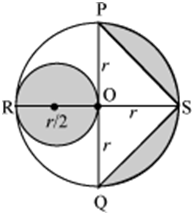
Solution:
Let the radius of original circle = r = OS = OP = OQ = OR
Radius of the circle through R and O =
As PQ and RS are perpendicular to each other, therefore, OS is the height of the triangle PSQ.
It can be clearly noticed from the figure that
Area of shaded portion = Area of circle through R and O + Area of semi-circle PSQ − Area of Δ PSQ
266 =
266 =
266 =
266 =
266 =
266 =


Hence, the radius of the circle is 14 cm.
2.Conversion of Solid from One Shape to Another
Conversion Of Solids From One Shape Into Another
In our daily life, we come across various shapes of objects. For example, we see the objects of wax (candle) in various shapes like cylindrical, conical, circular etc. Have you ever thought how these objects are made?
First of all, the wax is melted and after that the liquid wax is poured into containers which have the special shape in which we want to mould the wax. Then after cooling the wax we get the desired shape.
We also convert solids from one shape into another. For example, a metallic wire of cylindrical shape is melted and recast into a spherical shape; earth dug out from a well is uniformly distributed to form an embankment around it.
The main concept in such conditions is that the amount of material before the conversion remains the same as the amount of material after the conversion or we can say that the volume before the conversion and after the conversion remains constant.
Let us consider a situation where we have a ball which is made up of wax. We measured the radius of the ball and it came out to be 3 cm. Now, we want to make a candle of length 16 cm from the wax ball. What should be the radius of the mould so that no wax is wasted?
We use this concept for solving the problems related to conversion of solids. Let us discuss some examples based on the above idea.
Example 1: A solid right circular metallic cone of radius 10 cm and height 5 cm is melted and recast into a sphere. Find the radius of the sphere.
Solution:
Let us consider the above information geometrically.
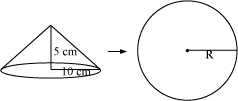
It is given that radius of cone, r = 10 cm
Height of cone, h = 5 cm
Let R be the radius of sphere.
Since the cone is melted to form a sphere,
Volume of metal before conversion = volume of metal after conversion
∴ Volume of cone = Volume of sphere



 cm
cm
Thus, the radius of the sphere is 5 cm.
Example 2: If the volumes of a solid hemisphere, a solid right circular cone and a solid right circular cylinder of same base are equal, then find the ratio of their heights.
Solution:
Let us consider the above information by drawing figures.

All the three solids have equal base, i.e. their radii are equal.
Let r be the radius of the above three figures. The height of the hemisphere will also be r. Let the height of the cone and cylinder be h and H respectively.
But it is given that,
Volume of hemisphere = Volume of cone = Volume of cylinder



The LCM of 2, 1, and 3 is 6.
Now, let us write
 = 6x
= 6x
⇒
Hence,
Now, r: h: H = 3x: 6x: 2x
r: h: H = 3: 6: 2
∴ Ratio of their heights = 3: 6: 2
Example 3: A solid right circular metallic cone of height 5 cm and radius 21 cm is melted to form some coins of diameter 2 cm and width 6 mm and some spherical balls of diameter 3 cm. If the ratio of the number of coins to the number of balls is 2:3, then find the number of coins and balls.
Solution:
For the cone,
Height, h = 5 cm and radius, r = 21 cm

For cylindrical coin,
Diameter = 2 cm
So, radius, r1 = 1 cm
Height, h1 = 6 mm = 0.6 cm
For spherical balls,
Diameter = 3 cm
So, radius, r2 = cm
cm
Let number of spherical coins = 2x and number of spherical balls = 3x
Metallic cone is melted and recast to form coins and balls.
∴ Volume of coins + Volume of balls = Volume of Cone






∴ Number of coins = 2x = 2 × 50 = 100
And number of spherical balls = 3x = 3 × 50 = 150
Example 4: A solid toy is in the form of a hemisphere surmounted by a right circular cone. The height of the cone is 10 cm and the diameter of the base is 14 cm. The toy is placed in a cylinder which is half filled with water. Find the height of increase in water level in the cylinder, if the radius of the cylinder is 14 cm.
Solution:
Let us draw the figure for the given information.
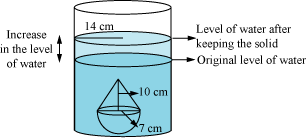
For the toy,
Diameter of the hemisphere = 14 cm
Radius of hemisphere, r = 7 cm (Also radius for cone)
Height of the cone, h = 10 cm
For the cylinder, Radius, R = 14 cm
Let height of increase in the level of water = H
When the toy is kept in the cylindrical vessel, the water will rise uniformly taking the shape of a cylinder, i.e. the increase in the level of water will be in the shape of a cylinder of radius 14 cm.
Volume of water raised in the cylinder = Volume of the toy




 cm
cm
Thus, the water level will become 2 cm high after keeping the toy in the cylindrical vessel.
3.Surface Area & Volumes – Frustum of a Cone
Surface Areas of Frustum of Cone
Look at the following figure.

In day to day life, we come across various shapes similar to this, such as a glass, a bucket, a funnel, etc. This shape is known as frustum of cone.
Now, can we describe what a frustum is?
The solid obtained by cutting a cone by a plane parallel to its base is known as frustum of a cone.
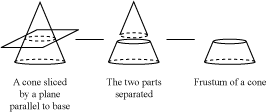
We can observe from the following figure that a cone is sliced by a plane parallel to the base. After removing the smaller cone, we obtain a solid which is known as frustum of cone.
The given figure shows an iron tub and its dimensions. Its exterior curved surface is to be polished. Can we find the area of iron tub to be polished?![]()
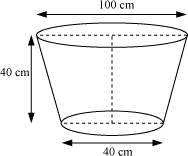
To find the total surface area of a frustum, we just need to add the areas of its two circular faces to its curved surfaces area.
Therefore,
Total surface area of frustum = Curved surface area + Area of two circular faces Total surface area of a frustum = π(r1 + r2)l + πr12 + πr22
Let us look at some examples to understand the concept better.
Example 1: A shuttle cock, which is used for playing badminton, has the shape of a frustum mounted on a hemisphere as shown in the following figure. The dimensions are also shown in the figure. Find the outer curved surface area of the shuttle cock. (Use π = 3.14)
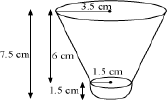
Solution:
It is given that,
r1 = radius of upper end of frustum = 3.5 cm
r2 = radius of lower end of frustum = 1.5 cm (Also the radius of the hemisphere)
h = height of the frustum = cm
cm
Now, slant height,


= 6.32 cm
Outer curved surface area of shuttle cock = C.S.A. of frustum + C.S.A. of hemisphere
=  +
+
=
= 99.22 + 14.13
= 113.35 cm2
Thus, the required surface area is 113.35 cm2.
Example 2: A solid is in the shape of the frustum of a cone. The radii of its circular ends are 7 cm and 14 cm. The total surface area of the solid is 2420 cm2. What is the height of the solid?
Solution:
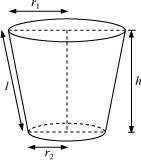
The solid is in the shape of a conical frustum with radii 7 cm and 14 cm and total surface area 2420 cm2.
Let r1 and r2 be the radii of the solid. Let l and h be its slant height and height respectively.
The total surface area of the frustum is given by  .
.
Here, r1 = 14 cm and r2 = 7 cm
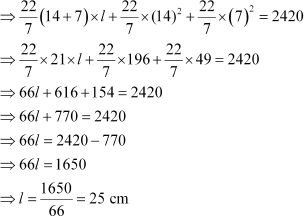
Now,![]()
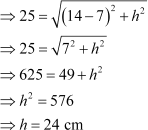
Thus, the height of the solid is 24 cm.
Example 3: The given figure shows a wooden shape which is in the shape of a frustum of a cone. The diameters of the upper and lower circular part are 4 ft and 8 ft respectively. Its curved surfaces are painted with red colour. If the cost of painting is Rs 660 at the rate of Rs 5 per ft2, then find the height of the wooden shape.

Solution:
The cost of painting is given to be Rs 660.
The area that was painted is the curved surface area of the wooden shape.
Also, it is given that the rate of painting is Rs 5 per ft2.
∴ C.S.A. of the wooden shape = = 132 ft2
= 132 ft2
We know, C.S.A. = π (r1 + r2) l, where r1 and r2 are the radii of the ends of the frustum shaped wood and l is the slant height.

We have, π (r1 + r2) l = 132 ft2
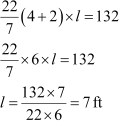
Let h be the height of the wooden shape.
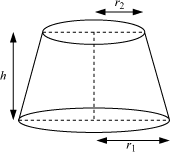
Then, we have
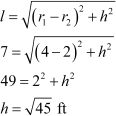
Thus, the height of the wooden shape is ft.
ft.
Example 4: Adam brought a conical pancake (a cake eaten in USA) that was 16 cm high with vertical angle of 60° and kept it in a refrigerator. After sometime, his cousin Susan came and cut the pancake into two parts with the help of a knife at the middle point of its height and took the smaller part. She also covered the tissue paper entirely around the remaining cake. Calculate the least amount of paper in terms of π that she required to cover the pancake.
Solution:
Let us consider the following figure in order to understand the question properly.
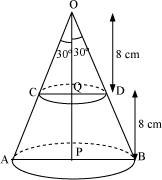
Adam brought the conical pancake OAB whose vertical angle ∠AOB = 60°.
Here, height of the pancake, OP = 16 cm
Let us consider Q as the mid-point of OP. Susan cut the pan cake into two parts through Q.
Therefore, we have OQ = cm
cm
Also, ∠AOP and  COQ =
COQ =
After cutting conical pancake OCD from pancake OAB, the remaining pancake is in the shape of a frustum.
In ΔAOP,

⇒ cm
cm
Also in Δ COQ,

⇒  cm
cm
Height of the frustum, h = PQ = OP − OQ = 16 − 8 = 8 cm
Now, slant height of frustum
=
=
=
= cm
cm
T.S.A. of the frustum = +
+
=
=
= cm2
cm2
Thus, Susan required  cm2 of paper to cover the remaining pancake.
cm2 of paper to cover the remaining pancake.
Volume Of A Frustum Of A Cone
Suppose there is a container made up of metal sheet in the form of a frustum of a cone of height 14 cm with diameter of its lower and upper ends as 50 cm and 20 cm respectively.
Can we find the cost of honey which can completely fill the container at the rate of Rs 150 per litre?
Let us look at some more examples to understand the concept better.
Example 1: A metallic right circular cone, 14 cm high and whose vertical angle is 60°, is cut into two parts at the middle of its height by a plane parallel to its base. If the frustum so obtained is drawn into a wire of diameter mm, then find the length of the wire.
mm, then find the length of the wire.
Solution:
Let us consider the following figure in order to understand the question properly.
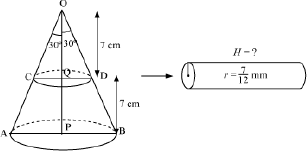
Let OAB be the cone whose vertical angle ∠AOB = 60°. Let r1 and r2 be the radii of the lower and upper end of the frustum.
Here, height of the cone, OP = 14 cm
Let us consider Q as the mid-point of OP.
After cutting the cone into two parts through Q,
OQ =
Also, ∠AOP and ∠COQ =
After cutting cone OCD from cone OAB, the remaining solid obtained is a frustum.
In ΔAOP,

⇒ cm
cm
Also in ΔCOQ,

⇒  cm
cm
Height of the frustum, h = PQ = OP − OQ = 14 − 7 = 7 cm
For the cylinder shaped wire,
Radius, r = =
=  mm =
mm = cm
cm
Let the length of the wire be H.
It is given that the frustum is drawn into a cylindrical wire.
∴ Volume of Cylinder = Volume of Frustum
 =
=
 =
=



 =
=
Thus, the length of the wire drawn from the frustum is 784 m.
Example 2: A hollow cone of height 30 cm is cut by a plane parallel to the base, and the upper portion is removed. If the volume of the remainder (frustum of cone)  is of the volume of the whole cone, then find the ratio of the altitudes of the frustum and the cone that is removed.
is of the volume of the whole cone, then find the ratio of the altitudes of the frustum and the cone that is removed.
Solution:
Let us consider that cone OCD ( radius r2, height h2, and slant height l2) is removed from a cone OAB of radius r1, height h1, and slant height l1, where circular base CD is parallel to circular base AB.
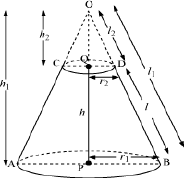
In the triangles OQD and OPB,
(i) ∠QOD = ∠POB
(ii) ∠ODQ = ∠OBP
(As base CD is parallel to base AB, corresponding angles are equal)
Hence, by AA Similarity Criterion,
ΔOQD ~ ΔOPB
Therefore, (CPCT)
(CPCT)
 … (1)
… (1)
Given that volume of frustum =  ×volume of the whole cone
×volume of the whole cone
Volume of the cone OAB − Volume of cone OCD =  ×volume of cone OAB
×volume of cone OAB
Volume of cone OCD = × volume of cone OAB
× volume of cone OAB


![]()
![]()
![]()
![]()
![]()
 (Putting the value of h1 = 30 cm)
(Putting the value of h1 = 30 cm)
h2 = 18 cm
Now, PQ = h =  cm
cm
Hence, the section is made above 12 cm from the base.
Ratio of the altitudes of the frustum and the cone that is removed
=  =
= = 2:3
= 2:3
2.Mode of Grouped Data
Mode Of Grouped Data
Consider the following frequency table.

From the table, we can easily observe that the observation 5 has maximum frequency which is 41.
Thus, the mode of the given data is 5. Thus, the mode can be defined as

When the data is given in grouped form, we cannot find the mode by looking at the frequencies. Let us consider the following example.
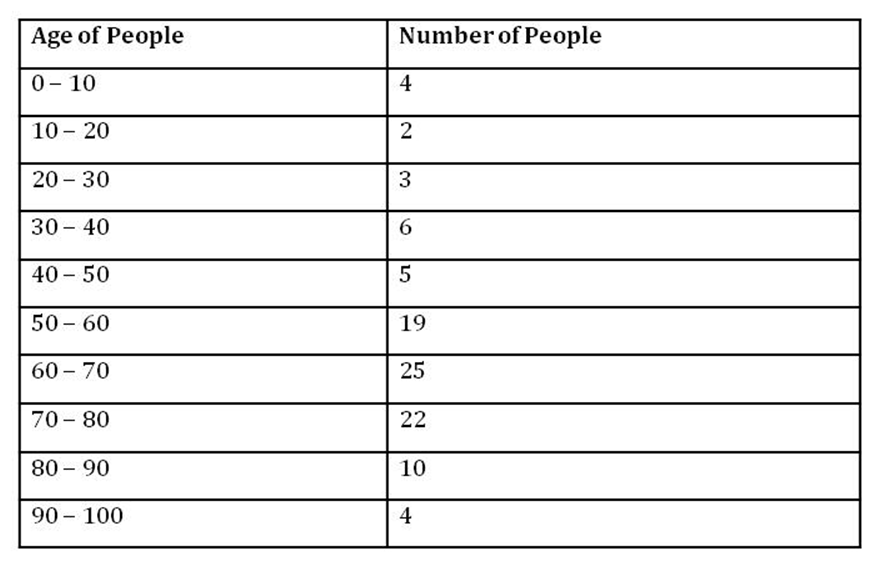
From the above table, we can observe that the maximum frequency is 25 and corresponds to the class interval of 60 − 70. However, we are not sure that exactly which value in the
class interval 60 − 70 is the mode because we do not know the actual age of these 25 people.
In such situations, we use a formula to find the mode. Therefore, first of all, let us look at the formula to be used in such cases.
The formula used to find the mode when the data is given in groups is as follows.

Where, l = lower limit of the modal class
h = size of class interval (all class sizes should be equal)
f1 = frequency of the modal class
f0 = frequency of the class preceding the modal class
f2 = frequency of the class succeeding the modal class
Before discussing the previous example, let us first know what a modal class is.
![]()
Let us discuss the previous example to understand the method of finding the mode, when the data is given in a grouped form.
Now, consider the previous example again.
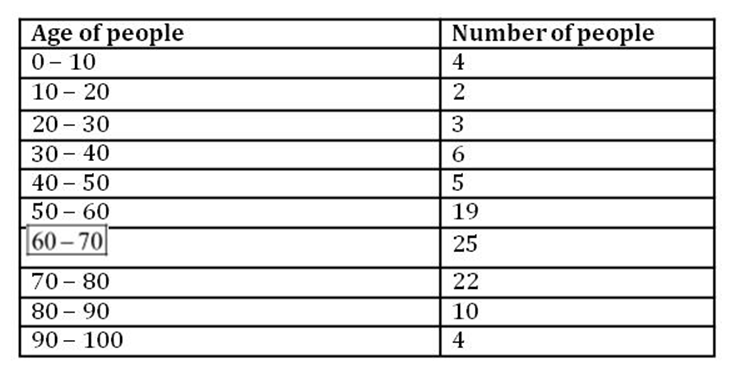
Here, the maximum frequency is 25, and this corresponds to the group 60 − 70. Therefore, the modal class is 60 − 70.
We can calculate the mode by using the following formula.
Mode =
From the above table,
l = 60
f1 = 25
f0 = 19
f2 = 22
h = 70 − 60 = 10
Using the formula,
Mode =

Mode =

= 60 + 6.67
= 66.67
Therefore, the mode of the given data is 66.67.
Here, we can observe that the mode lies inside the modal class 60 − 70. Let us solve more problems using this formula.
Example 1: The following table shows the class intervals and the frequency corresponding to them.

Find the mode of the given data.
Solution:
In the given table, the maximum frequency is 24 corresponding to the class interval 40 − 60. Therefore, the modal class is 40 − 60.
From the table,
l = 40
h = 20
f0 = 15
f2 = 16
f1 = 24
Mode =

Mode =

= 40 + 10.59
= 50.59
Thus, the mode of the given data is 50.59.
Example 2: Data collected about the weights of 70 students of a class is given in the following table.

Find the modal weight of the class. Solution:
It can be seen that the class intervals are of inclusive type, so we need to make them of exclusive type to calculate the mode.
The modified table will be as follows:
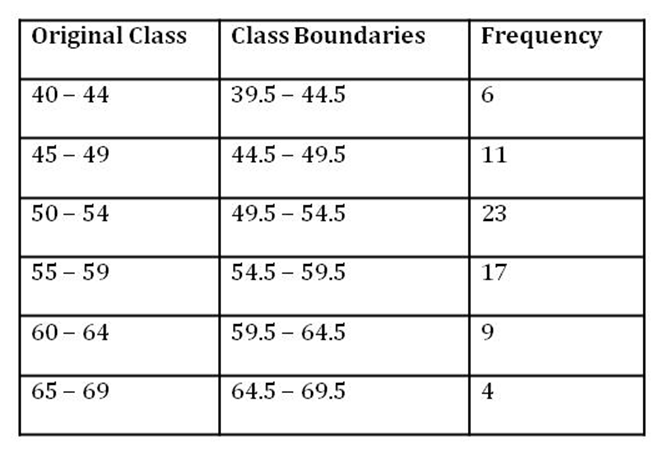
Here, the maximum frequency is 23 which corresponds to the class interval 49.5 − 54.5. Therefore, the modal class is 49.5 − 54.5.
From the table, we have
l = 49.5
h = 5
f0 = 11
f2 = 17
f1 = 23
Mode =

= 49.5 + 3.33
= 52.83
Thus, the modal weight of the class is 52.83 kg.
Example 3: If the modal class is 45 − 60 and mode of the distribution is 58, then find the missing frequency in the following table.

Solution:
The mode of the distribution is given as 58, which lies in the class interval 45 − 60. Hence, 45 − 60 is the modal class.
Let the frequency of modal class 45 − 60 be f. From the table,
l = 45
h = 15
f0 = 10
f2 = 21
f1 = f
Using the formula, mode = ,
Mode =
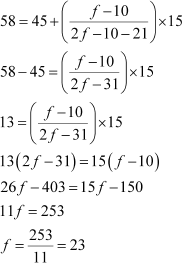
Thus, the missing frequency is 23.
3.Median of Grouped Data
Median of Grouped Data Using Cumulative Frequency Table
Let us consider a group of numbers such as 17, 12, 15, 20, and 14. We can easily find the median of the given numbers. To find the median, first of all, we arrange the terms in increasing order. Then, we will have the sequence as 12, 14, 15, 17, and 20.
Here, we have 5 observations and the middle term is the 3rd term i.e., 15.
We know that median is the middle most observation of the data. Therefore, we can say 15 is the median of the given group of numbers.
However, we face problems when the data is given in grouped form. In such cases, we cannot use the above method to find the median. The method to find the median in such cases is different from the above. Let us discuss the method by taking an example.
The following table shows the wages of 60 workers of a company. Let us find the median of wages of workers using this information.

Sometimes, the data is given as ‘less than type’ or ‘more than type’. In these cases, firstly we have to make cumulative frequency distribution table and then we can find the median using the same formula as in the previous example.
Let us discuss each of them briefly.
1. Less than Type
Let us consider the following table which contains the marks obtained out of 100 marks in an exam by the students of Grade 10 of a school.

To find the median of such data, first of all, we need to write the table in the form of class intervals and find the frequency of each class interval. The frequencies given for less than type table are cumulative frequencies. Now, the number of students obtaining marks in the class interval 0 − 10 is same as the number of students obtaining marks less than 10.
Therefore, the frequency of class interval 0 − 10 is 2. Now, the students obtaining marks less than 20 include the students of class interval 0 − 10 and 10 − 20. Therefore, frequency of class interval 10 − 20 = 6 − 2 = 4
Similarly, frequency of class interval 20 − 30 = 9 − 6 = 3
In this way, we can find the frequency of a class interval by taking the difference between the numbers of students of a group and its preceding group which is shown by the following table.

Since we have obtained the frequency distribution table, we can easily convert it into a cumulative frequency distribution table and follow the same method as we have studied in the beginning of this learning section. By doing so, we will easily find out the median of the given data.
2. More than Type
Let us consider the following table as the performance (in %) of taking calls by the customer care executives in a call centre.

To find the median of such data, first of all, we are required to write the table in the form of class intervals and find the frequency of each class interval. By looking at the given table, we write the class intervals of this data as 0 − 20, 20 − 40, 40 − 60, 60 − 80, and 80 − 100.
Now, the class more than 80 contains the customer care executives (C.C.E.) of class interval 80 − 100. Therefore, frequency of class interval 80 − 100 is 209. The class more than 60
contains the C.C.E. of class intervals 60 − 80 and 80 − 100. Therefore, frequency of class interval 60 − 80 = 585 − 209 = 376
Similarly, frequency of class interval 40 − 60 = 964 − 585 = 379
In this way, we can find the frequency of a class interval by taking the difference between the number of C.C.E .of a class and its following class as shown below.

Since we have obtained the frequency distribution table, we can easily convert it into a cumulative frequency distribution table and follow the same method as we have studied in the beginning. By doing so, we will easily find out the median of the given data.
Remember
• When a question is of more than or less than type, the cumulative frequency is always given.
• When the question is of more than type, the cumulative frequency is always in decreasing order.
• When the question is of less than type, the cumulative frequency is always in increasing order.
Let us solve some examples based on finding the median of less than type and more than type observations.
Example 1: The following table shows the literacy rate (in %) of 20 cities. Find the median literacy rate.

Solution:
The given table is of less than type. Therefore, the number of cities given in the table represents the cumulative frequencies. The frequencies and the class intervals are shown in the following table.

Here, number of observations, n = 20
![]()
The cumulative frequency greater than and nearest to 10 is 14.
∴ 40 − 50 is the median class.
l (lower limit of median class) = 40
h (class size) = 10
n (number of observations) = 20
cf = (cumulative frequency of the class preceding the median class) = 6
f (frequency of median class) = 8 Using the formula,
Median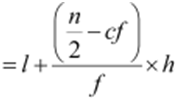
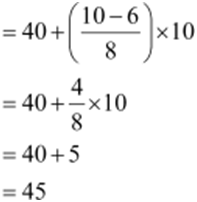
Therefore, 45% is the median literacy rate of 20 cities.
Example 2: If the median of the following distribution is 28.5, then find the value of x and y.

Solution:
First of all, we have to construct a cumulative frequency table.

It is given that n = 60
45 + x + y = 60
y = 15 − x … (1)
But, median = 28.5
i.e., median lies between the class interval 20 − 30.
Hence, median class = 20 − 30
Therefore, we have
l = 20, f = 20, cf = 5 + x, h = 10, and![]()
It is given that the median is 28.5.
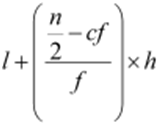 = 28.5
= 28.5
20 + ![]() = 28.5
= 28.5
20 + ![]() = 28.5
= 28.5
![]()
65 − x = 57
x = 65 − 57 = 8
Putting this value in equation (1), we obtain
y = 15 − x
y = 15 − 8 = 7
Hence, x = 8 and y = 7
Example 3: The following table shows the heights of buildings of a city. Find the median height.

Solution:
The given table is of more than type. Therefore, the number of buildings given in the table represents the cumulative frequencies. The frequencies and the class intervals have been shown in the following table.
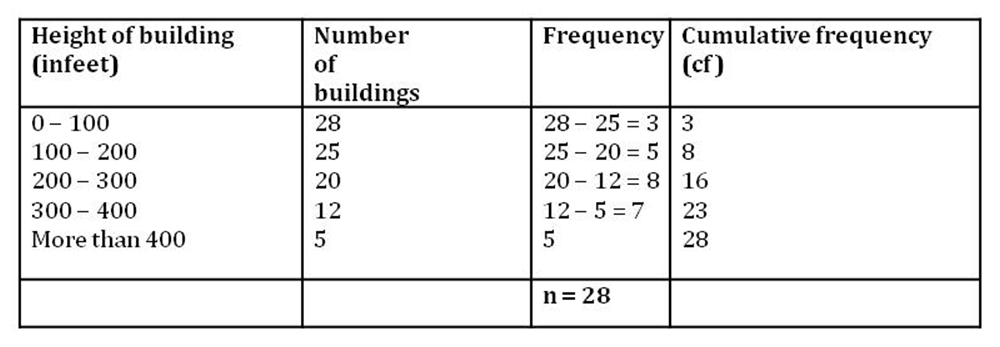
Here, n = 28
![]()
The cumulative frequency which is greater than and nearest to 14 is 16.
∴ 200 − 300 is median class.
We also have,
l (lower limit of median class) = 200
h (class size) = 100
n (number of observations) = 28
cf = (cumulative frequency of the class preceding the median class) = 8
f (frequency of median class) = 8 Using the formula, we have
Median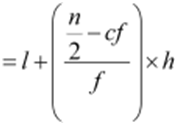
![]()
= 200 + 75
= 275
Hence,275 feet height is the median height.
Example 4: Lowest temperature of the day of a metro city was recorded for 30 consecutive days and the results are shown below:

Find the median lowest temperature.
Solution:
It can be observed that the class intervals in the given table are of inclusive type, so we need to convert them to exclusive type so that we can get continuous class intervals. Here, the difference between upper limit of a class and lower limit of next class is 0.1. On dividing this difference by 2, we get 0.05 which can be added to every upper limit and subtracted
from every lower limit to get new limits. These limits are known as class boundaries. Using these class boundaries, we can prepare cumulative frequency distribution table and thus, we can get continuous frequency distribution.
The new table can be prepared as follows:
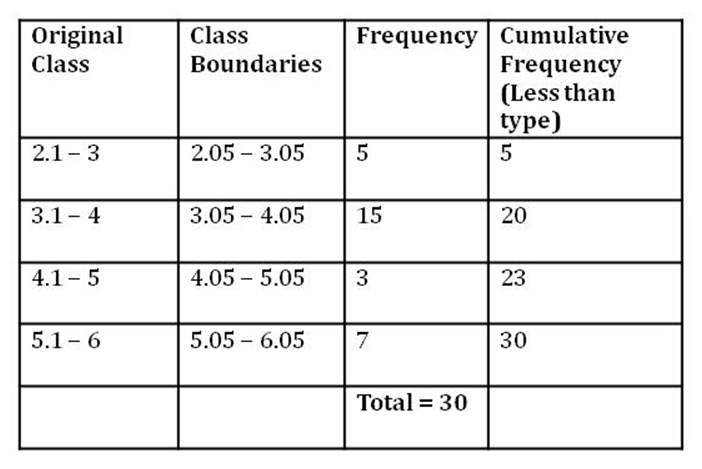
Here, n = 30
![]()
The cumulative frequency which is greater than and nearest to 15 is 20.
∴ 3.05 − 4.05 is median class. We also have,
l (lower limit of median class) = 3.05
h (class size) = 1
n (number of observations) = 30
cf = (cumulative frequency of the class preceding the median class) = 5
f (frequency of median class) = 15
Using the formula, we have
Median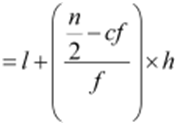
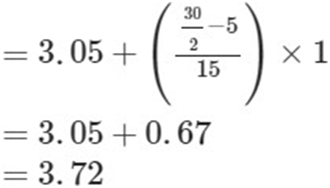
Hence, 3.72 °C is the median lowest temperature.
Median Of A Grouped Data By Constructing Ogive
A pictorial representation always gives a better understanding than a written statement. A graphical representation helps us in understanding of a given data in an easier and detailed manner. In order to understand the median of a grouped data properly, we have to draw an ogive.
Firstly, let us discuss what is an ogive?
“When the data is given as ‘less than’ or ‘more than’ type and a graph is plotted between either of the limits and the cumulative frequency, the smooth curve so obtained is known as ogive or cumulative frequency curve”.
Let us discuss with an example that how an ogive is helpful to find out the median of a grouped data.
Let us consider that 80 students of a class appeared in a Geography test. The marks obtained (out of 100) by them are given in the following frequency distribution table.
Table - 1
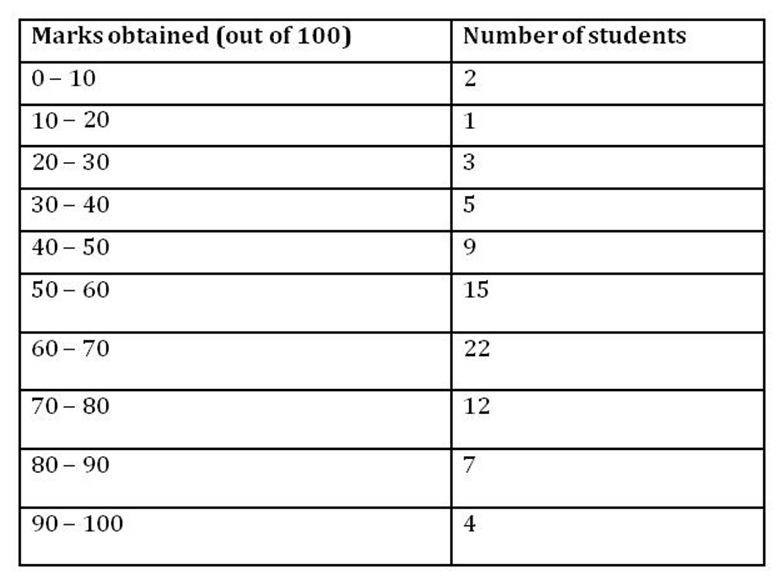
We can write the above table in following two ways.
1. Less than type
2. More than type
1. For less than type
We can write the given table in less than type as follows.
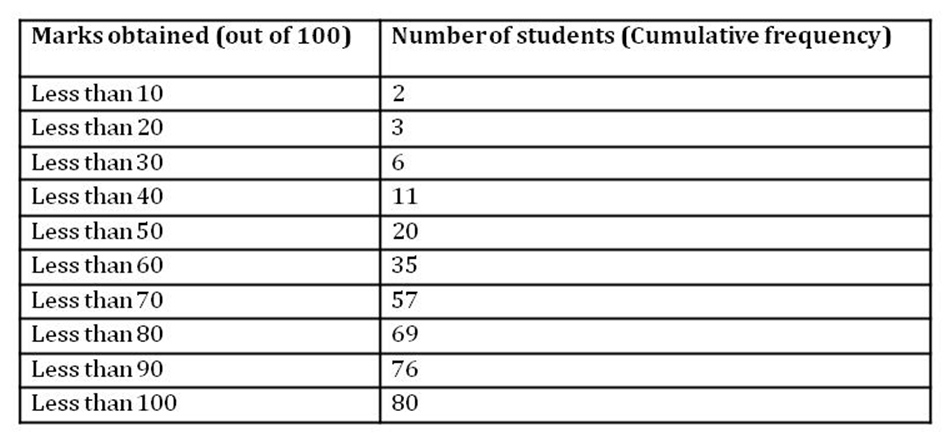
Construction of Ogive of less than type
The smooth curve drawn between the upper limits of class intervals and cumulative frequency is called cumulative frequency curve or ogive (of less than type). The upper limits of the intervals and cumulative frequency are shown in the above table.
The method of drawing an ogive of less than type is as follows.
1. Firstly we draw two perpendicular lines, one is horizontal (x-axis) and the other is vertical (y-axis), on a graph.
2. Now, we mark the upper limits on the horizontal line and the cumulative
frequencies on the vertical line by taking suitable scale.
(3) After this, we plot the points (10, 2), (20, 3), (30, 6), (40, 11), (50, 20), (60, 35), (70, 57),
(80, 69), (90, 76), (100, 80). These are the points corresponding to the upper limit and the cumulative frequency.
(4) Now, we join these points to obtain a smooth curve.
After following these steps, we obtain the following graph.
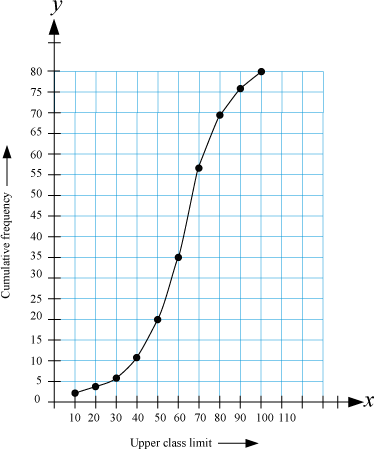
The smooth curve obtained in this figure is the ogive of less than type of the given data.
To find the median with the help of ogive
An important application of ogive in statistics is to find the median.
Let us see the method of finding the median through the same example. In the previous example, number of observations, n = 80

Mark the point 40 on the vertical line and then draw a horizontal line through this point. Let this horizontal line intersect the ogive at point A. Now, draw a vertical line through A. Median is the point at which this vertical line intersects the horizontal line.
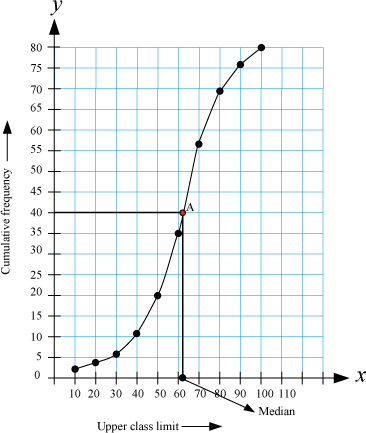
In this example, the median is 62 (approximately).
2. For more than type
We can write the given table for more than type as follows.
Marks obtained
Number of students (Cumulative frequency)
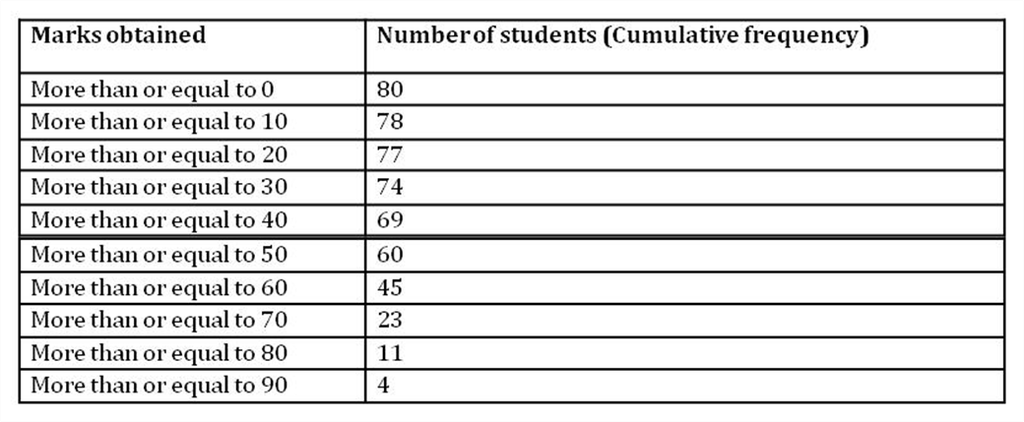
Construction of Ogive of more than type
The smooth curve drawn between the lower limits of class intervals and cumulative frequencies is called cumulative frequency curve or ogive (for more than type).
The method of construction of more than type ogive is same as the construction of less than type. For more than type ogive, we take the lower limits on x-axis and the cumulative frequencies on the y-axis. In the above table, the lower limits and the cumulative frequencies have been represented.
The ogive of more than type is obtained by plotting the points (0, 80), (10, 78), (20, 77),
(30, 74), (40, 69), (50, 60), (60, 45), (70, 23), (80, 11), (90, 4).
The ogive of more than type of the previous table has been shown below.
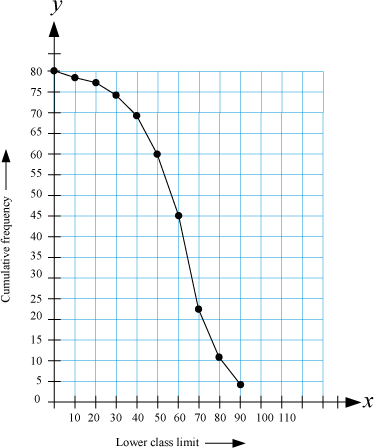
To find the median with the help of ogive
Number of observations, n = 80

Mark the point 40 on the vertical line and then draw a horizontal line from this point. Let this line intersect the ogive at point A. Now, draw a vertical line through A. Median is the point at which this vertical line intersects the horizontal line.
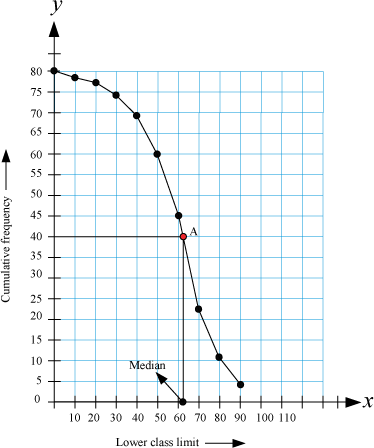
Hence, the median is 62(approximately).
Relation between the ogive of less than type and more than type
Let us draw the graph of both less than type and more than type on the same graph paper.
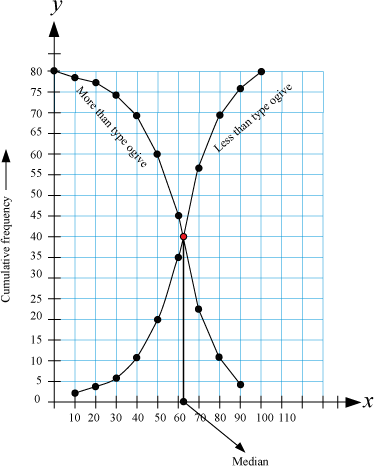
We observe from the above graph that,
“If we construct a line parallel to y-axis through the point of intersection of both the ogives i.e., of less than type and more than type, then the point at which this line intersects x-axis represents the median of the given data”.
Let us solve some more examples to understand the concept better.
Example 1: The following distribution table gives the daily wages of 50 workers in a factory.

Convert it into a less than type distribution and draw its ogive. Solution:
We can write the given distribution table as a less than type distribution as follows.
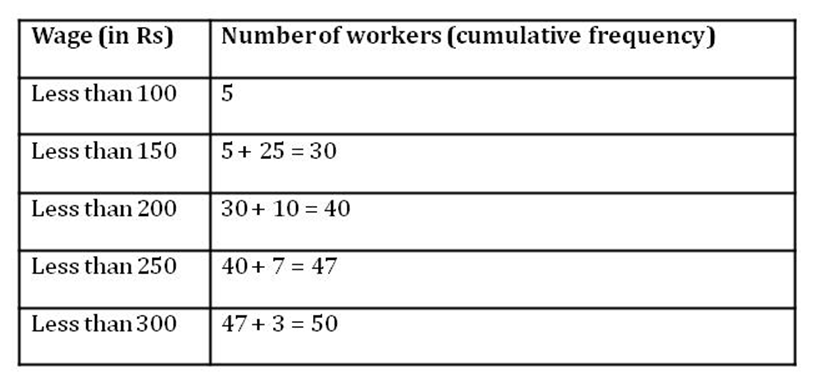
To obtain the ogive, we have to plot the points (100, 5), (150, 30), (200, 40), (250, 47), (300, 50) on a graph paper taking the upper limits on x-axis and the cumulative frequencies on y-axis.
The ogive obtained has been represented in the following figure.
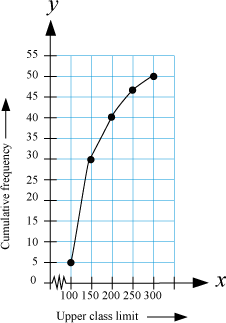
Here, n = 50
∴
First, we mark the point 25 on the vertical line and then draw a horizontal line through this point. Let this horizontal line intersect the ogive at point A. Now, draw a vertical line through point A. Median is the point where this vertical line intersects the x-axis. In this case, the value comes out to be 140. Hence, 140 is the median of the given distribution table.
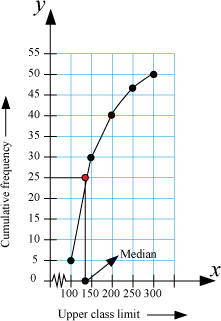
Example 2: The following table shows the total monthly household expenditure of 100 families in a city.

Convert it into a more than type of distribution and draw its ogive.
Solution:
We can write the given table in more than type as follows.
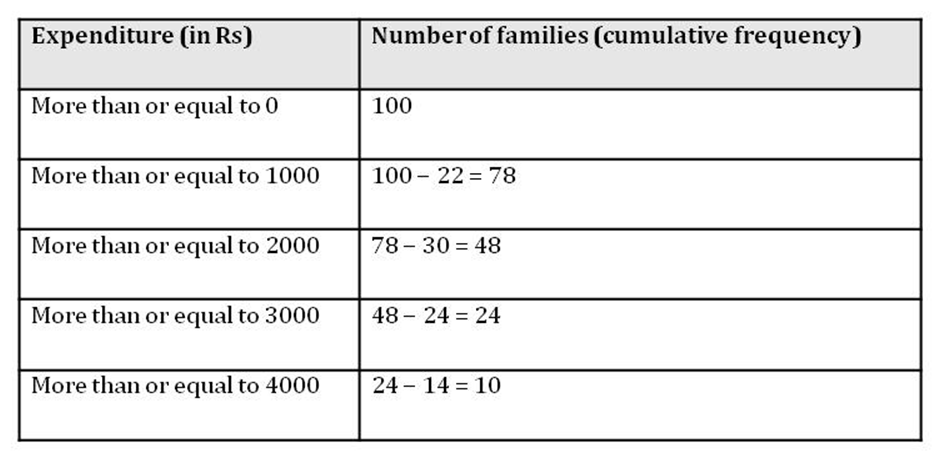
Now, we plot the points (0, 100), (1000, 78), (2000, 48), (3000, 24), (4000, 10) on a graph paper to obtain the ogive of more than type distribution.
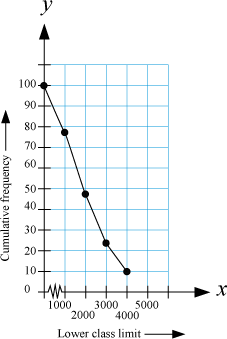
Example 3: The following table shows the rainfall (in mm) in 60 cities on a particular day.

Draw both the ogives for this data on the same graph paper and find the median. Solution:
In the given table, the class intervals are of inclusive type, so we need to make them of exclusive type first. Now, a common table can be prepared for less than type and more than type cumulative frequencies to draw both the ogives on the same graph paper.
The table is given below.
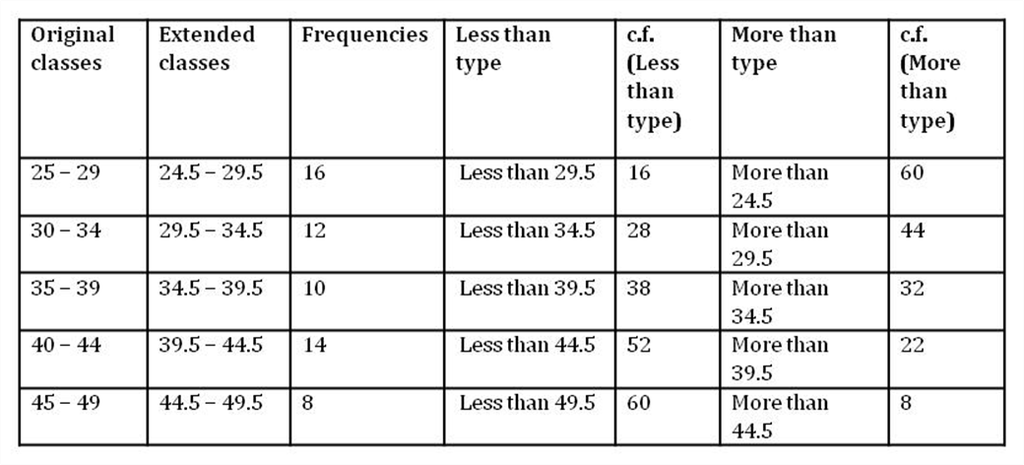
Now, we plot the points (29.5, 16), (34.5, 28), (39.5, 38), (44.5, 52), (49.5, 60) on a graph paper to obtain the ogive of less than type distribution.
Also, we plot the points (24.5, 60), (29.5, 44), (34.5, 32), (39.5, 22), (44.5, 8) on the same graph paper to obtain the ogive of more than type distribution.
The graph is shown below:
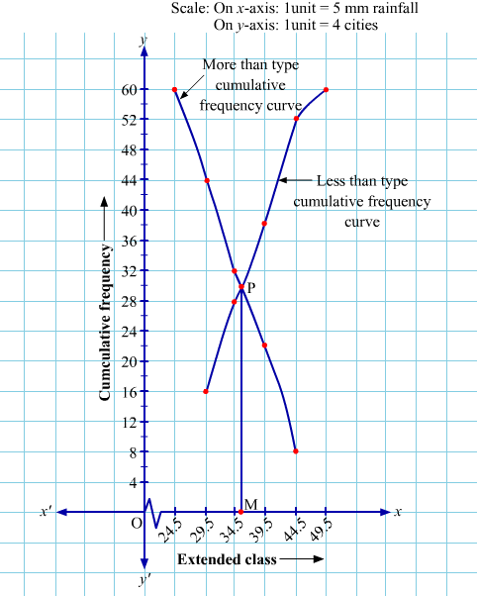
Point M represents the median which is approximately 36.
Relation Between Mean, Median, And Mode
We have studied three measures of central tendency - mean, median, and mode. But do you know that there is an empirical relationship between these three measures.
The relation between them is given by

or
![]()
We can use this relationship to find the value of any of them, when the other two are known. It can also be used to check if the values of the three central tendencies obtained are correct or not as they will satisfy this relation. However, this relation is not always true.
First of all, let us verify it by taking an example.
Example: The following data shows the numbers of days for which the patients were hospitalized.
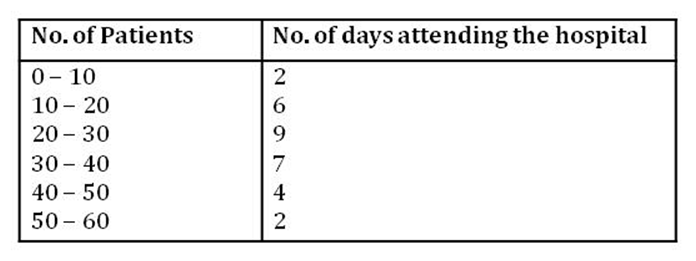
Justify the relationship between mean, median, and mode of the given data. Solution:
To verify the relation between mean, median, and mode, we have to find out their values from the given data and then substitute them to see the authenticity of the relationship.
Firstly, let us find the mean of the given data.
Mean
To find out the mean, we construct the following table.

We know that, Mean =
=
Now, let us find the mode of the given set of data.
Mode
In the given table, 20 − 30 is the modal class as this group has the maximum frequency. From the table,
l = 20 (Lower limit of the modal class)
h = 10 (Class size)
f1 = 9 (Frequency of the modal class)
f0 = 6 (Frequency of the class preceding the modal class)
f2 = 7 (Frequency of the class succeeding the modal class)
Now, Mode =
Mode
 Mode = 26
Mode = 26
Median
To find out the median, we construct the following table.

Here, n = 30
 ∴
∴
The cumulative frequency greater than 15 is 17.
Hence, the median class is 20 − 30.
From the table,
l = 20 (Lower limit of median class)
cf = 8 (Cumulative frequency of class preceding the median class)
f = 9 (Frequency of median class)
h = 10 (Class size of the groups)
Now, Median
Median =
Median =
Now, Mode + 2 Mean = 26 + 2 ×
= 26 +
=
But, 3 Median = 3 × =
=  = Mode + 2 Mean
= Mode + 2 Mean
Hence it is verified that,
3 Median = Mode + 2 Mean
Let us go through few more examples to learn the application of the concept.
Example 1: For a certain frequency distribution, mean and median are obtained as 123.5 and 127 respectively. What is the value of mode?
Solution:
We have the relation
3 Median = Mode + 2 Mean
⇒ 3(127) = Mode + 2(123.5)
⇒ 381 = Mode + 247
⇒ Mode = 381 – 247
⇒ Mode = 134
Example 2: For a certain frequency distribution, median and mode are obtained as 55 and 70 respectively. What is the value of mean?
Solution:
We have the relation
3 Median = Mode + 2 Mean
⇒ 3(55) = 70 + 2 Mean
⇒ 165 = 70 + 2 Mean
⇒ 2 Mean = 165 – 70
⇒ 2 Mean = 95
⇒ Mean = 47.5
Example 3: For a certain frequency distribution, mean is 6 more than mode. Find the relation between median and mode.
Solution:
It is given that
Mean – Mode = 6 ...(1) We have the relation
Mean – Mode = 3(Mean – Median)
⇒ 6 = 3(Mean – Median)
⇒ Mean – Median = 2 ...(2)
On subtracting (2) from (1), we get Mean – Mode – (Mean – Median) = 6 – 2
⇒ Mean – Mode – Mean + Median = 4
⇒ Median – Mode = 4
Thus, median is 4 more than mode.
2.Construction of Circles
Construction Of Tangents To A Circle From A Point Outside The Circle
We know that a tangent is perpendicular to the radius through the point of contact. Therefore, if we want to draw a tangent at a point of a circle, we have to simply draw the radius through that point and draw a line perpendicular to that radius. It will be the required tangent at that point.
However, we do not follow this method, when a point lies outside the circle. This is because we do not know at which point on the circle the radius should be drawn so that the line joining that point and the point outside the circle is perpendicular to the radius.
Example 1: Draw a pair of tangents to a circle of radius 4 cm from a point outside the circle such that the tangents are inclined at an angle of 70°.
Solution:
We can draw the tangents using a property of circles. It is given that the tangents are inclined at an angle of 70°. Therefore, the radii joining the points of contacts to the centre of the circle are inclined at an angle of 110° as shown in the figure.
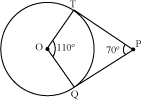
Firstly, let us draw a circle of radius 4 cm with the help of ruler and compasses. Let O be the centre of the circle.

We draw a radius OT of the circle. Now we draw another radius OQ making an angle of 110° with OT.

Now, we draw lines perpendicular to OT and OQ at points T and Q respectively. Let these two perpendicular lines intersect each other at a point P.
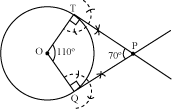
Thus, PT and PQ are the required tangents that are inclined at an angle of 70°.
Example 2: Draw a pair of tangents from point P to the given circle.

Solution:
In the given figure, the centre of the circle is not given. Therefore, first of all, we will find the centre of the circle.
For this, let us draw two non-parallel chords of the circle and draw their perpendicular bisectors. The point of intersection of these perpendicular bisectors is the centre O of the circle.
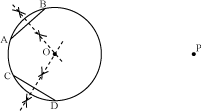
Now, we join the line segment OP and draw its perpendicular bisector. Let this perpendicular bisector intersect OP at point M.
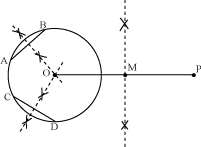
Then we draw a circle with radius equal to OM taking M as centre. Let this circle intersect the given circle at points T and Q. We join PT and PQ.
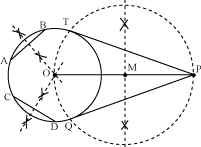
Thus, PT and PQ are the required tangents from a point P outside the circle.

 Carrier Point
Carrier Point
 Success Academy
Success Academy
 ACERISE INDIA
ACERISE INDIA


